LandEscape

WEN YU
BETTE RIDGEWAY
NORMA ALONZO
prOphecy sun
LIOR HERCHOVITZ
GEORGE GOODRIDGE
LINDA PERSSON
SNOW YUNXUE FU
LINDA PERSSON
ART A r t R e v i e w
Anniversary Edition , a work by
George Goodridge


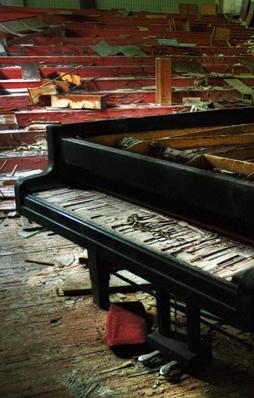

USA
For over more than a decade Herchkovitz's subject matters are varied, but the essence is the same. Whether his themes come in a series or tableaux, he works with clear intention to examine the complex of human condition; man's interference with nature and the vulnerability of mankind. Much of Lior Herchkovitz's work reminiscent of film stills and conditioned by the simultaneous emphasis on narrative structure, photographic sequences and on themes, while in other works is tackling the relationship of photography to painting. Herchkovitz is less concerned with beauty as commonly perceived, but rather fascinated by a perceptible discrepancy between the visible surface and the psychological content, presented subtly that no information gets lost, and thus lends some of these works an ambivalent atmosphere followed with tension and unease.
Consciously or not, everyone has a relationship to a maternal structure. As psychologist Bracha L. Ettinger states, we all hold within us an imprint or memory of being carried –carried across landscapes, across time, into destinations unknown (Ettinger, 1992). Or, as phenomenological philosopher Merleau-Ponty suggests, everyone is a worldbody relation. My research takes up these ideas alongside what theorist Jane Bennett calls vibrant objects (Bennett, 2009), across thresholds, into domestic geographies, focusing on the subjective experiences of motherhood and the artistic and critical discourse that surrounds it. Referencing recent traditions of Art Interventions, Performance Art, and Land Art, my work considers how the body responds to the agency of things in the world. Over the last four years, I have been creating work with weather balloons – high altitude objects used to carry scientific instruments into the troposphere to send back information about atmospheric pressure, temperature, and wind speed. Instead of releasing it into the sky however, I engage the balloon in an uncanny duet, and use the weather balloon as a metaphor for motherhood.
Throughout my career, I have tried to produce unique and meaningful works that are both timely and playful. My works may question diversity, visual kinetics, identities, object-toobject relationships and real world concerns. Many of my sculptural works should be thought of as both figurative and nonrepresentational while blurring the lines between sculpture, painting, architecture and installation. I tend to make works that can be translated in multiple ways that question rather than arrive at specific conclusions. Being dimensions variable these installations have no specific formula for installation. These open ended offerings can and will be translated differently depending on the viewers past experiences and the installation’s sight specific parameters. While many of my works on paper are concerned primarily with visual kinetics, form and color, my sculptural works approach concerns with identity and object to object relationships with underlying sociological references.

Beth Krensky is an associate professor of art education and the Area Head of Art Teaching at the University of Utah. She is an artist, activist and educator. She received her formal art training from the Boston Museum School. She has exhibited widely throughout the United States and internationally. She is a founding member of the international artist collective, the Artnauts. Her work is intended to provoke reflection about what is happening in our world as well as to create a vision of what is possible. She is also a scholar in the area of youth-created art and social change. She received a master’s degree with a focus on critical pedagogy and art education from the Harvard Graduate School of Education and a Ph.D. in Education from the University of Colorado at Boulder. She co-founded and spent a decade as Artistic Director for the award-winning youth arts/service/action organization, Project YES (Youth Envisioning Social change). Her co-authored book, Engaging Classrooms and Communities through Art: A Guide to Designing and Implementing Community-Based Art Education, was published by AltaMira Press in 2009.


Wen Yu USA

My paintings feature abstract cityscapes that capture my vision of ongoing urbanization through exploring both the composition and the relationship between different layers. Growing up in Suzhou, China, I witnessed radical changes in my hometown as it has developed from an ancient city to a contemporary business hub. However, reminiscing about the traditional architecture in Suzhou still remains in my mind. After moving to San Francisco over three years ago, the post- modern architectures (de Young Museum, MOMA, Contemporary Jewish Museum) are further inspired my interests in geometric shapes. The urban life experience in the two cities enables me to mirror a city’s transformation. It stays with me, and come alive in my paintings where I shape them on the canvas. My original inspiration was a combination of Bach’s fugues, traditional Chinese gardens in Suzhou and structural elements of post-modern architectures. The visual language (repetition elements) of those architectures becomes a rhythm. Inspired by Bach’s music that I practiced in my childhood on the piano, I imbued the idea of musical score into my work as a way to see the architectural rhythm.
Snow Yunxue Fu’s artwork approaches the subject of the Sublime using topographical computer rendered animation installations. She examines and interprets the world around her through digital reality, where she draws a parallel to the realms of the physical, the virtual, the metaphysical, and multi-dimensionality. Modeling her animations on the allegorical paintings of Casper David Fredrich, Fu continues her aspirations in the sublime from her painting background into experimental digital media, exploring the nature of physical and metaphysical limits, as the work also mirrors the fundamental aspect of Chinese Traditional Landscape Painting, which often presents a type of virtual reality where the significance of the individual and linear perspective is blurred into a voluminous landscape. Extending out from the pictorial, Fu’s installation work engages in a metaphoric relationship with physical perception, by which the sublime is framed and the viewer is invited to enter into a liminal interior within a digitally constructed realm.

SUMMARY C o n t e m p o r a r y A r t R e v i e w Special Issue
Ilinca Bernea Romania
Snow Yunxue Fu USA
Lior Herchkovitz Israel
scape Land CONTEMPORARY ART REVIEW E
Norma Alonzo USA
Norma Alonzo has always taken her painting life seriously, albeit privately. An extraordinarily accomplished artist, she has been painting for over 25 years. Beginning as a landscape painter, she quickly transitioned to an immersion in all genres to experiment and learn. Initially, Alonzo was torn between professions - the arts or a career in architecture. She chose the arts, graduating from San Jose State University in San Jose, California with a degree in Interior Design. After working in this field and ultimately heading her own design firm, her focus turned to the creation of fine art.

Under the mentorship of Richard Lees (artist and art historian of Pasadena, California), Alonzo was encouraged toward honesty in her painting without judgment, without expectation, and without the confines of outside demanding interests. Through her paintings, Alonzo examines our place, metaphysically and functionally, in the midst of today’s fast-paced world. For Alonzo, it has been a year of painting dangerously. Experimentation with the formal elements of line, form, mass and texture are now in play. More importantly, the guiding principle is fearlessness in the use of color and space.
My thinking and making goes through different materials and processes and i am, by putting my body in motion to go to places and landscapes given experiences, by actually moving, and that is quite a radical thing in itself, and this forms my visual output. I pick up on things related to our senses like smell, light and dark, dry or moist sonic atmosphere, which are all deeply sensorial and experiential. It's not just about responding to the things already in existence but bring to front the absence in the produced world. This can create hard-tofollow image sequences or mediums chosen, yet it, if successful, can create curiosity or better; a sense of euphoria. Our world shrieks of mobility, interaction, exchange, flexibility however it only applies to a fair few, but mainly it applies to money. Actual moving bodies has created new walls to be built, harsher entries and exits of and into certain countries. My relation and use of material goes hand in hand with my movements. The 'immateriality' of the world is highly material, everything connected to immaterial labour and its affect is rooted in the use of the digital domain, internet and so on.
Ridgeway USA

Pushing the boundaries of light, color and design, Bette Ridgeway is best known for her large- scale, luminous poured canvases, which have garnered the artist international recognition. Bette Ridgeway was born in Tupper Lake, a small village in the Adirondack Mountains in New York (a few miles from the Canadian border). Inspired by the pristine and expansive beauty of this 6 million square mile natural habitat, she began drawing and painting as a young child. At 13, she enrolled in watercolor landscape painting and figure drawing classes at the Albany Institute of History and Art, Albany, NY, where the Hudson River School artists, the Impressionists and the work of Pablo Picasso thoroughly captivated her young artist’s imagination. Ridgeway went on to study the visual arts with an emphasis on graphic design at Russell Sage College in Troy, NY. At the same time, based on her portfolio submission, she was hired as a professional designer at Reuben H. Donnelley Advertising Corporation in Albany, NY. She discovered that the Donnelley Corporation could offer, with its on-thejob training, far more training than any college. “This was my art “boot camp,” says the artist. Ridgeway also attended classes at the School of Interior Design Art and the Art Students League, New York City, NY. She then struck out across the globe - studying, painting, teaching and exhibiting her work, while simultaneously immersing herself in the customs and colors of the diverse cultures of Africa, Australia, Europe, Asia, Mexico and South America. She studied and taught painting during lengthy stays in Antanarivo, Madagascar; Canberra, Australia; and Santiago, Chile.
On
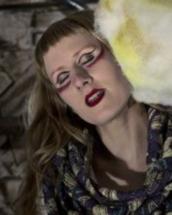


Krzysztof

4 30 prOphecy sun lives and works in Canada Norma Alonzo lives and works in USA Bette Ridgeway Lives and works in Santa Fe, New Mexico, USA Wen Yu lives and works in Boston, MA, USA Linda Persson lives and works in Swededn and in the UK Snow Yunxue Fu lives and works in Chicago, USA Ilinca Bernea lives and works in Romania George Goodridge lives and works in the United States Lior Herchkovitz lives and works in Tel Aviv, Israel 54 78 106 128 154 180 206 Special thanks to Haylee Lenkey, Martin Gantman,
Kaczmar, Joshua White,
Vionnet, Genevieve
Petroff, Sandra Hunter, MyLoan Dinh, John Moran,
Vyrra, Gemma Pepper, Michael Nelson,
Hiaseen and Scarlett Bowman, Yelena York Tonoyan,
Gantman, Krzysztof Kaczmar and
Nicolas
Favre
Marya
Hannah
Haylee Lenkey, Martin
Robyn Ellenbogen.
SUMMARY
the cover , a work by
Bette
prOphecy sun Canada
Special Issue scape Land CONTEMPORARY ART REVIEW E
Linda Persson Sweden / United Kingdom
prOphecy sun
Lives and works in Vancouver, Canada
Consciously or not, everyone has a relationship to a maternal structure. As psychologist Bracha
L. Ettinger states, we all hold within us an imprint or memory of being carried – carried across landscapes, across time, into destinations unknown (Ettinger, 1992). Or, as phenomenological philosopher MerleauPonty suggests, everyone is a world-body relation. My research takes up these ideas alongside what theorist Jane Bennett calls vibrant objects (Bennett, 2009), across thresholds, into domestic geographies, focusing on the subjective experiences of motherhood and the artistic and critical discourse that surrounds it. Referencing recent traditions of Art Interventions, Performance Art, and Land Art, my work considers how the body responds to the agency of things in the world.
Over the last four years, I have been creating work with weather balloons – high altitude objects used to carry scientific instruments into the troposphere to send back information about atmospheric pressure, temperature, and wind speed. Instead of releasing it into the sky however, I engage the balloon in an uncanny duet, and use the weather balloon as a metaphor for motherhood. For example, weather balloons are carried across varied terrain, negotiating
References
and activating the landscape, while offering another lens for how we perceive, pull and weave consciousness into daily rituals. Through these actions the balloon exists independently and has its own desire, and quietly alludes to the complexities of the maternal relationship.
Two pieces that embody the current focus of my work are the multi-channel video installations Traces of Motherhood (2016), Objects Wrapped in Dreams Wrapped in Objects (2015), both artworks allude to the mother child relationship, time and the technological unconscious (Mitchell et al., 2010) and our ability to perceive different forms of media that are visual, aural, and tactile. To date, I have experimented with several sizes of weather balloons in both conventional and contested outdoor landscapes and projected those experiments onto surfaces that include public stairwells, sprinkler pipes, metal walls, poly-fill clouds, concrete floors, windows, doors and other challenging architectural features. And, through the layering of multiple projections and sound compositions, the fluidity of common areas become spaces of contention, condensed spaces where the object, the audience, the installation, and our movement bypass clear meaning.
Bennett, Jane. Vibrant matter: A Political Ecology of Things. Duke University Press, 2009.
Ettinger, Bracha Lichtenberg. "Matrix and metramorphosis." Differences: A journal of feminist cultural studies 4.3 (1992): 176-209. Mitchell, WJ Thomas, and Mark BN Hansen, Eds. Critical Terms for Media Studies. The University of Chicago Press, 2010.
An artist's statement
CONTEMPORARY ART REVIEW
scape Land
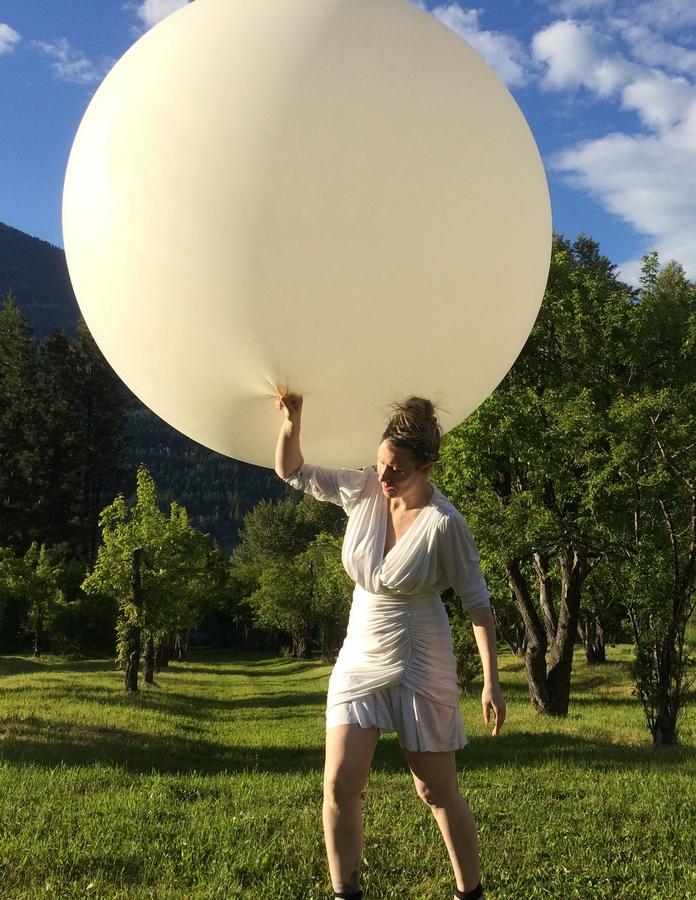 Photo by Darren Fleet
Photo by Darren Fleet
LandEscape meets
prOphecy sun
Vancouver based artist prOphecy sun’s work rejects any conventional media and addresses her spectatorship to such captivating multilayered experience: focusing on multi-channel video installations, her practice inquires into the notions of the mother child relationship, time and the technological unconscious and our ability to perceive different forms of media that are visual, aural and tactile. Her body of works that we'll be discussing in the following pages utilizes both traditional heritage and unconventional sensibility to trigger the viewers’ and readers’ perceptual parameters. The power of prOphecy sun’s noetic approach lies in her incessant exploration of how the body responds to the agency of things in the world. We are very pleased to introduce our readers to her stimulating and multifaceted artistic production.
Hello prOphecy sun and welcome to LandEscape. We would start this interview with a couple of questions about your multifaceted background. You have a solid formal training and you are pursuing your PhD at the School of Interactive Arts +
Technology at Simon Fraser University: how does this experience influence the way you currently conceive and produce your works? And in particular, how does your cultural substratum inform the way you relate yourself to art making?
My interdisciplinary practice draws from academic and non-academic sources: dreams, contemporary art, philosophy, psychology, storytelling, and modern dance. My perspective changes and evolves with each and every project, collaboration and artwork that I make. I often work on multiple works in tandem as each piece feeds off one other.
My research and creative process has evolved since undertaking my doctoral degree. I have collaborated with other Graduate students at Simon Fraser University on several innovative works with Moving Stories, a collaborative research project that studies dance, movement, performance, interaction and digital technologies. Fractured Perspectives: Movement and Light (2017) experiments with virtual and physical realms, video, fragmented perspectives, improvisational movement, 360° camera technology, multiple traditional cameras, tangible props, artificial intelligence based painterly abstraction processing, and processed vocal
scape Land CONTEMPORARY ART REVIEW
An interview by Katherine Williams, curator and Josh Ryder, curator landescape@europe.com
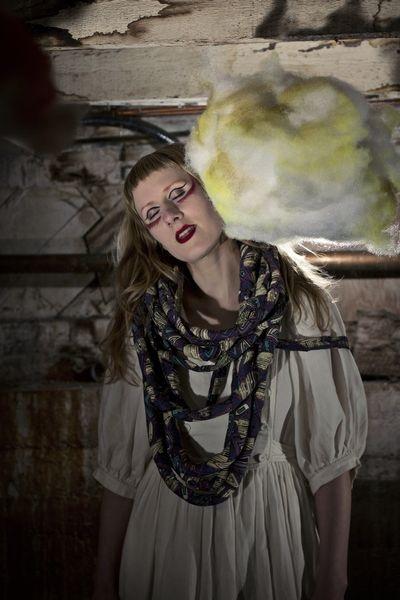 Photo by Victoria Johnson
Photo by Victoria Johnson
soundscapes (see https://vimeo.com/225170727).

You are a versatile artist and we would suggest to our readers that they visit https://vimeo.com/prophecysun/about in order to get a synoptic view of your work. While walking our readers through your process ranging from experimental performances and sound compositions to installations and videos, your approach is marked out with a stimulating multidisciplinary feature and reveals that you are a versatile artist capable of crossing from a medium to another: how do you select the medium to express the idea that you explore? In particular, when do you recognize that one of the mediums has exhausted it expressive potential to self?
Lucid dreaming has been part of my practice for over twenty years. I believe that dreams can offer a rich source of images, sounds and impressions that can be harnessed for artistic purposes. I begin my process by keeping a log of lucid dreams, visions and events and interpret these remnants into art works. Coupled with observations from waking experience, dreams provide another layer and method for making art.
In particular, I have found dream spinning and concentrating on the sounds and rhythms of breathing to be especially effective in producing lucid dreams. Intrigued by things I see and hear in the dynamic and generative world of dreams, I work with this imagery to create several projects in various mediums, in tandem, at the same time. I find that each piece stimulates, feeds, reflects, and invigorates the growth of the other. When a piece feels
prOphecy Sun scape Land CONTEMPORARY ART REVIEW

prOphecy sun scape Land CONTEMPORARY ART REVIEW
Photo by Darren Fleet

prOphecy Sun scape Land CONTEMPORARY ART REVIEW
Photo by Darren Fleet
finished, I move onto the next. I trust my intuitive process and often let the concept, movement, and imagery lead me into a realized piece of art.
My investigations into dream research offers an understanding of the basic components of dreams that highlight their influence as a vital, sustaining resource that deepens the connection between my work and my life.
For this special edition of LandEscape we have selected Traces of Motherhood, a 3-channel installation that can be viewed at https://vimeo.com/237473146 and that our readers have already started to get to know in the introductory pages of this article. What has at once captured our attention of your insightful inquiry into the mother child relationship is the way you have provided the visual results of your with such autonomous aesthetics. When walking our readers through the genesis of Traces of Motherhood would you shed light about your usual process and set up? In particular, why did you choose to focus on the theme of the complexities of the maternal relationship?
Over the last four years, I have been creating work with weather balloons – high altitude objects used to carry scientific instruments into the troposphere to send back information about atmospheric pressure, temperature, and wind speed. Instead of releasing it into the sky however, I engage the balloon in an uncanny duet.
I use smartphone technologies to document actions, sounds and investigations in the moment to investigate the relationship between dream states, the body and objects. This technology is responsive to improvisation.

prOphecy sun scape Land CONTEMPORARY ART REVIEW
It has manageable limits and parameters, allowing for solitary and self-reliant pre and post-production. The video and editing quality reflects the desired immediacy of the performance as well as evoking a dream like aesthetic through its “lo fi” properties.
I chose to focus on the theme of motherhood because I believe that everyone has a relationship to a maternal structure or a memory of being carried –carried across landscapes, across time, into destinations unknown (Ettinger, 1992). Further, I believe that mothering is a daily,

prOphecy Sun scape Land CONTEMPORARY ART REVIEW
Photo courtesy of the artist prOphecy sun
meditative, and transformative experience that can shift ones identity, and offer audiences enormous insight into that personal change. Yet, mothering remains often socially invisible (Maushart, 2000, 105). My research takes up these ideas alongside what theorist Jane Bennett calls
vibrant objects (Bennett, 2009), across thresholds, focusing on the subjective experiences of motherhood and the artistic discourse that surrounds it.
My immersive 3-channel installation Traces of Motherhood (2016) features a female

prOphecy sun scape Land CONTEMPORARY ART REVIEW
protagonist navigating a fragile weather balloon through an outdoor environment. What arises to the surface of this work is a series of unconscious choreographies relating to the nurturing imprint of birth using a weather balloon as a metaphor for motherhood.
The ambience of Traces of Motherhood provides the viewers with an immersive experience and brings the notion of landscape to a new level of significance, evoking an atmosphere that reminds us of the idea of non-lieu elaborated by French anthropologisanthropologist Marc Augé. How would you describe the role of the landscape in your work? And in particular, how did you select the location for Traces of Motherhood?
I see much potential in earthly bodies affecting one another. My work explores how to be in relation with objects in a way that does not privilege a human centric point of view. In my investigations I move with various sized inflatables through indoor and outdoor landscapes to reveal this vibrancy of subject and object by appearing sometimes as the subject, and sometimes as the object. Overtime the landscape and my bodily movement bypass clear meaning.
Traces of Motherhood (2016), is composed of simple task-like movements, improvisations, random sequences and the repetitive gestures of moving with a weather balloon and a small child moving through an expansive field. The piece experiments with a single perspective, shot in an idyllic, lush, meadow-like landscape, back dropped alongside a dramatic skyline.
The location was chosen because it offered an expansive sightline ideal for explorations and movements outdoors in order to shift and transform the inner sense of self using Butoh techniques, shape, environmental forces and self-reflexivity to guide my movement patterns and then follow the lead of the inflatable balloon.
Objects Wrapped in Dreams Wrapped in Objects features such stimulating choreography that to investigates the elusive relationship between between realms of experience and consciousness. We like the way this captivating work addresses the viewers to a wide number of narratives: rather than attempting to establish any univocal sense, you seem to urge the viewers to elaborate personal associations: when discussing about the role of randomness in your process, would you tell us how much important it is for you that the spectatorship rethink the concepts you convey in your pieces, elaborating personal meanings?
I hope that an audience will see my experiments as liberations from convention. I want the viewer to bridge realms, to feel something, be enticed and welcomed into another conscious and unconscious space, both felt and embodied, and provoke a dreamlike encounter between interior vibrations and exterior reverberations. Through the layering of multiple projections and sound compositions the space becomes occupied in new ways.
Sound plays a crucial role in your artworks, providing Objects Wrapped in Dreams
Wrapped in Objects with such uncanny background ambience: according to media
prOphecy Sun scape Land CONTEMPORARY ART REVIEW
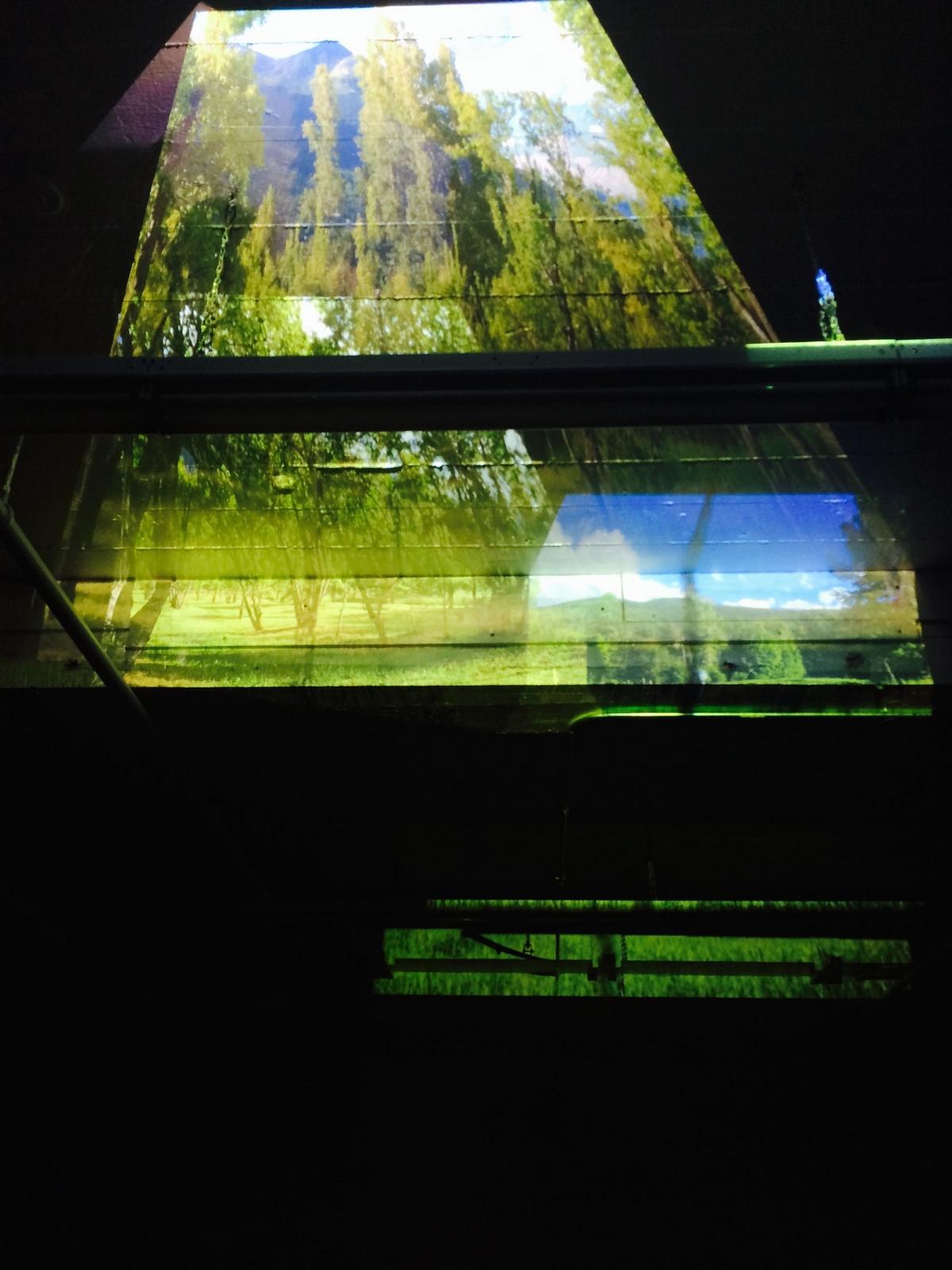 Photo courtesy of the artist prOphecy sun
Photo courtesy of the artist prOphecy sun
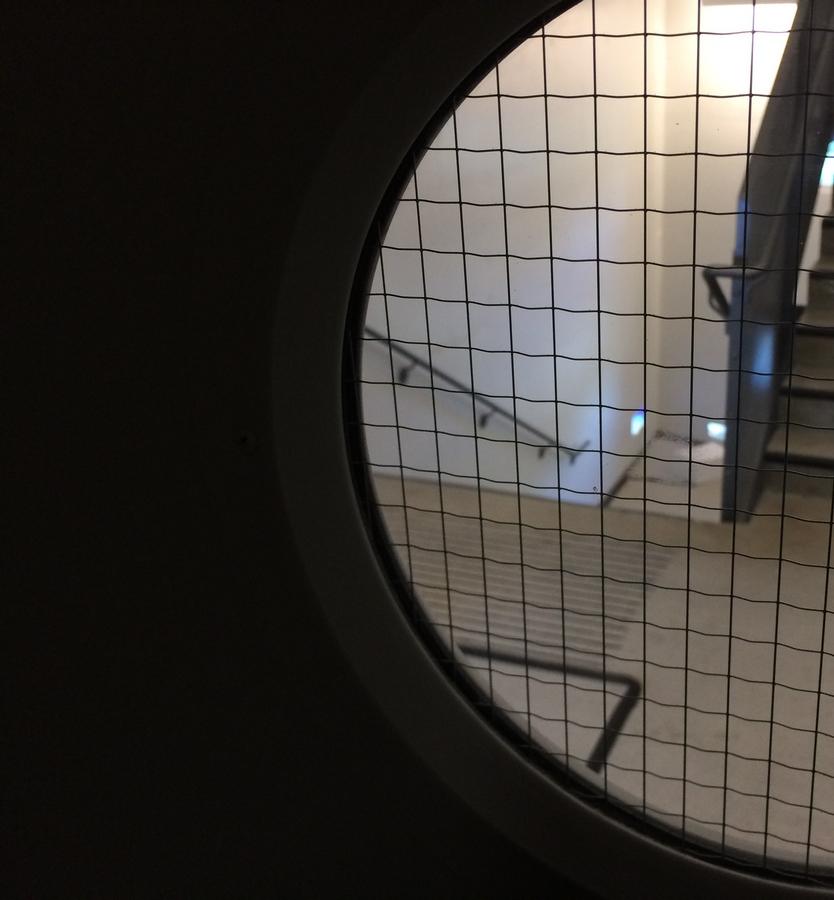
prOphecy Sun scape Land CONTEMPORARY ART REVIEW
Photo courtesy of the artist prOphecy sun
theorist Marshall McLuhan there is a 'sense bias' that affects Western societies favoring visual logic, a shift that occurred with the advent of the alphabet as the eye became more essential than ear. How do you see the relationship between sound and moving images?

On some level everyone has a relationship with sound. It can live, breathe and circulate between objects, spaces, bodies and is in everything. Moving images can showcase a multitude of perspectives both felt and unseen and has the potential to help us escape to new worlds that are coloured by music, tonal textures and vivid visual compositions.
In my practice I use sound and moving image as central elements for my installations. The combination of nuanced, time-based imagery and experimental sound invites audiences to listen with both their ears and eyes. In this way, the mediums become symbiotic and integral to one another to help push, distort, modulate and open up our perception and sense of reality.
Many artists explore ideas through representations of the body and by using their own bodies in their creative process. German visual artist Gerhard Richter once remarked that "it is always only a matter of seeing: the physical act is unavoidable". As a performance artist, how would you consider the relation between the abstract nature of the ideas you explore and the physical act of producing your artworks? In particular, what role does improvisation play in your process?
I see no separation between an idea and an action. Both feed off one another, in the
prOphecy sun scape Land CONTEMPORARY ART REVIEW
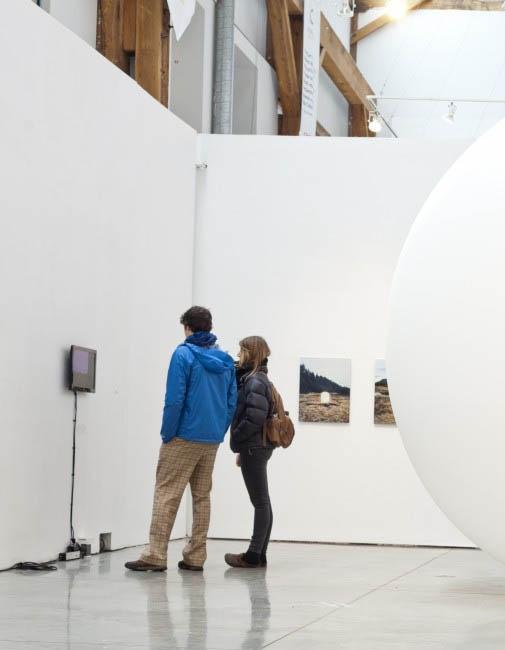 Photo by Amanda Arcuri
Photo by Amanda Arcuri

moment. I see the act of trying something new as a great way to push my boundary between emotional, physical space, perception and reality. However, I do see a link between observing and physically trying something new. As such, I investigate these notions through theoretical constructs on improvisation to develop bridging strategies to explain how the body reacts and responds to the beautiful agency and power of objects.
We have particularly appreciated the way Echoes of Balance and Push shows such stimulating synergy between Art ands Technology. Multidisciplinary artist Angela Bulloch once remarked "that works of art often continue to evolve after they have been realisedrealized, simply by the fact that they are conceived with an element of change, or an inherent potential for some kind of shift to occur". Technology can be used to create innovative works, but innovation means not only to create works that haven't been seen before, but especially to recontextualize what already exists. Do you think that the role of the artist has changed these days with the new global communications and the new sensibility created by new media? In particular, how is in your opinion technology affecting the consumption of art?
I think that contemporary artists are at the forefront of thinking about material practices in relation to new media and technology. Their role is ever changing, in flux, especially with the addition of new populist communication technologies. Further, they consciously and participate in a global transfer of data along a transoceanic information superhighway. What author Susan Buck-Morss implies as a conscious exchange of power, where artists choose to

prOphecy Sun scape CONTEMPORARY ART REVIEW Land

prOphecy sun scape Land CONTEMPORARY ART REVIEW
Photo by Darren Fleet
integrate technology into their daily practices as tools for media production.
I too am implicated in this exchange, as I am a global consumer. I embrace small technologies like the smartphone to record
improvisations and sound elements that might be incorporated into future installations. I think that there is a liberating potential with current phone technology that operates beyond its populist communication applications and generates

prOphecy Sun scape Land CONTEMPORARY ART REVIEW
Photo courtesy of the artist prOphecy sun
to my great pleasure speculative and chimeric imagery. Further, as Timothy Morton states, objects can exist across distance, being so massive that they refute time and space (Morton, 2009, 10-18).
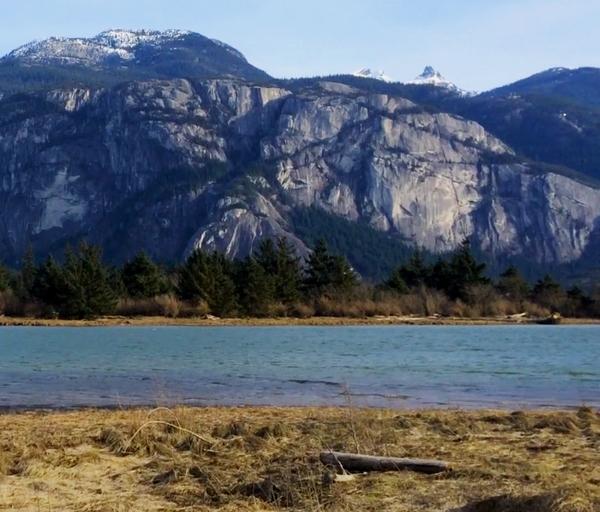
Building on Morton’s ideas of
omnipresence, to be present everywhere, I too do take advantage of the expansive nature of the smartphone by immediately editing and uploading media content so that it is ready for the masses. Its ability to communicate with cellphone towers and
prOphecy sun scape Land CONTEMPORARY ART REVIEW
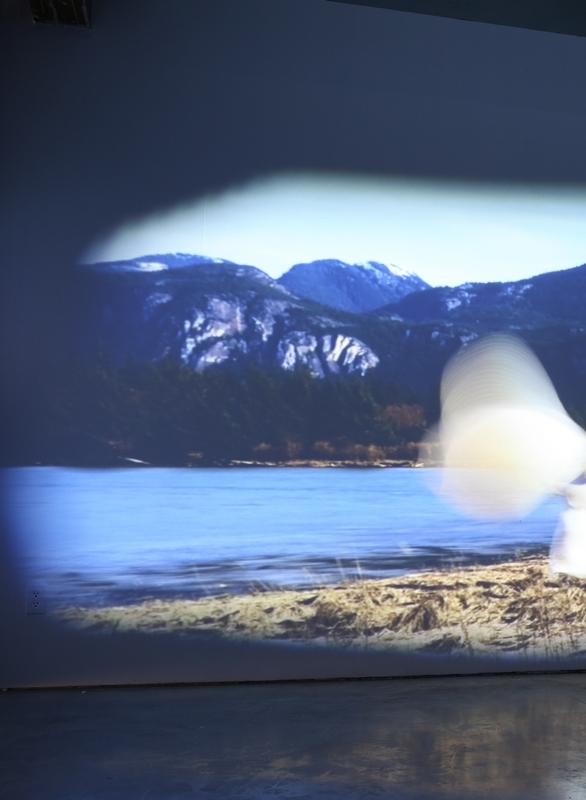
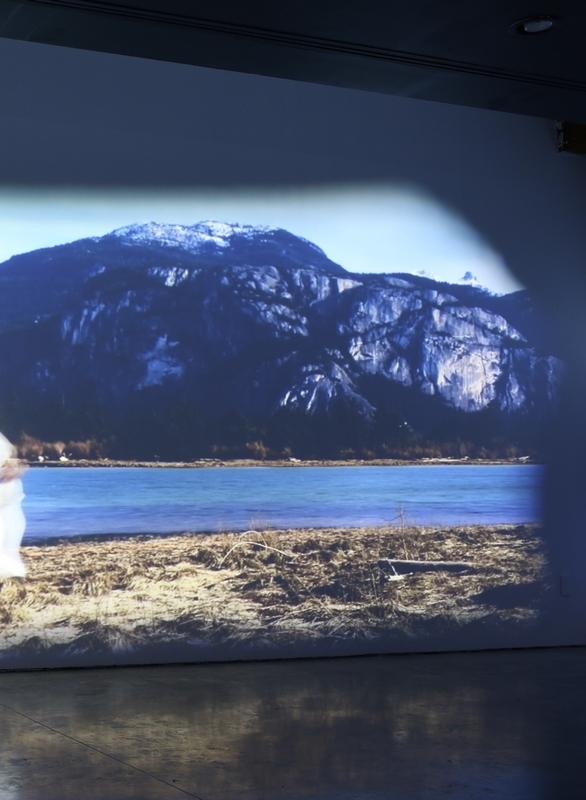 Photo by Amanda Arcuri
Photo by Amanda Arcuri
satellites makes it an object that can cross physical and spatial boundaries belying its disarmingly small size.
Your artworks accomplish the difficult task of invoking deep body memory and draw from an interior landscape of dreams: how would you consider the relationship between reality and imagination within your practice?
An exploration of dreams is a recurring source of inspiration for my practice. Coupled with observations from lived, waking experience, dreams offer another layer and resource for making art. Inspired by my dreams I use inflatables and weather balloons as a material to explore the entanglement between waking life and the dream, between multifarious vantage points within the reality of everyday experience. I keep a log of lucid dreams, visions and events and interpret these remnants into art works. The weather balloon first appeared in a dream and struck me as a powerful symbol. I have since been working with this material alongside other inflatable shapes using techniques and exercises that allow for new configurations, improvisations and chance encounters that embrace the fluid nature of the dream space.
Your observation seems to be very analytical, yet strives to be full of emotion: how much importance does has improvisation have in your process?
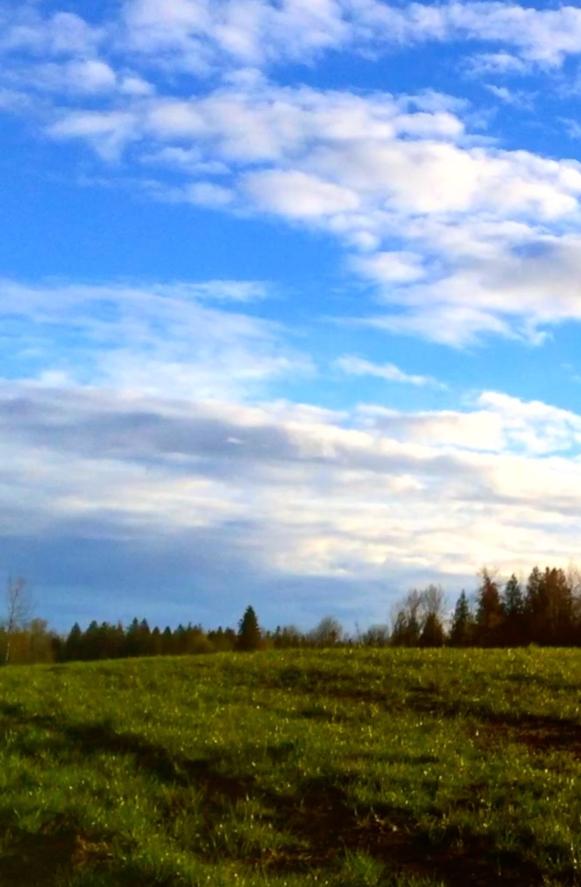
Improvisation is an essential element for my creative process. As someone with dance training it is a means through which my artwork comes into form. Movement
evokes memories, and lives in the body. For example, in my recent works inflatables respond to my movements all the while communicating its own gravity and vibrancy. In this way, the balloon becomes a dance partner with my body in front of a camera, the choreography an improvised repetition of tasks including wandering, carrying, climbing, walking, crawling, falling, and crouching.
prOphecy Sun scape Land CONTEMPORARY ART REVIEW
Through these actions the material exists independently and has its own desire. And through bodily movement and chance brought about by improvisation I express emotion, memory and experience in a tangible form.
Over the years your works have been showcased in several occasions, including
Fest Miden (GR), inFlux- Surrey Art Gallery, Big Joy Festival, Destroy Vancouver, ArtTalkingWomen, and MOCO 2016. One of the hallmarks of your work is its ability to create a direct involvement with the viewers, who are urged to evolve from a condition of mere spectatorship. So before leaving this conversation we would like to pose a question about the nature of the
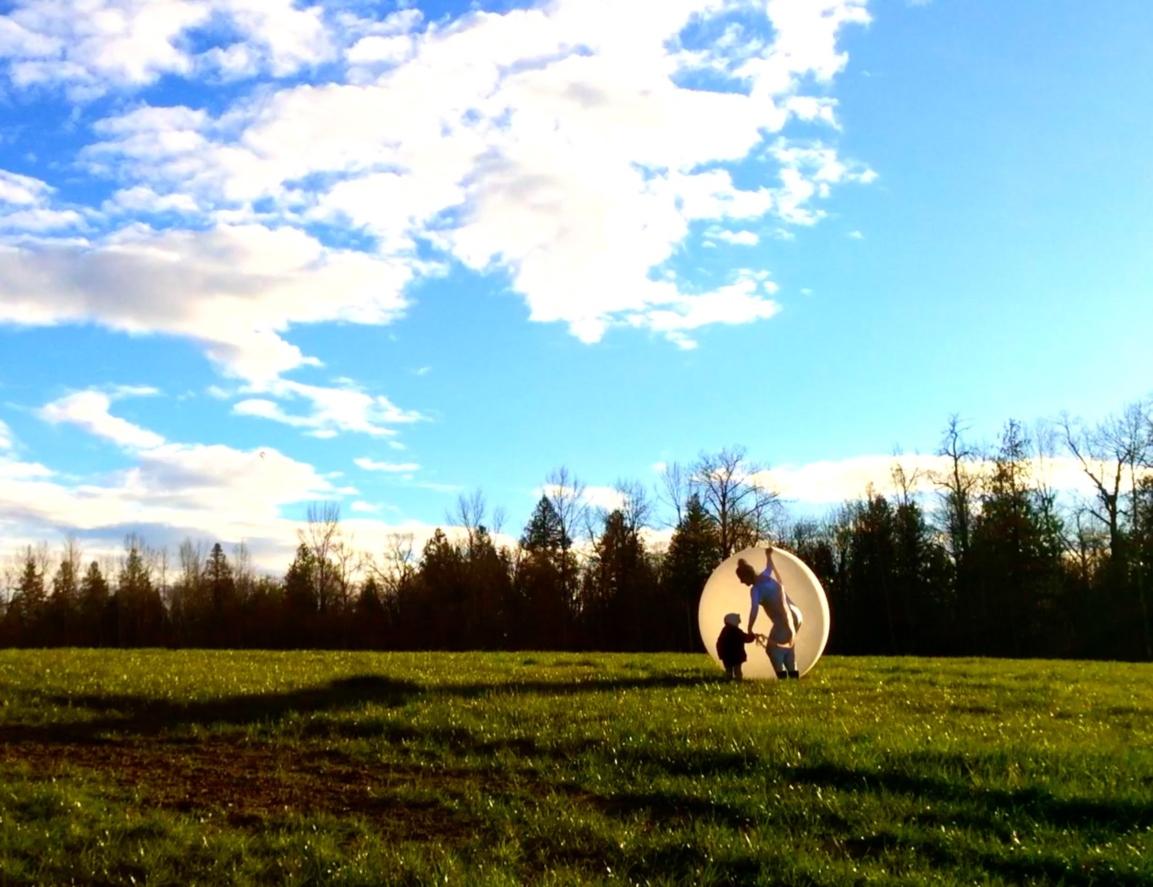
prOphecy sun scape Land CONTEMPORARY ART REVIEW
relationship of your art with your audience. Do you consider the issue of audience reception a crucial component of your decision-making process, in terms of what type of language you use in a particular context?
I believe that an audience is always present. In some ways someone is always
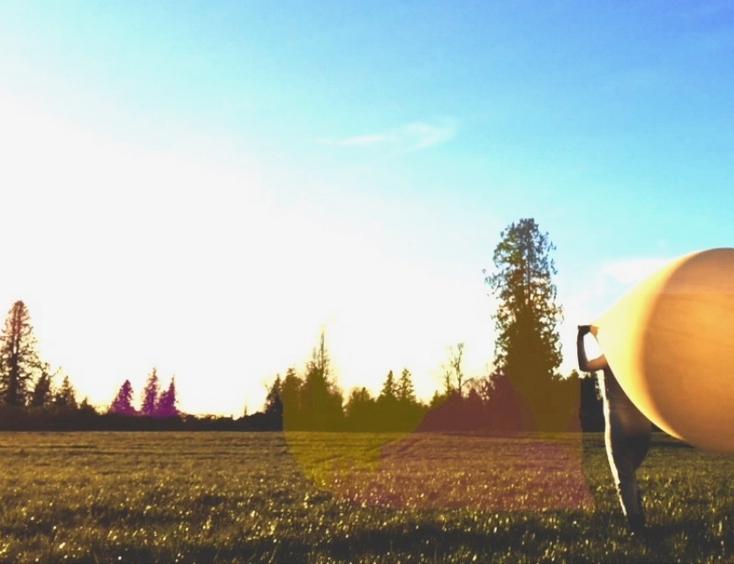
watching, whether I see them or not. It is also important to note that I continually put my own body in front of the camera and work collaboratively with a material, in a space, with and without the audience in front of me.
I like to push what is expected in a performance or installation. More recently
prOphecy Sun scape Land CONTEMPORARY ART REVIEW
Photo courtesy of the artist prOphecy sun
I have challenged audiences to look at my work in unique ways due to the physical constraints created by placing the installations close to the floor with small screen sizes. By guiding audiences to crouch, get close, and go out of their way to look at the artwork, I foreground the physical senses to experience the work as it was intended, in ways that are
improvised and shifting with increased awareness of one’s own body. Often these artistic interventions take root in another space from its original inspiration and then evolve to become a new breathing, conceptual point of experimentation. In this way, I hope to inspire viewers to consider the work in a space that is both emotional and unknown, where the mind becomes just another muscle in the body, and the focus becomes the objective presence of the body as an object and its movement.
Thanks a lot for your time and for sharing your thoughts, prOphecy sun. Finally, would you like to tell us readers something about your future projects? How do you see your work evolving?
Thank you. My future research seeks to synthesize my recent works and considers objects, moving image, sound, sitespecificity, installation; ritual-like movement and motion capture data from both of my young children. The resulting pieces will be showcased in a exhibition that covers the full arch of the research including: a series of site-specific, immersive installations, presenting projected visualizations onto moving imagery from expansive systems such as oceans, skies and wild sensory landscapes.
An interview by Katherine Williams, curator and Josh Ryder, curator landescape@europe.com

prOphecy Sun scape Land CONTEMPORARY ART REVIEW
orma Alonzo
An artist's statement
Norma Alonzo has always taken her painting life seriously, albeit
privately. An extraordinarily accomplished artist, she has been painting for over 25 years. Beginning as a landscape painter, she quickly transitioned to an immersion in all genres to experiment and learn.
Initially, Alonzo was torn between professionsthe arts or a career in architecture. She chose the arts, graduating from San Jose State University in San Jose, California with a degree in Interior Design. After working in this field and ultimately heading her own design firm, her focus turned to the creation of fine art. Under the mentorship of Richard Lees (artist and art historian of Pasadena, California), Alonzo was encouraged toward honesty in her painting without judgment, without expectation, and without the confines of outside demanding interests.
Through her paintings, Alonzo examines our place, metaphysically and functionally, in the midst of today’s fast-paced world. For Alonzo, it has been a year of painting dangerously. Experimentation with the formal elements of line, form, mass and texture are now in play. More importantly, the guiding principle is fearlessness in the use of color and space.
Of her current work, Alonzo states, “Abstract painting has pushed its way into everything I have done. I am forever manipulating line, color, and shape into something more. For many
years I have been playing, experimenting, and learning what the different mediums can do. Researching art history, painters, their methods…At this point in my painting life I am an amalgam of my experimental/learning years, my love of landscape (the ultimate abstract), color, decor, art history, and my own life journey.”
The visual experience of Alonzo’s newest body of work reflects her many years in California and the regional/global influence of the Post-War Bay Area Figurative movement. Specifically dominant are Richard Diebenkorn (American, 1922 – 1993) and Wayne Thiebaud (American, b. 1920). In addition, Alonzo cites Henri Matisse (French, 1869 – 1954) as inspiration.
A major life-changing event imposed and necessitated a profound emotional overhaul. She relocated to beautiful Santa Fe, New Mexico and found the space to heal, strengthen and create. She has reached a new appreciation for her life’s work and embraces the potency of her exploration of self-reflection, beauty and redemption in her paintings.
“I have painted for many years always with the notion that it was only for me. I no longer feel this way… I have something powerful to share…I have a distinct view point and I see tremendous value in it.”
After 25 years painting, Alonzo has come to a place where she believes she has something to offer, something to put forth into the world. 2017 marks the first venture into the larger art world for Alonzo.
CONTEMPORARY ART REVIEW N
scape Land

Community Confined
LandEscape meets
Norma Alonzo
Hello Norma and welcome to LandEscape: we would start this interview with a couple of questions about your multifaceted professional background. You hold a degree in Interior Design, that you received from San Jose State University in San Jose, California and after your careed in the field Interior Design, your focus turned to the creation of fine art: how do your formal training and work influence the way you currently conceive and produce your works? And in particular, how does yur experience of training under the guidance of artist and art historian Richard Lees inform the way you relate yourself to art making?
I grew up in San Diego California where the sun and warmth played with a garden of roses, and chilies. My mother would grow gardenias, roses, bird of paradise, zinnias, carnations, purple, and fuchsia colored
bougainvilleas, red and green chilies, sweet peas, various fruit trees, including bananas, oranges, plums, apricots, avocado, and of course lemon. It was a feast of wild color, all set in the blue sky of a city with perpetual sun shine.
It was never lost on me that color influenced my work as an interior designer. I loved bringing patterns of fabric, and paint into harmony and balance. It was a joy to create an environment from so many integral parts. A puzzle set into place with line, color, and a continuity of pattern. I would often look for art for a client, and thought I could do that, but better.
It was not long before I started painting, and found my mentor Richard Lees. He was teaching a landscape painting class at the Pasadena Design school. He taught me to look at the landscape as the ultimate abstract. How do I corral this landscape of assorted color, and odd shapes set in a background of sky and
scape Land CONTEMPORARY ART REVIEW
An interview by Katherine Williams, curator and Melissa C. Hilborn, curator landescape@europe.com
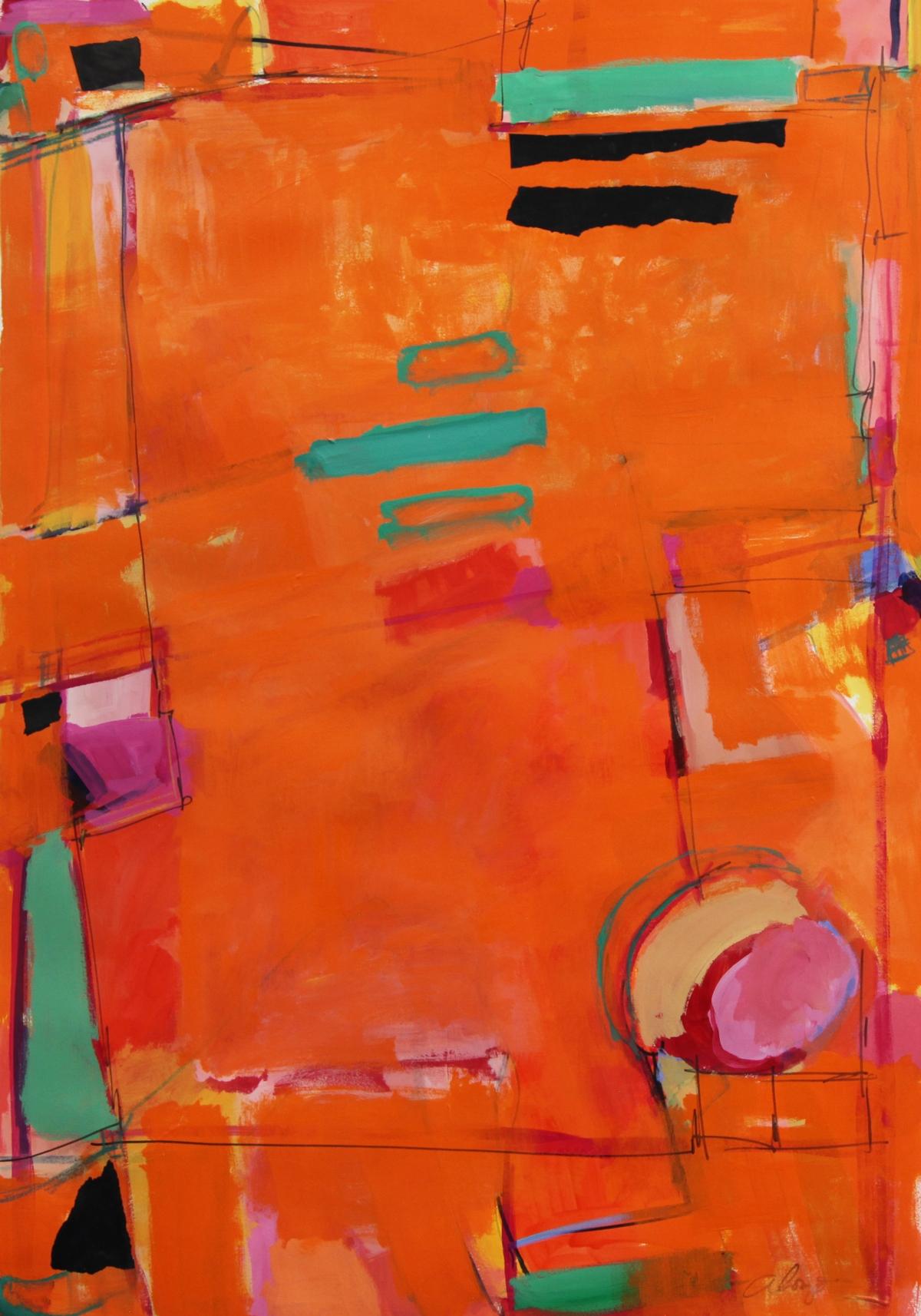
Orange Field
mountains? Altho I do not consider myself a landscape painter I continue to paint the landscape whenever I feel stuck, or uninspired. It is always a refreshing challenge that grounds me, and prepares me to work on abstract painting from my subconscious.
Richard introduced me to the New York school of abstract painters. Whether it was the early paintings of Jackson Pollock where image was poured over, and manipulated, or his later work where he moved beyond the “veiling” of realistic imagery. Richard stressed the importance of continuity of line and movement. Shapes must have meaning, color must move around the canvas. I was taught the basics of how to achieve a successful painting. But more importantly he taught me that it was up to me to work from my gut, or the subconscious, and to respect what unfolds. It was the most liberating message to be remembered time, and again.
For this special edition of LandEscape we have selected Over Here and Sedona, a couple of paintings from your recent production that our readers have already started to get to know in the introductory pages of this article. Your paintings communicate a successful attempt to transform

Special Edition scape Land CONTEMPORARY ART REVIEW
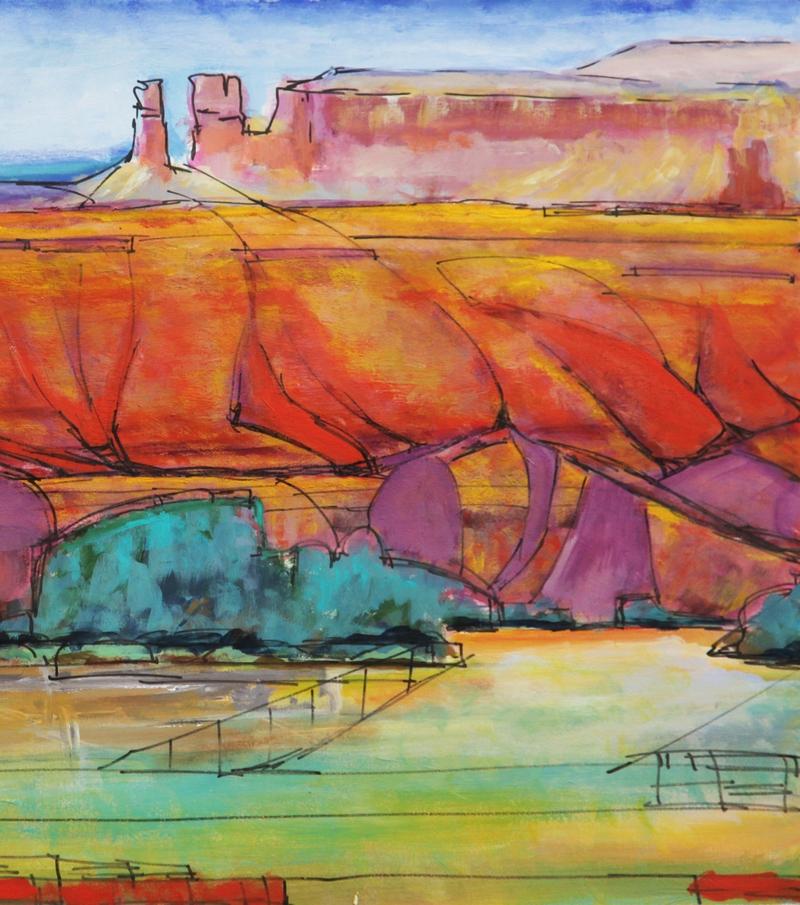
Norma Alonzo scape Land CONTEMPORARY ART REVIEW
Mexico
New

Special Edition scape Land CONTEMPORARY ART REVIEW
Park #1
tension to harmony and what has at once captured our attention it's their dynamic and autonomous aesthetics: are your works painted gesturally, instinctively? Or do you methodically transpose geometric schemes from paper to canvas? Moreover, the synergy between figurative themes and abstract language that marks ut your artistic production is the result of a constant evolution of your style: your inquiry into the expressive potential of colors combines together figurative as subtle abstract feature into a coherent balance. We we would suggest to our readers to visit http://normaalonzo.com in order to get a synoptic view of your work: in the meanwhile, would you like to tell to our readers something about the evolution of your style? In particular, would you shed light on your usual process and set up?
“Sedona “ was painted from a trip to the beautiful town of Sedona in Arizona.
I often take watercolors, and paint while away from my studio. In this case
a small painting was made on site, and then painted to a larger scale here at my studio. Rather than take the painting directly from the small drawing. I use my personal sensory

Norma Alonzo scape Land CONTEMPORARY ART REVIEW
images in combination with the small painting as a reference for the larger one. Once I begin I let my subconscious
dictate where the painting will go. I recall I was caught by the towering shapes of the rocks in Sedona doing battle with the green of the valley. The colors are true. The blue was deep, and the red was verging on orange. The most intriguing
aspect with regard to these shapes is that they all hold approximately the same weight of importance. (This is the antithesis of what most schools teach. The common teaching of landscapes is to have one dominate aspect of a painting.) Those immensely important mountains were in place
because of the deep green of the landscape, including the deep shadows of the road, and the blue sky. As I manipulate an image that sense of place is the bridge between abstract and imagery.
“Overhere” is a painting meant to convey that jittery energy that dances around to be recognized. It doesn’t have to be overtly recognized as in this case where the colors are subdued, and rather pleasant. I love the juxtaposition of a calm backdrop
against the jumpy energy of the black lines, and the odd roundness of the shapes. It is something that I do in one way or another, to measure soft against hard, purpose against randomness etc. Life to me is the constant balancing of all the input that we are receiving. I am a wife, mother, friend, artist, and citizen of the world. It is a lot to process and to hold. Painting allows me to recall, acknowledge, release or keep these feelings.
Your paintings seem to communicate such sense of freedom and as you have remarked once, the guiding principle is fearlessness in the use of color and space: How much importance does play spontaneity in your work? In particular, do you conceive you works instinctively or do you methodically elaborate your pieces?
My mother was born in Cabo San Lucas, Mexico. In addition to thinking of Cabo
As a beautiful city by the sea it is also a city of dirt and rocks. She would often describe life there in the 1940’s. It was hard dirt, and hard work to get the garden to grow. Her description of the land was always heart felt. I didn’t truly get the beauty of dirt until I moved to Santa Fe, New Mexico.
Special Edition scape Land CONTEMPORARY ART REVIEW

Over Here

Pueblo
Santa Fe is covered with arroyos. Arroyos are created when the rains fall so quickly that the ground can not absorb it. The water runs so furiously that it creates crevices in the ground. In the painting “stones” I wanted to pay homage to the beauty and magic of these arroyos. Chiseled layers of dirt creating patterns great and small.
I didn’t begin the painting with the intention that it would be a remembrance of my mothers memories, but as the painting took shape I realized that I had absorbed her memory as my own now that I am living here in New Mexico. As with most of my paintings I let the my subconscious guide me.
The theme of landscape is particularly recurrent in your imagery and your newest body of work reflects both your life's experience in California and your current life in New Mexico. We like the way landscape never plays the role of a mere background in your artworks and we appreciate the way New Mexico and Park bring the notion of environment to a new level of significance: how much importance does play direct experience for your creative process? And how do you select the landscapes that we can admire in your paintings?
Direct experience is present in all my work. I can not work from my gut without bringing everything I am into the picture. Often I will step back half way through a painting and see that something is forming from a memory, a time or a place. A recognition of something visceral, spiritual, or a memory that my higher self acknowledges, and brings forth. Sometimes the painting will develop along one line, and other times it will morph into something in combination. It is an exciting time when I feel it in my body as a knowing of some kind as the painting takes shape and expresses itself.
My references are totally personal. The landscapes that I choose to paint must have a personal meaning. It can be as simple as a story about the desert or the shore that I read to my children that now has become my memory. It can be a visit to a nearby town that is a memory that I can recall. It can be a brief glimpse of something that is again a stored memory because it meant something, sometimes unbeknownst to me for one reason, or another. The painting will let me know why it matters. I may use a photo reference, or a small sketch but it is soon let go once the work begins.
scape Land CONTEMPORARY ART REVIEW
Norma Alonzo
In the case of the painting “New Mexico” I painted it after visiting Georgia Okeefes Ghost Ranch, and Abiqui. It is not so much the ranch itself or the surrounding terrain, but what it meant to me. It is a combination of the view from Georgias studio in Abiqui, and the memory of the surrounding land. It was beautiful with its red rocks, but more interesting to me by the farm land that was nestled against the mountain. It was the great, and the small having equal time to be brilliant. I hope my painting conveys that sense that everything is of value, and everything is equal from the blue sky, the distant mountain, to the canyons, the valley, the trees in the distance, the foreground of grass and land. It is the totality, and its parts that interest me, that holds me.
Your abstract style invites your spectatorship to an open reading and we daresay that it brings about a shift in the viewer's perceptual parameters to a more contemplative state: how permanently can such a visual experience be sustained amidst the everchanging, unstable contemporary society?
How permanently can such a visual experience be sustained amidst an unstable ever changing contemporary society? I love that question!

Special Edition scape Land CONTEMPORARY ART REVIEW

Norma Alonzo scape Land CONTEMPORARY ART REVIEW
Park #2

Special Edition scape Land CONTEMPORARY ART REVIEW
Sedona
We are living in a world with a facade of order, where truth is lost, and must be found. At any time we now hear on the news the horrors of the day. Whether it is the hypocrisy of our leaders, or the guns that kill, or the displacement we may feel. We are bombarded with this new way of life. It is not my intention to fix any of this through my paintings, but rather to give us a sense of place. A remembrance that we are supported and recognized. That we are all human, that we are free to feel our feelings. My paintings offer a place that we acknowledge is part of us, the strengths and vulnerability we face every day. It is okay to sit with our feelings, whether good or bad, clarity or confusion, hate and love. It is all there in moments with any given painting. My paintings are successful if we feel the freedom that we are human.
Among your influences you have once metioned the Post-War Bay Area Figurative movement, as Richard Diebenkorn and Wayne Thiebaud, as well as Henri Matisse: what do you think to have learnt from the lessons of such captivating artists? Moreover, do you pay attention to the work of your contemporaries? If so, is there anyone in particular you feel inspired by?

Land CONTEMPORARY ART REVIEW
Norma Alonzo
scape
I lived in the bay area for many years. I was fortunate to live close to the university of California Berkeley. Berkeley housed a wonderful collection of paintings by Hans Hoffman. It is here that I understood the concept of push and pull, space, shape, and surface. All with the idea that we could create another dimension within a flat format. I loved that. The message I received in viewing, and reading what Hans had to offer was that opposing forces could be powerful, real and metaphysical, spiritual and pictorial. Richard Lees would often conclude that Hans had many similarities to Matisse. Matisse the master of color and the arabesque, or that beautiful line that would weave across the paintings. Hans the master of dimensional space. I believe it was Richard Diebenkorn that combined the two artists to create powerful master works of line, color and brush stroke. I don’t know that there has ever been a comparison of the three, but to my own aesthetic the works all have historically manipulated the surface to create another dimension. They are powerful works that move us and call to us to spend time and recall a knowing from our depths. It is no coincidence that my paintings must sing with color, line and shape. It is no
coincidence that I strive to create depth of field within the confines of a flat surface. Sometimes I am more successful here, and other times perhaps it is the color, or the line work that carries the painting.
One of the artist I follow that has a similar aesthetic is Robert Szot out of Brooklyn New York. He paints from his gut. He paints in beautiful shapes, and color that reference unknown layers of something deep and moving. If I look hard enough I am swept away to a knowing that is very personal to me. Almost like a deep meditation with language and feelings..truly beautiful work.
Both abstract and figurative, your artworks seem to address the viewers to recreate in their minds the spirit of the locations that you captured with your brushstrokes: how would you consider the relationship between figurative and the abstract in your works?
While in college I took a few urban development classes. It was not lost to me the importance of planned communities, organized chaos if you will. Everything just moved better when we planned where our roads should be, where the building should be, parks, shopping, schools etc. It was
Special Edition scape CONTEMPORARY ART REVIEW Land

Taos
 White
White
always better to plan ahead before anything was built. In the painting “community confined” this did not happen. It is a painting about what I see sometimes around me in rural areas. Homes clustered together surrounded by open space. A housing development with no space within, no community to move into and only confined to a row of houses. The community has yet to be built. It is incomplete, but the potential is always present that something else will happen. There is always hope that it could expand into something more. “Community confined” is about these two elements living together, truth and possibility.
Your paitings speaks both of rigorous sense of geometry, as the interesting Taos and Yellow Farm, and of emotion,as the captivating Orange Field: would you tell how does your own psychological make-up reflect the nuances of tones you decide to use in a painting? How much importance does play intuition?
Everyone has good and bad days. Some days I am filled with confusion about where I stand in the world. When you can’t shake off the feelings that life sucks, and it is all going to pot and begin to paint anyway. I sometimes see what emerges is a need to control the
space as a way to express boundaries, that call for order in chaos. The same may be said when I am feeling joyous. A need to control the space takes shape as a way to balance life honestly. My innate sense is to see the world expanding, but often the forces of reality makes me want to reel it all back in. In truth so much of the line work is me joining forces with some reality, trying to find a balance. I am not just heart, but I am head, and thought. It is important to see what is there.
In both the paintings, Taos and Yellow Farm my initial idea came from claiming my new home in New Mexico. After visiting Taos I came away with this feeling that there are layers and layers of history. The pueblo is there in all it’s original heart. It is still a living pueblo with family members deciding to live without electricity, or running water. I wanted to convey the weight of what that means.
The responsibility these people have to their history. I think it is a beautiful painting of heart and history, work and struggle, sacrifice and freedom to choose how we live.
Before leaving this conversation we would like to pose a question about the nature of the relationship of your art with your audience. Do you
Norma Alonzo scape Land CONTEMPORARY ART REVIEW
consider the issue of audience reception as being a crucial component of your decision-making process, in terms of what type of language is used in a particular context?
Some twenty plus years ago when I first began to paint I would be moan the fact that it seemed I had no style. I wanted to try everything. I wanted to learn what every medium could do, and how I could paint in my own intuitive fashion. I painted with the idea that it was all me all the time. I didn’t want to paint like anyone else I wanted to paint like me. I painted for some time, and yet there was nothing truly distinctive about me as a painter. One painting looked like one artist, another painting like another artist. My paintings could be called Matisse like or Diebenkorn like. I was disappointed that, my style had not emerged. I felt stuck.
My mentor Richard Lees took one hard look at me and said, it is the death knell to have a distinctive style, that I should paint whatever I wanted, and paint for myself. He proceeded to tell me the sad story of Jackson Pollocks end. Before his death he had moved into another mode of painting. The drip paintings were essentially left behind. He tried something new, and it was not well received. The critics were hard, demanding and cruel.
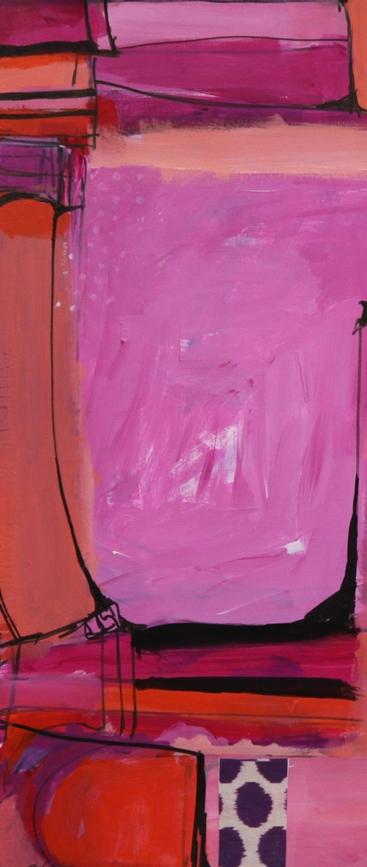
Special Edition scape Land CONTEMPORARY ART REVIEW

Norma Alonzo scape Land CONTEMPORARY ART REVIEW Stones

Special Edition scape Land CONTEMPORARY ART REVIEW Village
Richard reminded me that I am painting to paint, and that in time I would emerge in all my glory. I am not painting for critics, for an audience, for a style. I am painting because it brings me self reflection, truth and honesty, and because I can.
Thanks a lot for your time and for sharing your thoughts, Norma. Finally, would you like to tell us readers something about your future projects? How do you see your work evolving?
I am transitioning into something more. It is a difficult time when I begin again to push myself. It is not an easy time, and I won’t settle for what is comfortable. It is not so much that I am leaving anything behind as much as it is that I am expanding. I am one of those sorry characters that is bored quickly with myself, and others. I am impatient and uncomfortable when I stop learning. I want to see where my line work can take me. How I can improve my brush stroke, where I can make a painting rich and thoughtful, exciting and contemplative. I may be here working on this for a while.
An interview by Katherine Williams, curator and Melissa C. Hilborn, curator landescape@europe.com

Norma Alonzo scape Land CONTEMPORARY ART REVIEW
Bette Ridgeway
Lives and works in Santa Fe, New Mexico, USA
An artist's statement
Pushing the boundaries of light, color and design, Bette Ridgeway is best known for her large- scale, luminous
poured canvases, which have garnered the artist international recognition.
Bette Ridgeway was born in Tupper Lake, a small village in the Adirondack Mountains in New York (a few miles from the Canadian border). Inspired by the pristine and expansive beauty of this 6 million square mile natural habitat, she began drawing and painting as a young child. At 13, she enrolled in watercolor landscape painting and figure drawing classes at the Albany Institute of History and Art, Albany, NY, where the Hudson River School artists, the Impressionists and the work of Pablo Picasso thoroughly captivated her young artist’s imagination.
Ridgeway went on to study the visual arts with an emphasis on graphic design at Russell Sage College in Troy, NY. At the same time, based on her portfolio submission, she was hired as a professional designer at Reuben H. Donnelley Advertising Corporation in Albany, NY. She discovered that the Donnelley Corporation could offer, with its on-the-job training, far more training than any college. “This was my art “boot camp,” says the artist. Ridgeway also attended classes at the School of Interior Design Art and the Art Students League, New York City, NY. She then struck out across the globe - studying, painting, teaching and exhibiting her work, while simultaneously immersing herself in the customs and colors of the diverse cultures of Africa, Australia, Europe, Asia, Mexico and South America. She studied and taught painting during lengthy stays in Antanarivo, Madagascar; Canberra, Australia; and Santiago, Chile.
Returning to the United States, Ridgeway continued to study painting privately with accomplished professionals, while also focusing on raising her family and her work outside of the
studio. In 1973, she was hired as visual arts specialist for the Maryland National Capital Park & Planning Commission, where she administered a federally funded CETA program, which provided young artists with studio space. She also created the first sports arena Art Gallery at Capital Center in Landover, Maryland. In the mid-1970’s, she was instrumental in the design and fundraising campaign of the Montpelier Center for the Arts & Education in Laurel, MD, where she developed an arts festival for disabled young people. She also chaired the Laurel Art Guild. Ridgeway was then hired to coordinate the national festival program for Very Special Arts, the educational affiliate of the John F. Kennedy Center for the Performing Arts. Within a year she was asked to become its Executive Director and CEO.
Ridgeway’s formal art studies provided her the basic tools in the use of materials and technique. While she exhibited some of her work in the 1970’s, winning her awards, her unique style was a long time in development. Through her work with Very Special Arts, Ridgeway was introduced to Paul Jenkins, the acclaimed Abstract Expressionist painter. He became a good friend and mentor, encouraging the artist to work large, eliminate subject matter, and focus on color, space and time. He once jokingly referred to his paintings as “chaos” and Ridgeway’s as “controlled chaos.” She shared her work with Jenkins for nine years before he finally declared, “You are ready for a show!”
Ridgeway took Jenkins’ advice and has spent the last 30 years developing and refining her signature technique. Though at ease with oil paint, she shifted to acrylic because she found it more versatile for her technique. She applies many layers of thin, transparent acrylics on unstretched linen or canvas to produce a fluidity and viscosity similar to traditional watercolor. She calls this technique “layering light.”
CONTEMPORARY ART REVIEW
scape Land

Bette Ridgeway scape Land CONTEMPORARY ART REVIEW
Ballet du Jardin
LandEscape meets
Bette Ridgeway
Hello Ms. Ridgeway and welcome to LandEscape: we would start this interview with a couple of questions about your multifaceted professional background. Your formal training includes experiences in several universities, including the Albany Institute of History and Art, the University of Santiago and the Centre de Culture Albert Camus in Antananarivo: how did these experiences form your evolution as an artist? And in particular, how did your travels in such a wide variety of countries influence the way you relate yourself to art making?
First, let me thank you for your interest in my work and for the honor of being included LandEscape. As you mentioned, my work is informed by a variety of
cultures and experiences. My travels and early studies opened my eyes to seeing seeing with a broader viewpoint and within many contexts. For example, colors in a tropical rainforest are different, for me, from colors in a high desert, dry environment. In Madagascar the colors were highly saturated (a good example is “California Dreaming”), whereas the colors in my current high-altitude home in Northern New Mexico are quite clean and pure, unencumbered by environmental distortion. Color is a mutable sensation, changing not only with the light, but the environment in which it occurs, and it is, for me, the very essence of all my painting. My basic tools are color, light and space, unencumbered by objects.
Your practice is marked with a captivating multidisciplinary feature, revealing that you are a versatile artist capable of crossing
scape Land CONTEMPORARY ART REVIEW
An interview by Katherine Williams, curator and Josh Ryder, curator landescape@europe.com

Bette Ridgeway scape Land CONTEMPORARY ART REVIEW
Ballet du Jardin

Ballet du Jardin
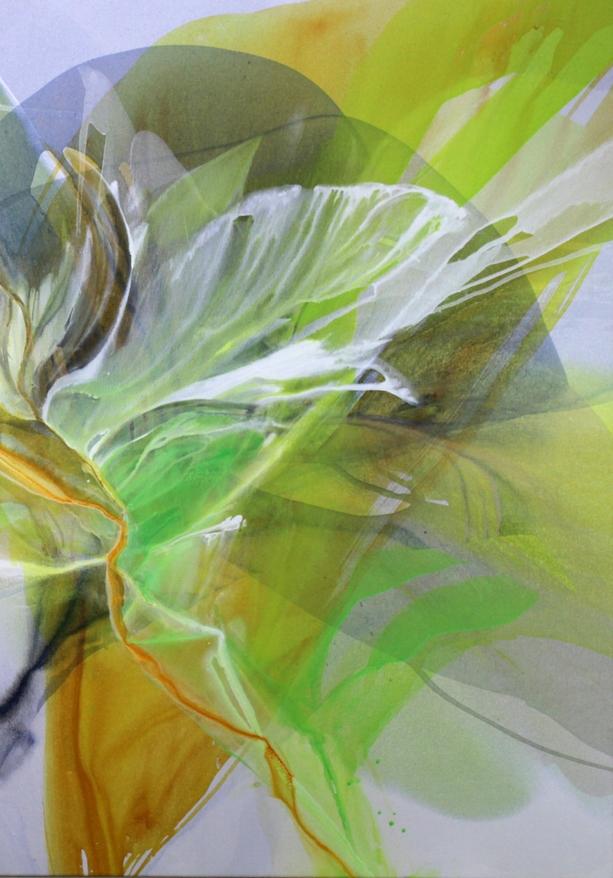
from one medium to another. Before starting to elaborate about your production, we would suggest to our readers to visit http://www.ridgewaystudio.com in order to get a synoptic view of your work: in the meantime, would you tell us what does draw you to such an approach? What are the properties you are searching for in the materials that you include in your work? And in particular, when do you recognize that one of the mediums has exhausted it expressive potential?
I go through periods of exploration and experimentation. For many years I worked with resin on metal, wood and cell cast acrylic. The results were really spectacular, but the toxicity made me sick. Since 2015, I’ve returned to pouring acrylic on canvas as well as creating metal sculpture. The common thread in all the work is the layering of color. The goal is always to use materials with which to create transparency, luminosity, refraction and depth, whether on canvas or metal.

For this special edition of LandEscape we have selected Crysalis 2 and Ballet du Jardin, a
couple of paintings from your recent production that our readers have already started to get to know in the
Special Edition scape Land CONTEMPORARY ART REVIEW
Abiquiu Autumn
introductory pages of this article. When walking our readers through the genesis of these captivating
pieces of art, would you tell us something about your usual process and set up?

Bette Ridgeway scape Land CONTEMPORARY ART REVIEW
Interlude
The pouring process requires a complex set up. My large canvasses are suspended between five to six
uprights and painstakingly shaped for each pour. I use stools, small stepladders and wood crates. Since

Special Edition scape Land CONTEMPORARY ART REVIEW
I’ve worked this way for decades, I’ve gotten very adept at controlling the direction, velocity and density of
the pigments that I’m applying. If you look closely, you can see how each piece is architecturally composed. Beginning from the underlayers, I slowly build up the many layers that contribute to the overall composition. In Crysalis 2, for example, the horizontal washes of color were created first, then the long dense layering of the vertical passages followed. There were at least 50 pours in that one piece alone, a process that took many days. Ballet du Jardin, on the other hand, was created in my studio as the first spring leaves were beginning to appear in my garden outside and I was so taken by the promise of renewal the swirling, gentle breezes among the tender, young leaves dictated the minimal palette for the painting.
Themes from landscape and natural environment are particularly recurrent in your imagery and we have appreciated the way California Dreaming and Mountains and Sea capture the essence of the notion of natural environment in relationship of human viewing experience. Will you elaborate on the inspiration behind these pieces?

Bette Ridgeway scape Land CONTEMPORARY ART REVIEW
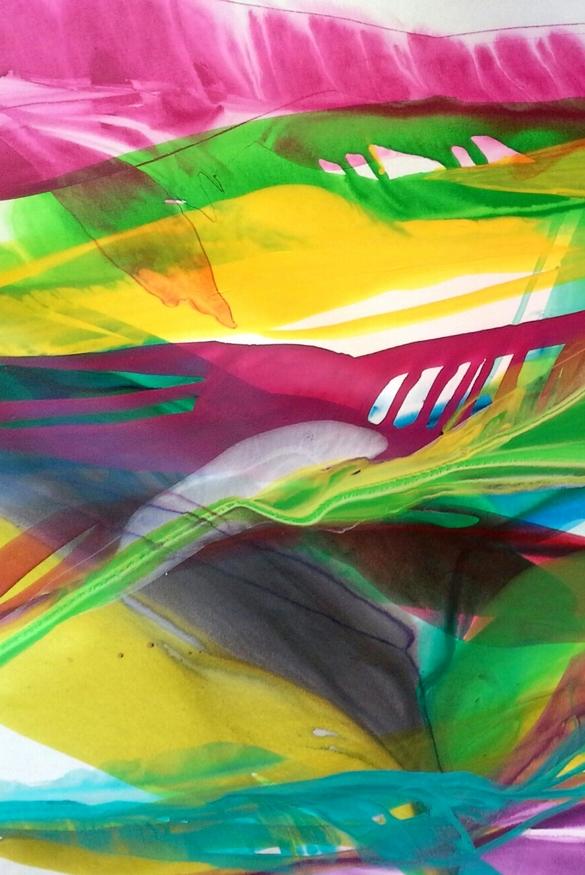

California Dreaming
Nature inspires all I create. The beauty of abstract painting is that everyone sees the work differently. The viewer actually completes the painting by bringing his or her own thoughts and experiences to bear, to see a piece in a deeper, more profound way. That has always been my goal to suggest a feeling, place, time or memory. Mountains and Sea, by contrast, is very large.

You can almost walk into it. I gave it that name as a tribute to one of my cherished icons, Helen Frankenthaler, whose early Mountains and Sea was the foundation of her long and very successful career. When I saw that painting in person many years ago, it took my breath away. It was a breakthrough painting for the new abstract expressionist movement,

Special Edition scape Land CONTEMPORARY ART REVIEW
crysalis
Spirits Rising
and paved the way for many of us who would follow.
Your paintings are so developed and nuanced: we have been captured by the complexity of your palette: how long did it take you to gain such a mastery of color? In particular, how do you determine the nuances of tones you decide to use in an artwork?

It has taken a lifetime to develop my painting skills. And, quite honestly, I am still challenged by the process. When I met my mentor, Paul Jenkins, in 1979, he saw something in my work. He encouraged me to explore color, time and space. I eliminated subject matter, as he suggested, and began pouring large canvases. After nine years, Jenkins announced I was ready to show. That was a lot of paint and canvas, but I treated my studio as a laboratory fearlessly making every possible mistake until I was reasonably comfortable with the process. One of the many reasons I love this technique is the ability it offers to create subtle tonality through many layers of washes of color. As I work on a piece, I take photos and look at them on a small screen. This helps in the overall composition. It is that nuance that keeps me excited and inspired.
You seem to prefer large canvases: British painter Jenny Saville once stated that she preferred large canvasses since the dimension of the eyes of her characters should have been large as her hands. What are your aesthetic and functional
Bette Ridgeway scape Land CONTEMPORARY ART REVIEW
Garden of the Mind
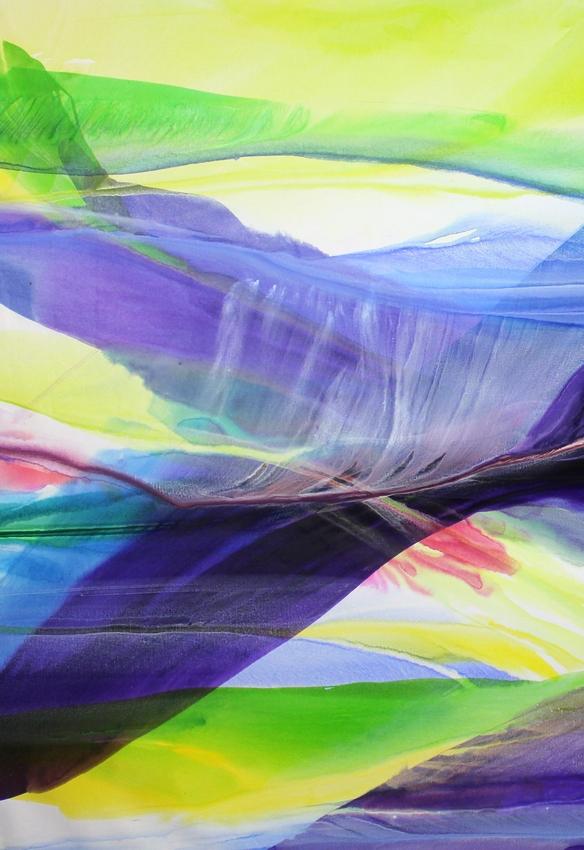
Mountains and Sea

Mountains and Sea
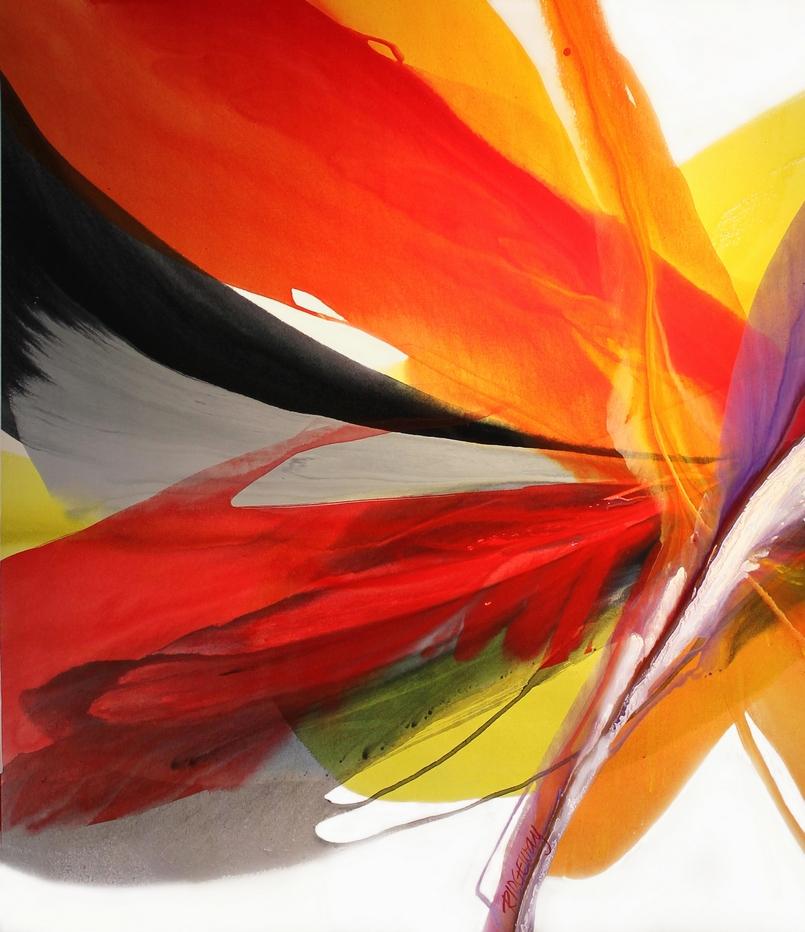
Special Edition scape Land CONTEMPORARY ART REVIEW
Romantica in Dean Day
decisions that lead you to choose large canvases?
With Interlude and Spirits Rising, I gave myself an assignment (which I often do). Interlude was to be a painting with many complex and interlocking tones of red, and Spirits Rising was to communicate high energy with primary colors placed in a harmonious vertical composition. I love working large because I can create more motion with the colors. Raising the canvas high on one side, allows me to execute a fast-moving sweep of color that depicts movement. This velocity is impossible to achieve on small canvas.
We like the way A Little More Red triggers the viewer's perceptual parameters: you seem to draw both from experience and from the subconscious. Would it be true to say that you are painting from the subconscious, and that your canvas acts as the subconscious of the person who views it?
If, when you say subconscious, you’re suggesting intuition, I agree. I am an intuitive painter. Color is the subject. Large work demands attention. If the work triggers the

Bette Ridgeway scape Land CONTEMPORARY ART REVIEW
subconscious of the viewer, I have succeeded. I enjoy the many ways that viewers interpret my work. It is fascinating to see how we all see so differently.
Dealing with influences, are there painters that were once important for you, or are important now? Do you pay attention to the contemporary scene?
As I mentioned, Paul Jenkins, was a major influence on my work. Helen Frankenthaler and Morris Louis also. The study of art provided me with information about the materials and technique. I continue to study art history and contemporary masters like Gerhard Richter, Bruce Nauman, Susan Rothenberg and Richard Serra.
I keep up with the art scene by reading journals such as this, along with Blouin News, Art News, The American Collector, Art Forum, and others.
Despite the references to real world, your artworks address your spectatorship to an open reading: in particular, we noticed that elements from environment are particularly recurrent in your
imagery and they never play the role of a mere background. Do you see a definite relationship between

Special Edition scape Land CONTEMPORARY ART REVIEW
Aquarius
natural environment and your imagery?

Absolutely. I became stunningly
aware of it when I made my biographical film, “The Dreamer.”
When I saw the draft film on a large
Bette Ridgeway scape Land CONTEMPORARY ART REVIEW
screen I was struck with the way nature plays a major role in the long span of my career. (This is on my Channel on
YouTube.) I was struck by how deeply rooted that relationship has always been and really shows up in this compressed view of my career.

Special Edition scape CONTEMPORARY ART REVIEW Land
Interlude
You have also written books about art, including Talent is Just the Beginning – An Artist’s Guide to Marketing in the 21st Century: how
much importance does marketing play in the development of a career in such a traditional media as Painting in our unstable and media driven contemporary age?

If an artist wishes to make a living, one must pay a lot of careful attention to marketing. The market has changed dramatically during my career. Fortunately, we have the Internet which allows for a global audience to appreciate our work. The marketplace is very large, but remember, there are millions of artists out there! We need to compete for eyeballs and attention, truly. I tell young artists to
1) discover their own distinctive style, and develop it,
2) build a strong marketing plan and stick with it and,
3) foster great relationships with collectors, designers and architects. Send out newsletters. Be on top of how and where your work is viewed and pay attention to being consistent as well as refining your style over the arc of your career. And, perhaps most importantly, build a great team around you: agent, framer, shipper, fabricator, welder, web designer, photographer, and gallery owner. Develop a business
Bette Ridgeway scape Land CONTEMPORARY ART REVIEW
around your art and never lose your focus on producing and placing high-quality work.
Over the years your artwork has been showcased on several occasions, and you have had twenty solo exhibits around the world:

Special Edition scape Land CONTEMPORARY ART REVIEW
A Little More Red
what kind of experience did you gain from these occasions? In particular, do you consider the issue of audience reception as being a crucial component of your decision-making process, in terms of what type of language is used in a particular context?
Every exhibition has a different purpose and a different audience. Exhibitions are a primary way to reach new audiences and to learn from them. Audience reception is not a critical component of my decision-making process, but I certainly pay attention to the market and how my work is received. I do not have the luxury of just painting for myself. I have a good sense of who my buyers are, and for example, the hospitality industry on a global scale is booming. When I complete a series of paintings, I send them off to designers. This is a part of the marketing program.
For exhibitions, the challenge is always to produce a cohesive body of work for a given space and for a particular time frame. I will often get a floorplan of the space and design the exhibition myself. One
young attendee who came a long distance to a show in 2015 told me, after viewing my work he concluded I was “still relevant.” That made my day.
Thanks so much for your time and for sharing your work. Finally, would you like to tell us readers something about your future projects? How do you see your work evolving?
I am working now on an exhibition for Desert Mountain Fine Arts in Scottsdale, Arizona, which opens on March 4, 2018. The space is stunning. A beautiful mix of western and contemporary art. There is also a sculpture commission in the works for 2018. Clients are building a hilltop space overlooking Santa Fe. We will design Trilogy as a welcoming and colorful water fountain at the home’s entrance. And, as always, I will continue to create large, poured canvasses, with a goal of having a museum show in the next few years, along with accepting a few choice commissions along the way.
An interview by Katherine Williams, curator and Josh Ryder, curator landescape@europe.com
Bette Ridgeway scape Land CONTEMPORARY ART REVIEW
Wen Yu
MAn artist's statement y paintings feature abstract cityscapes that capture my vision of ongoing urbanization through
exploring both the composition and the relationship between different layers. Growing up in Suzhou, China, I witnessed radical changes in my hometown as it has developed from an ancient city to a contemporary business hub. However, reminiscing about the traditional architecture in Suzhou still remains in my mind. After moving to San Francisco over three years ago, the post- modern architectures (de Young Museum, MOMA, Contemporary Jewish Museum) are further inspired my interests in geometric shapes. The urban life experience in the two cities enables me to mirror a city’s transformation. It stays with me, and come alive in my paintings where I shape them on the canvas.
My original inspiration was a combination of Bach’s fugues, traditional Chinese gardens in Suzhou and structural elements of postmodern architectures. The visual language (repetition elements) of those architectures becomes a rhythm. Inspired by Bach’s music that I practiced in my childhood on the piano, I imbued the idea of musical score into my work as a way to see the architectural rhythm. Meanwhile, building those forms on wood is somehow connected to the feeling of urban construction. Transferring the impression of the traditional and modern
architect by creating gestural line drawings, an imaginary space is mapped out with different perspectives. Deeply influenced by my graphic design background as an undergraduate, I am interested in researching compositions that could unify all the distinctive elements in my work. Also, my training as a designer has helped me develop my preference for creating a subtle and clean surface.
Painting is a way of working in a system where every painting contains numerous layers that are carefully applied. From an uncontrolled watery under painting to intentional strict geometric shapes made by silkscreen, these paintings reflect my thinking path. The geometric patterns and the organic movements showcase contrasts which may represent the twisted opposites and in an urban environment. Having tried out many designs in computer software, this processbased approach of silkscreen allows me to sense the space and composition physically. Several of my paintings use grids as a conceptual indication to calculate time and imply changes. This body of work is executed on wood with mixed media. Some of the pieces are diptychs that create conversations among each other. Although the whole process is strictly controlled, I paint with an empty mind.
CONTEMPORARY ART REVIEW
Lives and works in Boston, MA, USA
scape Land

LandEscape meets
Wen Yu
Moving from Bach’s fugues, traditional Chinese gardens in Suzhou and structural elements of post-modern architectures, artist Wen Yu's work deviates from traditional trajectory to explores unexpected synergies between different cultural heritages: in her body of works that we'll be discussing in the following pages, she triggers both the perceptual and cultural parameters of the spectatorship, to provide them with such a multilayered experience: we are very pleased to introduce our readers to her stimulating and multifaceted artistic production.
Hello Wen and welcome to LandEscape: we would start this interview with a couple of questions about your background.
You have a solid formal training and after having earned your BA of Visual Communication from Soochow University, you moved to the Untied States to nurture your education with a MFA of Fine Art / Painting from the Academy of Art University of San Francisco and with a MS of Visual Arts Administration, that you receibetly received from Boston University: how did these experiences influenced your evolution as an artist and how does the relationship between your cultural substratum dued to your Chinese roots and your

scape Land CONTEMPORARY ART REVIEW
An interview by Josh Ryder, curator and Katherine Williams, curator landescape@europe.com

Wen Yu scape Land CONTEMPORARY ART REVIEW
current life in the United States inform the way you relate yourself to art making?

For me, it is a way to demystifying the process of art-making and art practice. I have been pushing myself to explore the boundary of art. I hesitate to call myself as an artist but rather an art practitioner.
I am alway eager to know the nature of the system and how it runs.
My educational track from a visual communication to fine art is a significant change although they all fall into the board category of art. Majorly it is because I no longer think about the
Special Edition scape Land CONTEMPORARY ART REVIEW
functionality of the work I produce but rather the inherent meaning I am going to deliver. However, I am able to carry on the skills acquired from visual communication in terms of design, layout and software skills. My college is one of the top 5% research universities in China and through this degree I have gained extensive
experience in technology/science and further understood the importance of stimulating communication between people.
I moved to Boston two years ago to pursue my second master degree in Arts Administration. The program is great in terms of offering an all-rounded

scape
CONTEMPORARY ART REVIEW
Wen Yu
Land
insights of the nonprofit art organizations in the US. I am able to understand and observe the operations of many well-known art organizations as well as small-scale one. To be honest it is not a satisfying experience by my measure. It is the point that the moment you realize the art ecosystem runs as a mature industry, which is determined by power and
capital. It follows every specific rules made by people who have the right to speak- no different from any political games. I feel sad about it because artists and art students have to fit themselves into the institution’s criticism. While it is not a new observation, I do see a lot of my peers still consider
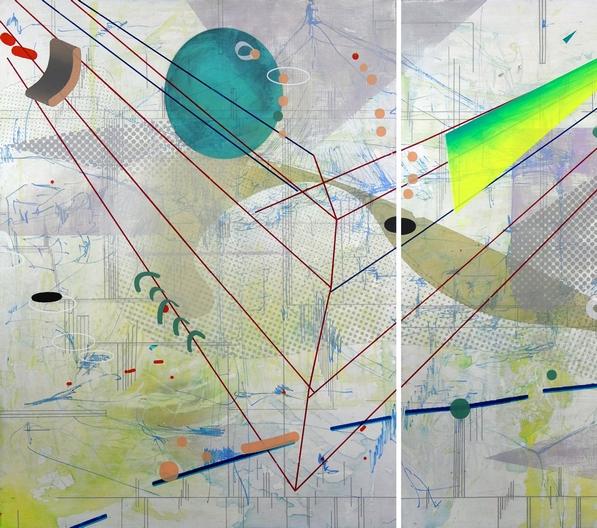
Special Edition scape Land CONTEMPORARY ART REVIEW
those institutions/galleries as sacred niches and altars.
I have been living in the US for almost eight years since my early 20’s. The American cultural influences definitely rub off on me such as free expression, independence and creativity. For quite a
while I don’t have a sense of belonging due to my relocation experience and/or my natural detachments. My whole family is still living in China but it seems like my life is here in the States ( study, work, relationships..). I think the physical experience of moving away from my roots inspire me to ponder deeply on my childhood experience

Wen Yu scape Land CONTEMPORARY ART REVIEW


as well as family influences and how those memory fragments shape who I am and the decisions I have made. And I always wonder what kind of life and person I would be if I didn’t come to the US because.In short, my intercultural experience does
not specifically direct my artistic style ( it is something unforeseeable) but slowly change the way I think, perform.
The body of works that we have selected for this
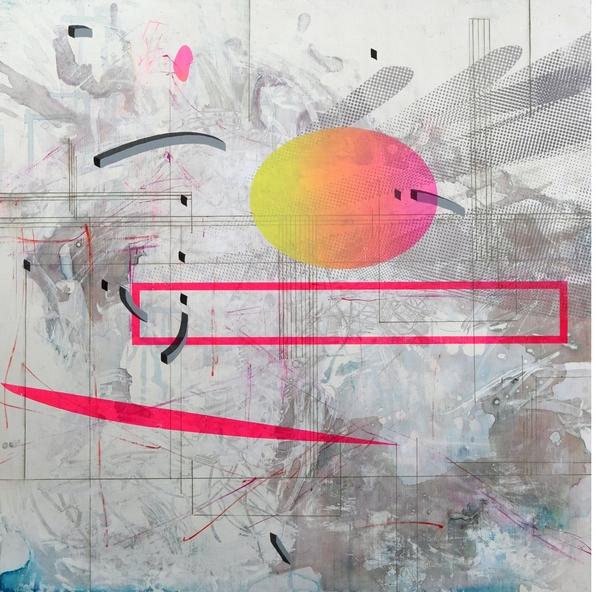
Special Edition scape Land CONTEMPORARY ART REVIEW
special edition of LandEscape and that our readers have already started to get to know in the introductory pages of this article has at once captured our attention for the way you provided your insightful inquiry into the idea of musical
score into work as a way to see the architectural rhythm with such autonomous aesthetics: before starting to elaborate about your production, we would suggest to our readers to visit https://www.wen-yu.org in order to get a synoptic

Wen Yu scape Land CONTEMPORARY ART REVIEW
view of your work. In the meanwhile, we would like to ask you if do you think that there are any central ideas that connect all of your work as an artist.
Coming from the background of a multimedia artist, my goal is to create projects that integrate art, story-telling and tangible material to evoke sensation through physical interaction. My works explore the line between mediums, the difference between mechanical and handcraft and the transition between 2D surfaces and 3D spaces.As a nonimmigrant visa holder who has been trying to
navigate through a new culture, language and place, my intention is to present the “manifold” through exploring physical and theatrical dimensions. I enjoy trying out new materials, languages and forms to express my concepts.
Your approach seems to be very analytical, but although your whole process is strictly controlled, you have remarked that you paint with an empty mind: how much importance does play improvisation in your process? In particular, once you have started to work to a piece do you like spontaneity or do you later schedule the details?

Special Edition scape Land CONTEMPORARY ART REVIEW
I make a rough plan before I start each piece and in between every procedure. I guess the habit is inherited from my dad who is a surgeon as well as my design background. However, I think a piece of painting (include the subsequent process) is way too subtle and sensitive that won’t be able to follow the plan strictly.
My plan serves as an instruction/ direction of my art-making methodology, although I do go back to the drawing board to review my original ideas often. It is like when you are listening to a classical music piece, you don’t care so much about the
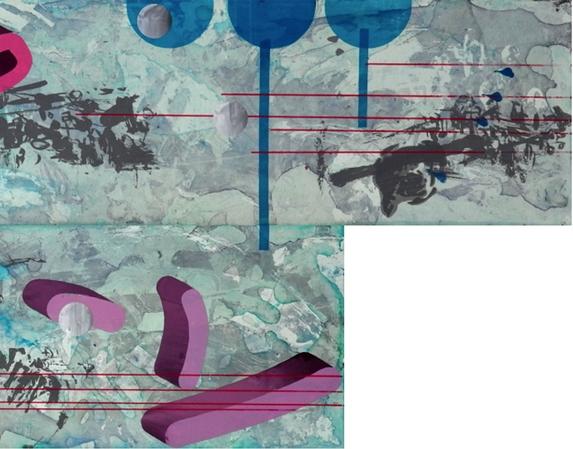
structures and techniques, but rather let the music follows into you.
Painting is a way of working in a system where every painting contains numerous layers that are carefully applied.For my lard-scale silk-screen pieces, I design the geometric patterns ahead of time in computer software, transfer onto screens and make hundreds of registration marks on panels. The laborious process ensures me to have the close enough design for my pieces. But sometimes I have let the controlling mindset go in order to allow the unexpected beauty of the handcrafts (errors and mistakes).
Wen Yu scape Land CONTEMPORARY ART REVIEW
We have really appreciated the relationship between such thoughtful nuances and rigorous sense of geometry :that marks out your artworks, that also show that vivacious tones are not strictly indespensable to create tension and dynamics. How did you come about settling on your color palette? And how much does your own psychological make-up determine the nuances of tones you decide to use in a piece and in particular, how do you develop a painting’s texture?
Actually, I like dark tones in my real life especially the gloomy color palettes. My photography is usually colorless. I go for a boarder range of palettes for my paintings because I simply like the freedom to choose between colors, to explore different combinations. I consider switching palette as a methodical game to challenge myself in order to come up with new solutions. In a way, it is totally random, in another way force myself to use the color I am not comfortable with. I also feel a strange satisfaction to go for the opposites just like similar situations I encounter in real life.
Textures are key factors to blend spectators into my works. I have a notebook with all kinds of textures I made as a way to practice. A notebook is a dictionary of textures. This is my way of learning technics of making marks and I imagine myself as a machine that is taught by a database. The process of developing marks/textures onto a specific piece is compatible with playing GO. You have to arrange your chess pieces in the overall layout with vision, instinct and care. Sometimes it is painstakingly to develop a mark with respect to the aesthetic quality, position and materials.
We daresay that your art practice also challenges an inner cultural debate between heritage from the past and traditions that carry on to this day: we like the way your approach creates such insightful synergy between Western and Eastern cultural heritages: as you have remarked once, your original inspiration was a combination of Bach’s fugues, traditional Chinese gardens in Suzhou and structural elements of post-modern architectures. Do you think that there's still a contrast between Tradition and Contemporariness? Or there's an interstitial area

Special Edition scape Land CONTEMPORARY ART REVIEW

Wen Yu scape Land CONTEMPORARY ART REVIEW

Special Edition scape CONTEMPORARY ART REVIEW Land
where these apparently opposite elements could produce such a proficient synergy?
I don’t think there is much difference between those elements and since they are equally important for my pieces. The ideas of tradition and contemporary are concepts defined by the linear history. They are defined in such way for the reason that it is close to our tradition of tightening knots to calculate the length of time. I believe the two seemingly opposite ideas are “spots” exist in different dimensions and potentially they could have limitless possibilities to pose effects on each other (1+1>2, 1+1=2, 1+1<2, 1-1 <2…). What I am trying to clarify here is to reject the idea of “opposite” for the reason that it is taking the meanings too literally. I suggest we think about the two concepts as spheres of a manifold that have the ultimate likelihoods to intersect, dwindle and/or grow.
You Must Build A Boat is a successful attempt to juxtapose the ideas of nonviolence protest and the tentative freedom: Mexican artist Gabriel Orozco once stated, "the artist’s role differs depending on which part of the world you’re in. It depends on the political system you’re living under". ". Not to mention that almost everything, ranging from Caravaggio's Inspiration of Saint Matthew to Joep van Lieshout's works, could be considered political, do you think that your works is political, in a certain sense? what could be in your opinion the role of Art in order to sensitize the viewers in our unstable contemporary age? In particular, would you tell us if you think that your being woman provides your artistic research with some special value?
I hesitate to use the word “political” because it sounds an overused works to me. There are a lot of artists working with political subject matters in China because of the influence of radical social-political changes of the country. Without a real understanding of “politic”, I consider those works as weak images. What I truly care about is the methodology and ability to convey an idea under a specific context.
It is political in the sense of being truthful. I am not denying the overwhelming political power imposing on everyone living in the society, but I do think there are many other perspectives to carve around, for example, individuality and commonality, I think the role of art

Wen Yu scape Land CONTEMPORARY ART REVIEW
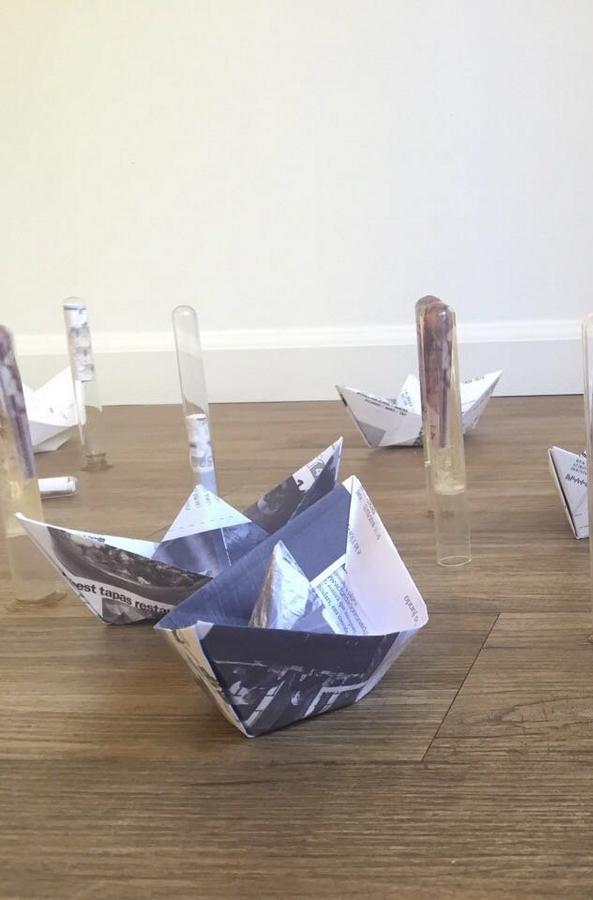
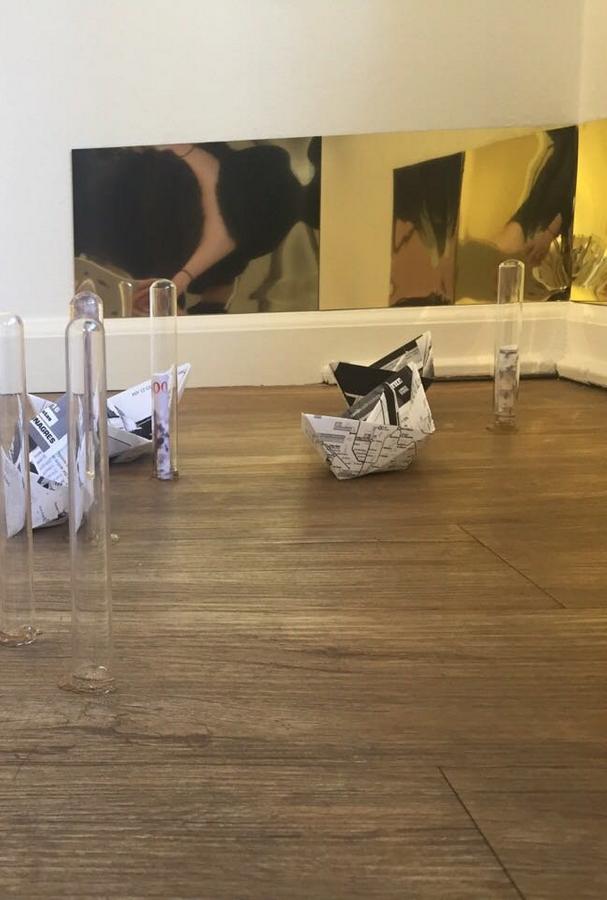
should be criticizing. Nowadays, art becomes a fancy lifestyle, a business and an adventurous experience that continuously be replaced. The value of art is diminishing and it becomes a type of craftsmanship please viewers. However art is a serious activity because it reflects the human society, it keeps us to be awake in the world without standards.
No, I think it is the same for all genders. Nothing special, everyone has their different personal approaches.
We like the ambivalent quality of You Must Build A Boat, a project inspired from your everyday observations while visiting and living in the city of Barcelona, that walks your spectatorship through the liminal area where the concepts of reality and

Special Edition scape Land CONTEMPORARY ART REVIEW
the sphere of imagination: how do you view the relationship between reality and imagination playing within your works? In particularly, how much everyday life's experience does fuel your creativity?

I observe my life and soundings intentionally. I am sensitive to the details of people, architectures and natural environments. There is a Chinese saying,
leave it open-ended, which describes a person expresses himself/herself in an ambiguous style. I am that kind of person in life. So it is natural for me to transform my life experience into something different in order to avoid the direct translation. I also believe there is a universal sensibility in great works regardless the change forms. I would like my work to be at that point.
Wen Yu scape Land CONTEMPORARY ART REVIEW
But what is “everyday life’s experience”? To me, it relates to physiological activities and philosophical reflections, not so much about the immediate emotion and circumstances. I am looking at the residues remains on the filter paper.
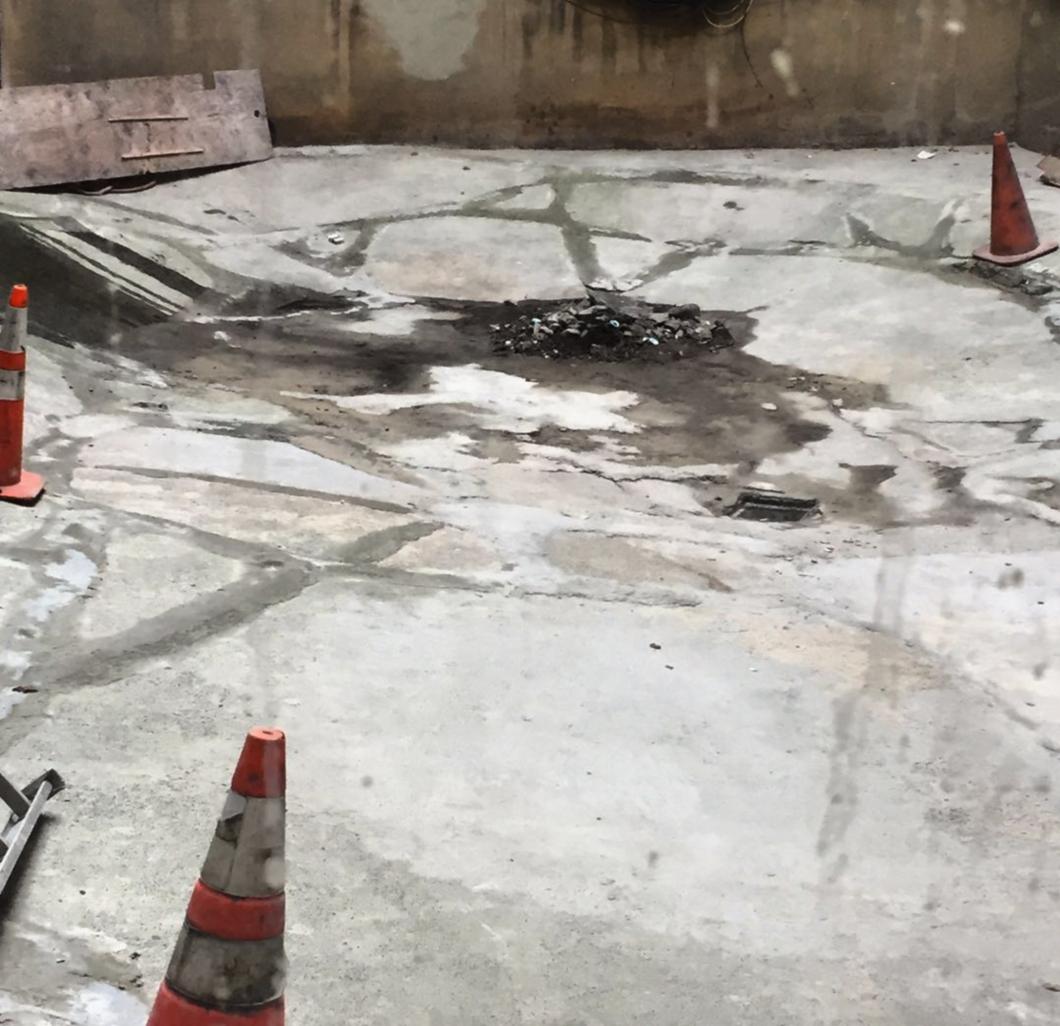
We like the way, rather than attempting to establish any univocal sense, you seem to address the viewers to elaborate personal associations:
would you tell us how much important is for you that the spectatorship elaborate personal meanings?
I care a lot whether they could feel the way I feel, response to the feeling I am offering. Although it is such an individual experience, as I talked previously, I believe the universal sensibility exists in art which is deliverable. For instance, sex, in general, is a
scape Land CONTEMPORARY ART REVIEW Special Edition
good feeling to everyone. But everyone has different preferences to make the experience individual to them. That is what the spectators should build upon in addition to what I strive to convey.
Over the years your works have been showcased in several occasions and you are going to have a solo at the Piano Craft Gallery, in Boston. One of the hallmarks of your practice is the capability to create direct involvement with the viewers, who are urged to evolve from a condition of mere spectatorship. So before leaving this conversation we would like to pose a question about the nature of the relationship of your art with your audience. Do you consider the issue of audience reception as being a crucial component of your decision-making process, in terms of what type of language is used in a particular context?
I contemplate about the reaction of my audiences in different phases of my process. Nonetheless, there is an unavoidable a gap between you and the spectators. In general, I am not giving up the opportunity to explore methods to engage people. Somehow the process is similar to teaching- help them gauge a new logical system they are not aware yet. And language is just the carrier of information.
In terms of the language itself, I get the influence from my mom, who is a professor in English literature. I was underexposure of western context and narrative from an early age because of my mom was always trying to teach me not only the language, but also the history, culture and custom. What fascinates me from early on is the orthography of the English language, which you can spell words by the sounds pronounced. Doing such thing in Chinese is impossible. The languages I am using in my art is a modular construction method that put essential fragments of information together to reach an developed concept. In such way, my approach is closer to the western rhetoric tradition. In addition, my Chinese background provokes me to embed “Chi” as intangible element, which is a flow of spirit that enhances the state of mind, within my work.
Thanks a lot for your time and for sharing your thoughts, Wen. Finally, would you like to tell us readers something about your future projects? How
do you see your work evolving?
I am working on a photography and drawing project called “Killed by Jupiter”, which is an observation of life, sexuality and potential research on astronomical phenomenons. I enjoy the title of the project because it feels so tragic, erotic and mysterious. There are many interesting scientific facts of the planet Jupiter, for example, it is a gas giant doesn’t have a true surface to be landed and the composition is similar to that of the Sun. In Mythology, Jupiter is the supreme god of the Roman pantheon, who distributes laws, controls the realm and makes his will known through oracles. The masculinity and vulnerability appear at the same time that intrigue me to interpret the scientific phenomenon into artistic imagination.
I am also doing some mixed media works with stones. The project shows the trajectory of what “I” picked out from my cognitive system and how much of them get translated and be allowed spectators to enter. It comes from three pieces of information: the artificial rock hills in Classical Chinese gardens, the visceral visual experience of eating surrey videos with my dad in my early childhood and the coexisting detentions. The project t is a combination of 2D works and installation that reflects the microscopic human body, erosion of time and subtle transitions of different dimensions. The project shows my interest in natural elements, mythology and topology, which is demonstrated through the drawings, collages and personal photographs and further connected by shades, lines, grids and dots.
My residency in Spain this August will be an interactive project that offers a blending experience of computer programming, story-telling and puppet design collaborate with kids and adults in finding opposing ideas/forces in daily life and twisting the fixed thinking path. I am going to involve the project with artists and engineers in the US and hopefully with people around the world.
An interview by Josh Ryder, curator and Katherine Williams, curator landescape@europe.com
Wen Yu scape Land CONTEMPORARY ART REVIEW
Linda Persson
Over the last 4 years I have occupied the role of the
female explorer going to desolate landscapes, to questioning measured science and history of archive and knowledge production as we know it by putting the [female] body in motion. I recently went to the Australian desert and the opal mining industries to look at landscape / stones / before and after human interference. It’s a film that uses economic, colonial, ecological, gender concerns juxtaposing unlike images forming a sort of radicalism by using imagination as method.
http://www.lindapersson.org/ http://thelastwoman.moonfruit.com/ http://5months.moonfruit.com/news-month-by-month/4581073543
 Linda Persson is a Swedish artist living and working between Sweden and United Kingdom
Linda Persson is a Swedish artist living and working between Sweden and United Kingdom
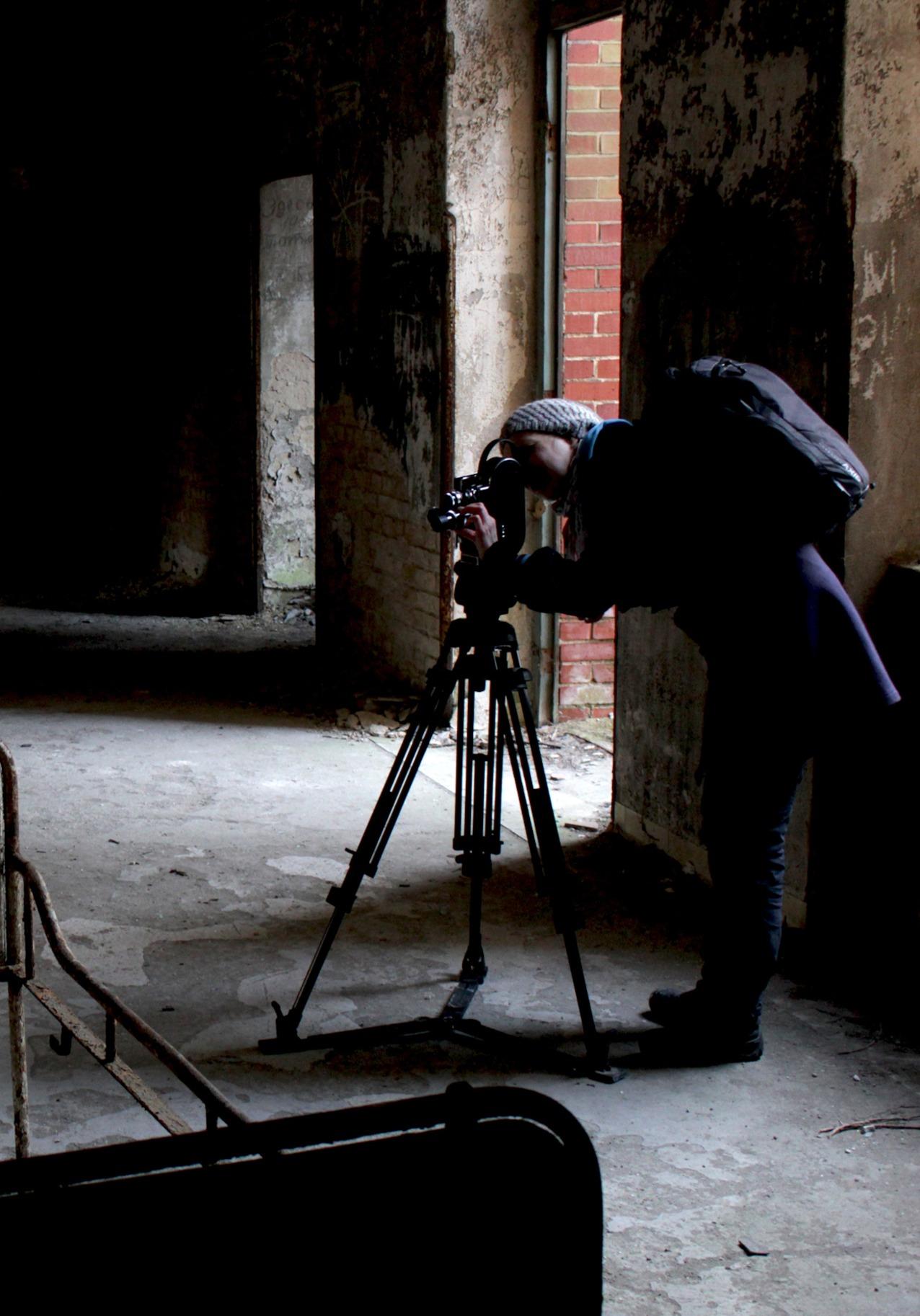
LandEscape meets

Linda Persson
Multidisciplinary artist Linda Persson's work rejects any conventional classifications and is marked with freedom as well as rigorous formalism, when encapsulating a careful attention to composition and balance. She questions our contemporary society of economic growth ways following a close examination of reality, yet refusing traditional features that mark out documentary cinema: in an age in which globalisation and commodification impinge on every aspect of our lives, Persson uses her kaleidoscopic approach to investigate about language, mobility, and transformation. One of the most impressive aspects of Persson's work is the way it accomplishes the difficult task of unveiling the ubiquitous connections between microcosm and macrocosm: we are very pleased to introduce our readers to her stimulating and multifaceted artistic production
Hello Linda and welcome to LandEscape: before starting to elaborate about your artistic production would you like to tell us something about your multifaceted background? You have a solid formal training and after having degreed with a BA from the Chelsea College of Art and Design, London, you nurtured your education with a MFA from the prestigious, Winchester School of Art, Southampton University. How do your
scape Land CONTEMPORARY ART REVIEW
An interview by , curator and , curator
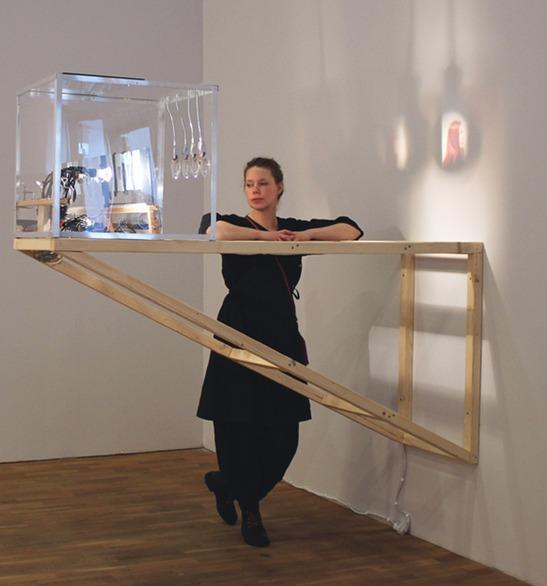
scape Land CONTEMPORARY ART REVIEW
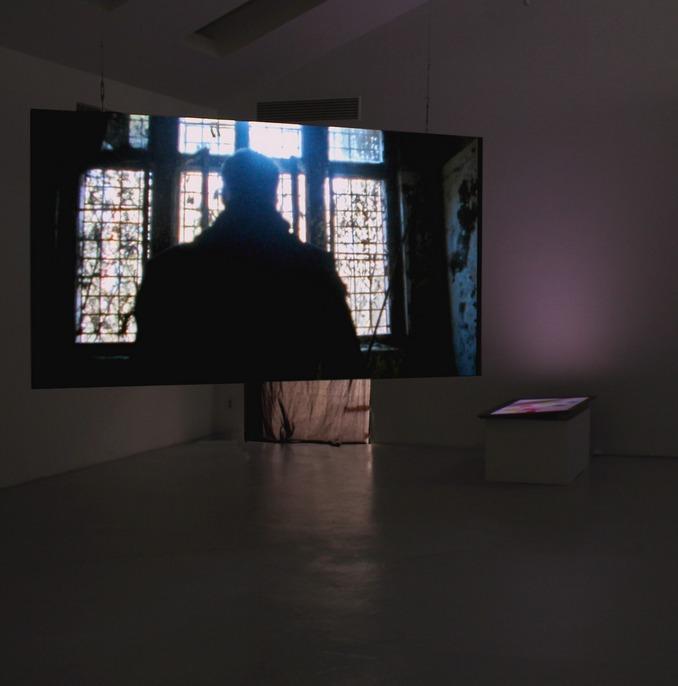
scape Land CONTEMPORARY ART REVIEW
Linda Persson
studies influence your evolution as an artist? And in particular, how does your cultural substratum inform the way you relate yourself to art making and to the aesthetic problem in general?
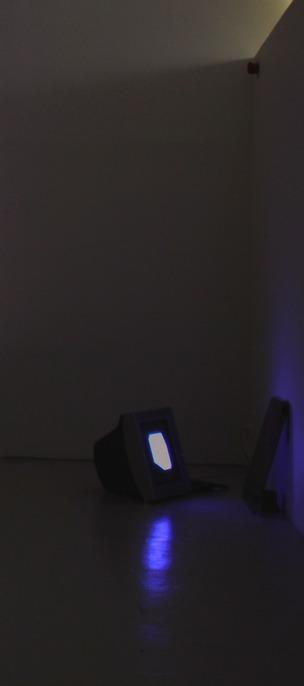
Hi LandEscape Art Review, thanks for having me.
I like that you use the word substratum to form the question to connect cultural and aesthetic, as it means an underlying layer, specifically a layer of rock or soil beneath the surface of the ground. One could use that meaning to describe my practice; it is a careful yet inquisitive handling of materials and information that takes place within an embodied relation to archival and historical data through the actual experience of landscape. I'd like to think that my relation to culture is similar to the way that indigenous cultures often talk about culture. That it is alive and therefore more complex, as one can't easily divide it into past, present and future as in the Western tradition. It's instead all of this, entwined, simultaneous and ongoing, living. As Russell Means (also known as Oglala Lakota) said "Indigenous epistemology is fluid, nonlinear and relational. Knowledge is transmitted through stories that shape-shift in relation to the wisdom of the storyteller at the time of the telling."
I have had an extremely nomadic life both by coincidence and by choice. It has accentuated my understanding of white privilege despite being a woman and from a working class background. Leaving Sweden for the UK in 1999 was a choice of possibility for a different future, as the EU accession treaty happened in Sweden 1995, and so studies abroad wouldn't incur hideous costs for me as a student, I could do it even though I didn't come from or have any money. Being situated away from the country where you were born can assist in questioning the notion of belonging and helps
Linda Persson scape Land CONTEMPORARY ART REVIEW
one to see how the system of language relates to cultural behavior, e.g. how the dominant noun-based nature of English language accentuates the outcome orientation of the world. Being a 'foreigner' creates both a sense of loss and a sense of freedom. I studied at Chelsea College between 99-02 at the sculpture department. It was great as there were so many foreigners, cultures, languages, behaviors, crashing into each other and at the same time one had to follow the rigid English academic system. Following my BA I later applied to Winchester School of Art, as I was very keen to gain access to the ISVR INSTITUTE situated in Southampton University. ISVR stands for the Institute of Sound and Vibration Research. It's a scientific department that investigates the impact of frequencies, vibrations around us, and how this also can be used scientifically for example in warfare etc. This wasn't totally supported by the arts department, but I learnt and experienced a lot, both in navigating the academic rules as well as shifting my practice, pushing the boundaries of making art within a quite conservative set-up, but I exited with a first class distinction. Winchester had a great moving image library with lots of footage available that would have been hard to access anywhere else due to loss or the neglect of certain artistic experimental practices. At Winchester I first encountered Michael Snow's work, Meredith Monk, Mary Lucier, as well as transgender, LGBT and hermaphrodite rights through writings in theoretical academic work, music and video recordings; and it all fully unlocked my interest in things seen as peripheral, marginal and 'other' (but that shouldn't be).
In 2011 I moved back to Sweden as I had been accepted to the Mejan Resident programme at the Royal Institute of Arts in Stockholm. I did an artistic research year there using the thoughts of Derrida and in particular his

scape Land CONTEMPORARY ART REVIEW
Linda Persson
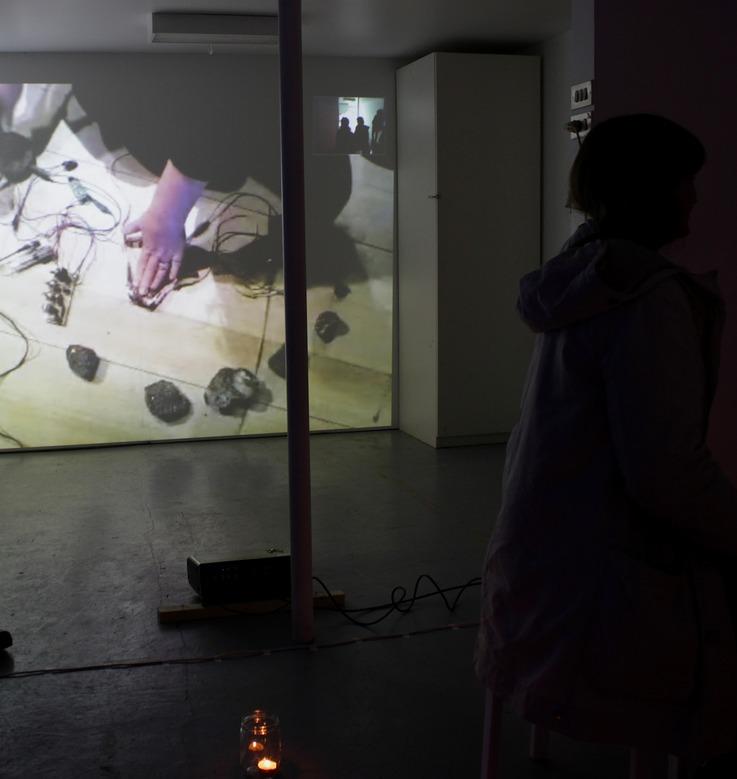
scape Land CONTEMPORARY ART REVIEW
Linda Persson

scape Land CONTEMPORARY ART REVIEW
Linda Persson
writings on the spectre/ ghost to try and expose conventionally defined connections between the physicality of an artwork and the space and movements that produce and reiterate it by trying to devise new associations in-between. I used the place of Berlin and specifically the Berlin Wall and its historical trauma between East and West, looking at it as an object, withdrawn from its history but at the same time historically reiterated in space as one thing, neglecting the nuances of living through these times. I became acquainted with Beelitz, a suburb of East Germany, a forgotten place which became the protagonist for cinematic experimentations through celluloid film and high definition digital technology to set those two types of entropy against each other: digital entropy and physical entropy. It really forced the question of bringing the body back into action and to reinforce a physical and cognitive memory alike. This work became an immersive multiple moving image and sound work called CHromaTiC AdaPTation MATriX, an umbrella title for the various works that is taken from the chromatic scale that transform the colour to be read accurately from screen to eye as part of the system in a MAC computer.
You are a versatile artist and over these years you have gained the ability to cross from one media to another: your approach reveals an incessant search of an organic symbiosis between a variety of viewpoints. The results convey together a coherent sense of unity, that rejects any conventional classification. Before starting to elaborate about your production, we would suggest to our readers to visit
http://www.lindapersson.org in order to get a synoptic view of your multifaceted artistic production: while walking our readers through your process, we would like to ask you if you have you ever happened to realize that such

CONTEMPORARY ART REVIEW
Linda Persson scape Land
multidisciplinary approach is the only way to express and convey the idea you explore.
No, having a multidisciplinary approach is absolutely not the only way, but it is a way that I use and feel most engaged with now. As I said earlier, my practice is fluid and nonlinear and it's directly related to place and experiences of relations, but it simultaneously interweaves academic western vernacular, wanting to challenge the hierarchal systems in place. And it's a troublesome task of crisscrossing cultural epistemologies. It’s about paying attention to our discomfort as this can be an indication that we are feeling the tension that coexist when one is going against the grain.
My thinking and making goes through different materials and processes and I am, by putting my body in motion to go to places and landscapes, given experiences by actually moving, and that is quite a radical thing in itself, and this forms my visual output. I pick up on things related to our senses like smell, light and dark, dry or moist sonic atmosphere, which are all deeply sensorial and experiential. It's not just about responding to the things already in existence but bringing to the fore the absences in the produced worlds. This can create hard-to-follow image sequences or mediums being chosen, yet, if successful, it can create curiosity or better a sense of euphoria. Our world shrieks of mobility, interaction, exchange, flexibility however it only applies to a fair few, but mainly it applies to money. Actual moving bodies have created new walls to be built, harsher entries and exits from and into certain countries. My relation and use of material goes hand in hand with my movements. The 'immateriality' of the world is highly material, everything connected to immaterial labour and its affect is rooted in
the use of the digital domain, Internet and so on. These things are directly connected to the earth, soil, the universe- we mine heavily around the globe to access rare minerals that foster and grow our 'immaterial' affective uses. Without gold, copper, radioactive components, coltan (columbite-tantalite) we wouldn't have the immaterial world nor the material world. It's all connected. The connections should be further merged and heightened rather than separated into pockets and disciplines where we lose sight of the connectivity. Therefore this 'moving through landscapes' is a very important component in my artistic practice.
For this special edition of LandEscape we have selected Zeus Tears, that our readers have already started to get to know in the introductory pages of this article. What has at once captured our attention of this interesting transdisciplinary research project is the way you provided the visual results of your analysis with autonomous aesthetics: when walking our readers through the genesis of Zeus Tears, would you shed light on your usual process and set up?
Over quite a few years now I have incorporated a role that could be compared to the female explorer. I've been going to desolate landscapes to question our relation to measured science and our history of archiving and the formation of knowledge production as we know it by putting the female body in motion. The prompt for this work started with my interest in landscape and its relation to the human body and time. Landscapes sometimes acquire a reputation of being cursed or where people claim to have seen aliens. Lighting Ridge in New South Wales, Australia is one of these places. The research I was concurrently
CONTEMPORARY ART REVIEW
Linda Persson scape Land

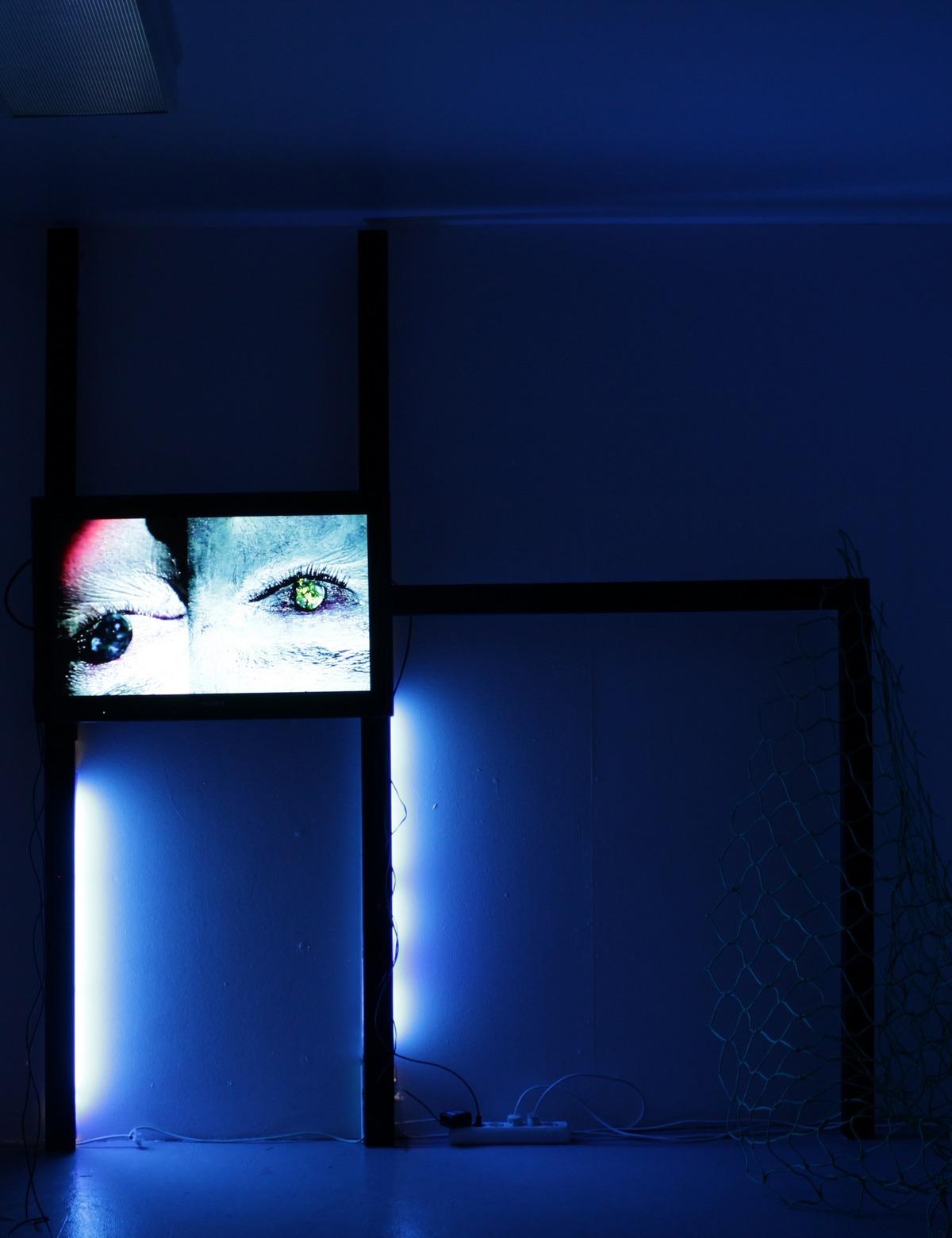
undertaking in Sweden a few years ago, was about a well known cursed island on the east coast of Sweden called the Blue Maiden, on which the stones hold a curse. By studying the early myths and legends around this island I also came across other mythical stories related to sea and stones such as black opals. These were said to also have been the tears of Zeus when he sacrificed his son to not lose his power. So I looked up black opals and found that they only exist in this particular place in Australia called Lighting Ridge (original name Warrangulla). It got its name in 1906 when the first farmer settled with his 200 sheep, only to be struck by dry lightning, which killed most of the stock and the family. Now, people live there and dry lightning does happen. This is a necessity for the opals to be formed. They need water and high charge electricity, instant heat, to then form beautifully over thousands of years. In this way they form in relation to the ironstone base and together with silica and water (like the method of making glass) the opals form particular facets that can diffract light in the most magical way. As I have incorporated both old and new technology in my earlier work, the way I make film, merging celluloid with HD or when I construct devices such as hand built projectors collapses different time aspects and I had this idea that by using an opal stone I could make a lens for a projector that could show time, slow and deep time, geological time as the black opal has had thousands of years in its making but still carries a high content of water and therefore potentially still is a changing life form [theoretically], especially as water is connected to life, both scientifically and symbolically. By shining light through a rotating opal gemstone, a projection of geological time would emerge at the same time using its colour
diffractions as way to produce colour (like a DLP projectors mirror rotation via RGB colour system). So in 2015 Sep/Oct I was going out to Brisbane for a residency / workshops with the IMA gallery and I made sure I was able to hike out to NSW, where I spent 8 days on a bike and in an old mining shed converted to an artists house called Sunsiz Media. I wanted to learn more about the traditional owners of the land, the Yuwaalaraay people and the opal industry. As with many other indigenous groups around Australia the Yuwaalaraay people were displaced. However I met a few Aboriginal people who lived / moved back to Lighting Ridge and I asked about their stories. The Rainbow serpent is a famous Tjurkurrpa story and it was said that in the past one didn't stay in Warrangulla country, it was a significant place but also full of magic. The serpent could be seen throughout the landscape and that country was not to be disturbed. Another songline story describe that the opals where the result of a huge wheel of fire which fell to earth and scattered the landscape with brilliant coloured stones. So both in new and old times the landscape has magical attributes shaped by the force of nature. The film Zeus Tears is part of a larger context, inspired from the landscape, the myths and physically being there. The protagonist in the film is two-fold, the opal and the ghost, something human-like visiting from the past to disturb the current mode. It plays with the delivery of words in connection to the images, so sound and text is out of sync. The landscape appears to be alive through different camera techniques followed by differently pitched image layers through editing. The sound design became an important part of the work where sonic recordings of the colour vibrations from
CONTEMPORARY ART REVIEW
Linda Persson scape Land
the opals have been developed to feature as soundscape. There are also some footage in the film shot in Queenstown Tasmania and nearby ghost towns like Crotty and Linda. I've also included some aquatic scenes from Moreton Bay Sea nature reserve on the Gold coast. So it's merging different landscapes and different histories.
The film was first shown in Iceland in Seydisfjördur Nov 2015 alongside a timecollapse performance that I execute with the Tasmanian Hobart based artist Pip Stafford. She builds electro-magnetic devices that can react sonically to minerals that she amplifies and create sound from. This has been a collaborative experiment to force out actual experiences of time in space from different parts of the globe simultaneously and is something we are developing through ideas of ritual, magic and feminist methodologies. Throughout November 2016 Zeus Tears was screened in Elävä-Pori in Finland (a window display next to a car park in north of Finland). I am still working on a larger context for this work to include the opal projector and photography to create a greater immersive experience.
As you have remarked once, Zeus Tears is a film that uses economic, colonial, ecological, gender concerns juxtaposing unlike images forming a sort of radicalism by using imagination as method:
Imagination is a tool that is disregarded as a methodological tool in Western systems. In other cultural environs the inclusion of dreaming and imaginary properties are important cornerstones to develop inventive solutions that support the social and living systems, ecological thinking and certain progression. By not following a heteronormative system my research falls alongside indigenous, queer and feminist

Land CONTEMPORARY ART REVIEW
Linda Persson scape

scape Land CONTEMPORARY ART REVIEW
Linda Persson

scape CONTEMPORARY ART REVIEW Land
Linda Persson
methodologies. By using the female body in motion, I mean my own body with movements through foreign landscapes, I highlight the notion on white privilege, as I am a white person from Sweden, and so it is easier to enable border crossings. But at the same time being a sole traveller as a woman is challenging as it disturbs the ideas of the male conqueror and exposes power relation between gender hierarchies which can be noticed from both men and women that I meet through the journeys. I think this is because our patriarchal system is so embedded in our way of seeing the world, wired into our systems to promote outcomes, goals, progression and economic growth. Using the female body always makes a relation to sexuality, like it or not (also part of a certain political landscape), however this film has over and over given me feedback from women saying that it really speaks to them in a more real way of connecting sexuality and being a woman. It does not show the stereotypical female body but rather uses the body as a tool to speak of its power, strength and sensibility through certain movements and repetitions. And by using harsh landscapes from the outback, active and dead mining settlements as well as the products at task, it tries to connect past, present, future in quite challenging set of image sequences, captured first hand, not trawled online. It activates and creates other ways of looking at the overlooked, or even questioning the idea of image making, by actually putting things in movement in an embodied way. It doesn't mean archives and collected data are useless, for me it acts as ignition, a force to find out more, to resist the academic visual vernacular that so prominent in the (art) world, and instead enable a reconnection of the margins. As

Linda Persson scape Land CONTEMPORARY ART REVIEW
the work doesn't follow any rules it is challenging and requires a certain 'letting go' from the audience. Seeing some things for the first time, yet also something familiar is a spectral experience. The way I work is also challenging for myself and it surely gives me new eyes every time. Sometimes it fails on several layers but that can also become an important part of forming something unexpected and radical.
Zeus Tears was shot the Australian desert: what was the most challenging thing about making this film?

That I was on my own. No camera man, no assistance. But that is a usual way for me. It opens up connections with others and with landscape on ones own terms. But it is hard to be in front and behind at the same time. Even that forces the body to be engaged either through constant moving or through a form of passivity, letting time pass. Visual opportunities get lost due to being alone, which is part of the experience and eliminates sensational imagery. The limits set the outcome in one way and opens up another way of responding creatively to place through other means than film, photography. I often work with very small or non-existent budgets. There is no recourse to revisit or redo. So within the framework set out, the work created becomes part of time and chance, allowing the unexpected to take place. And as always in outback Australia, one has to get used to coexist with emus, snakes, spiders and dingos. And cows. And flies.
Do you think that your being a woman provides the way you question our contemporary society of economic growth with some special value the way, with some additional meaning?
Linda Persson scape Land CONTEMPORARY ART REVIEW
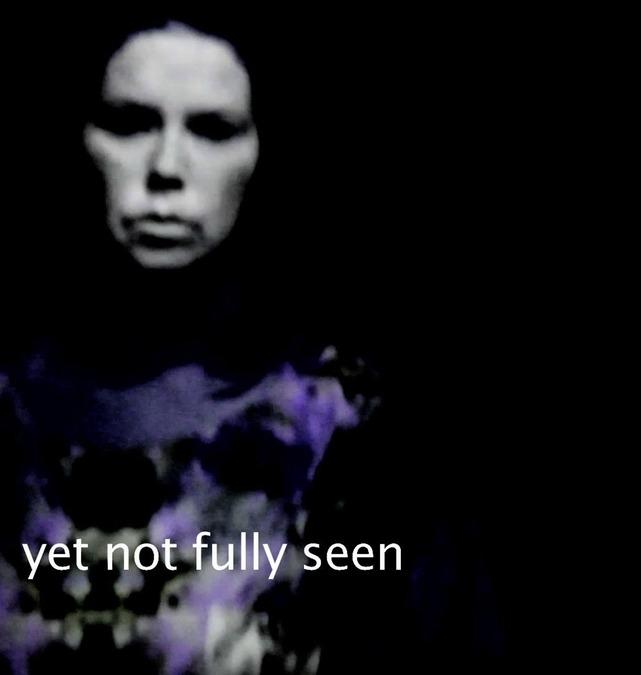
scape Land CONTEMPORARY ART REVIEW
Linda Persson
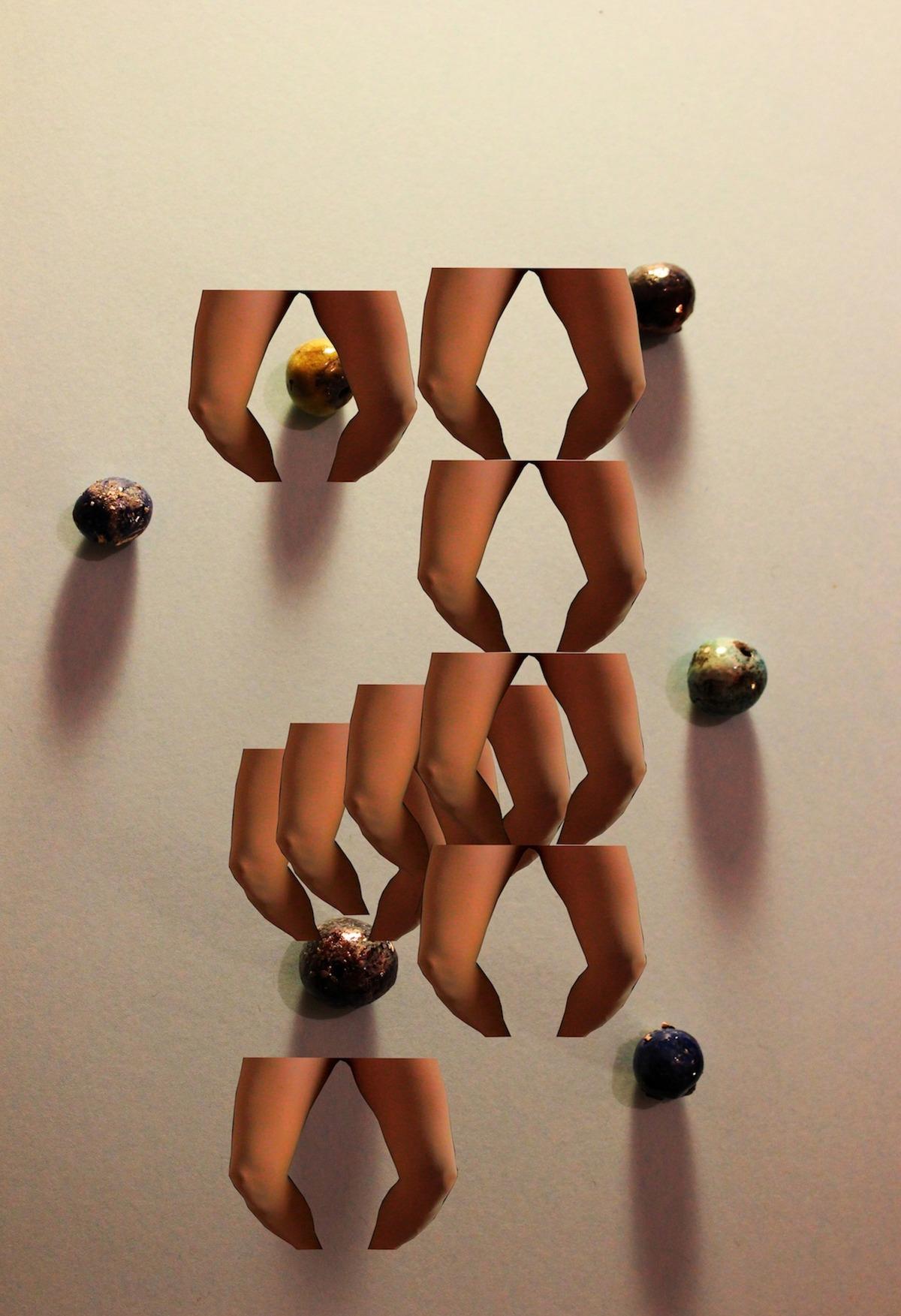
Well, I couldn't do it any other way as I am a woman and have grown up in a gender specific society. By legitimate indigenous and feminist methodologies in our systems at large, I think we can get to a point where focus could shift and things could change. So yes, it does create additional meaning as it questions the white male supremacist society we live in, from the other side.
Another interesting work from your recent production that has particularly impressed us and on which we would like to spend some words is entitled The Astral Women: what has at once captured our attention of your inquiry into ritual, shamanistic, witch procedures is your successful attempt to produce a dialectical fusion that operates as a system of symbols creates a compelling non linear narrative that, walking the thin line between conceptual and literal meanings, establishes direct relations with the viewers. German multidisciplinary artist Thomas Demand once stated that "nowadays art can no longer rely so much on symbolic strategies and has to probe psychological, narrative elements within the medium instead". What is your opinion about it? And in particular how do you conceive the narrative for your works?
I think it's important to understand the medium(s) one works with and why the medium is chosen for a specific work. Thomas Demand’s work is really staged and plays with showing the 'fake' as the 'real' when setting up his 'nearly perfect' paper cut out models to be photographed, which exposes the gap between truth and fiction in his material. For me it rarely starts with medium or material but instead I focus on place or myth that shapes the medium for
the work, however the medium chosen often negotiates its own internal usage and possibility or as a failure. I have a very broad skill set and materials shift between processes. The research, the material probing; for example transferring an image to become a piece of clothing used in performance or film, or extracting the sound vibrations that become the films sound narrative, are all important parts that help build the work. However with The Astral Women I wanted to work slightly differently and made certain decisions prior to filming e.g. that it was going to be shoot on 16mm celluloid as a single channel film and that I wanted my aunt who is a comedian / actress in Sweden to be the main witch. Conceptually I was interested in the connection between capitalism and superstition that forms the reality around the Blue Maiden with its cursed stones that people take only to be sent back to the borough once bad luck is experienced. Hundreds of stones every year get returned and are currently building up as an unwanted archive. I was also keen to unfold the birth of the word 'witch' that gave effect to the social construction to give power to control the female body, its knowledge and so on. When I first went to do some research before filming, I had no luck getting to the island as it’s very weather dependant to be able to access this place. So instead I spent quite sometime with a historian Thomas Gren, who was working for the borough to where the 'cursed' stones get addressed, and he told me the history of the island and its short time as a quarry as well as its export link to Germany. So his voice is part of the film constructing a sense of documentary even though the film is fictional, this part was shot on HD. The Astral Women also uses ritual modes as
Linda Persson scape Land CONTEMPORARY ART REVIEW
actions for the protagonist witch to return some real stones that have given people bad luck, so the film actually combines 'real' rituals to relieve peoples’ bad luck and a fictional ritual within the film narrative. The choice to shoot on film was to limit the production of image making on 4 rolls = 12 min. So each stage needed planning and careful set up. The film was shot over 1,5 day.
The Astral Women has, on the surface, a seductive beauty: however, it is marked out with a deep socio-political criticism that runs throughout all your works: while lots of artists from the contemporary scene, as Ai WeiWei or more recently Thomas Hirschhorn and Jennifer Linton, use to convey open socio-political criticism in their works, you seem more interested to hint the direction, inviting the viewers to a process of self-reflection that may lead to subvert a variety of usual, almost stereotyped cultural categories. Do you consider that your works could be considered political in a certain sense or did you seek to maintain a more neutral approach? And in particular, what could be in your opinion the role that an artist could play in the contemporary society?
I do think that today any kind of image making is political. We are in a moment where production of images is very ubiquitous and user-generated through various social media applications, but my focus is on the specificity of image-making and how making it into art can simultaneously question the status of the image and challenge it. What is expected of an artwork today? I ask myself this question and I often let the work that I produce respond or react to its own context. Seductive beauty, imagination and fiction can probe much deeper than open socio-political

scape CONTEMPORARY ART REVIEW Land
Linda Persson
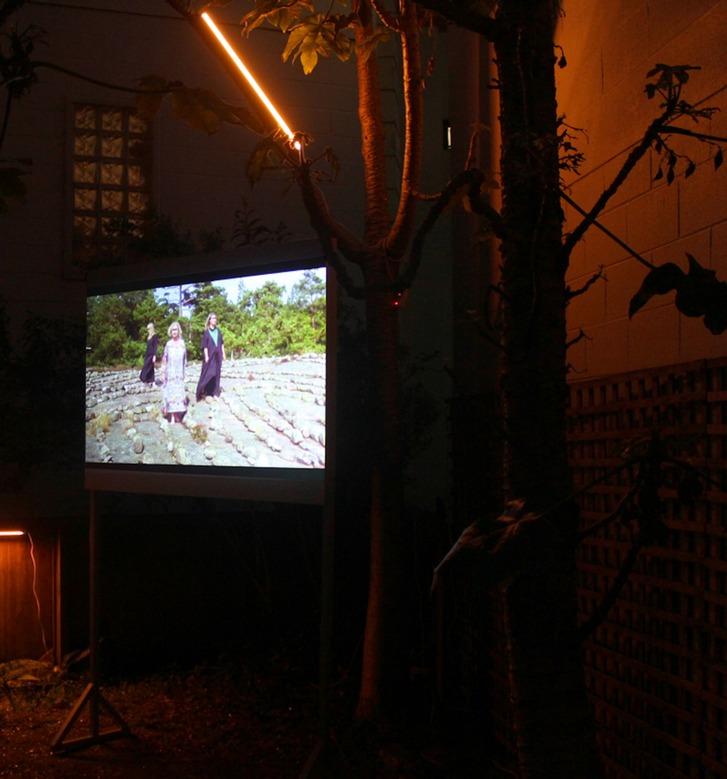
scape Land CONTEMPORARY ART REVIEW
Linda Persson
statements as it allows people to absorb and feel through something rather than being told specific 'truths'. I would never feel that I could tell anyone how to think or feel about anything, I am not a preacher nor a politician. Saying that, I have strong personal political views and through my
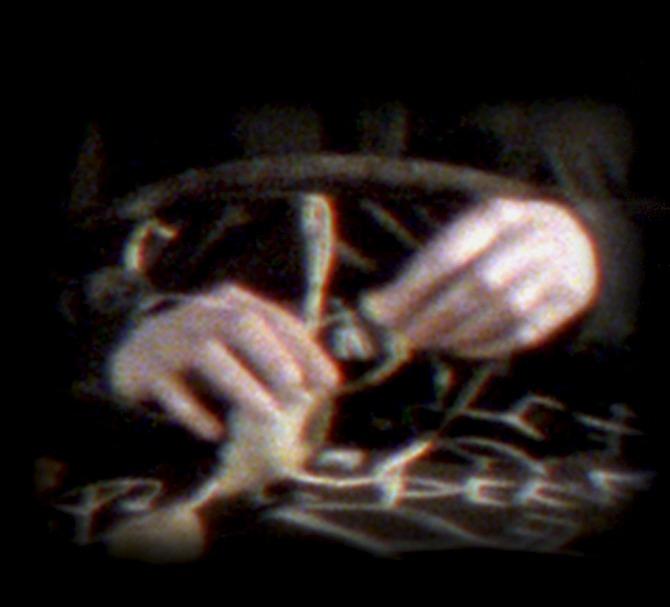
work I try to challenge myself as much as challenging anyone else, to ask questions rather than providing answers or opinions.
Your work in general, and in particular your Borderlands series provides the viewers with an immersive experience:
scape CONTEMPORARY ART REVIEW Land
Linda Persson
how do you see the relationship between public sphere and the role of art in public space? In particular, how much do you consider the immersive nature of the viewing experience in your process?
When I build installations, to put the work on show, I'd like to transfer some of my experiences
of the processes through spatial engagement from travelling, landscapes and places. I don't expect anyone to just be a spectator or a consumer of art. By setting out a movement strategy based on the installation of the work, forces the viewing body to actively move into and around the work, emphasizing to look at things differently. This is to trigger the notion of body as experience and not only as a receiver. Borderlands series is a photographic work shoot whilst researching for my work around and with Sámi culture called Nuortabealli (Sámi for shadow from east at winter night, 2014), up in Nordkapp / North Cape, the very north of Norway. The images show a fence that separates the furthest point of Scandinavia and the North Pole. What was striking spending time up there was the numerous of busloads of tourists entering a magnificent 'end of the world' border, with little to no interest to actually look around except for seeing the art monument, the café and see a film about Nordkapp / North Cape. Its surrounding nature seems to remain invisible and is instead hijacked by culture to mainstream the experience, which is often too much the case for 'public' outdoor art. The Borderlands series photographs shows this lack of empathy and rather spurious claim to the place made visible through what's left behind; human rubbish molded by weather and wind into the fence. This is probably my most conventional set of works as displayed in a row on the wall, five A2 sized giclee prints on Somerset paper with ripped edges, appearing to float on the wall using magnets to hold the work, to emphasize a temporality and vulnerability by being unframed and unglazed.

CONTEMPORARY ART REVIEW
Linda Persson scape Land
One of the hallmarks of your art is the capability to create direct involvement with the viewers, who are urged to evolve from a condition of mere spectatorship. So before leaving this conversation we would like to pose a question about the nature of the relationship of your art with your audience. Do you consider the issue of audience reception as being a crucial component of your decision-making process, in terms of what type of language is used in a particular context?
The audience will always be considered to respond to the way of how I try to engage with the world, by looking differently at things, especially in my installations and more recently in my performance works. I have moved my practice into performative works that are semi-installations explored through characters that are influenced by ancient folk traditions, mythical / magical bearers and legends, merged with more recent historical environs.
This is something that has developed through my extensive travels as art and research to outback areas, through indigenous land, where I have looked at industry, technology progression and tourism in its relation to old knowledge and landscape. What it does for me is two things:Firstly, it merges myself with my work, living it as it happens and acknowledges the experience as one thing that is not divided into categories such as art and research. Secondly, language and behaviour is the structure in which recouped ancient knowledge can be used to reroute the way we live and think about ‘progress’ and economic growth. I use ‘magical’ choreography through performances that use multisensory bodily
engagement, through both the landscape and with the audience.
Thanks a lot for your time and for sharing your thoughts, Linda. Finally, would you like to tell us readers something about your future projects? How do you see your work evolving?
Over the last couple of years I have worked more making objects using ceramics. Clay is a very versatile material. To me clay is as much technology as nano equipment. It also holds strong mythical and healing properties, such as mud baths to heal rheumatism or the story of the Golem. The work I've made with clay has become props for performances such as flutes or part of costumes or performative objects such as the piece Eidola currently exhibited at Luzern Kunstmuseum in Switzerland as part of Laure Prouvost's exhibit 'Higher grounds..' until Feb 2017.
I have just come back from a 2 months residency out in the outback Australia, spending time in the Western Australian desert goldfields area. This project will be developed further during next year for a larger touring exhibition 2018/19.
I am also continuing my work at the Blue Maiden but through a 2 year project run by an archeologist and professor Bodil Pettersson at the Linnéuniversity with focus on 'Experimental Heritage'. Thanks for your interesting questions and for giving me so much space to elaborate on work and processes.
An interview by , curator and , curator
Linda Persson scape CONTEMPORARY ART REVIEW Land
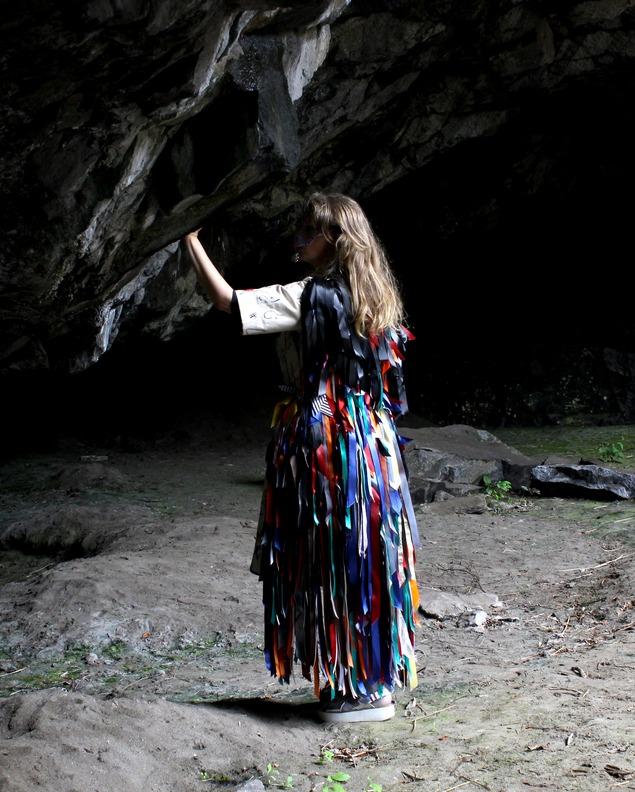
Ilinca Bernea
Iconceive humor as being situated at the contact surface with the sublime. I practice all arts but music. I have released several performances in the
last three years, created with students in choreography and philosophy.
The two aesthetic coordinates of my creations are humor and melancholy. I put myself in the position of the Shakespearean jester, whose sense of humor is meant to dislocate an equal amount of sadness, bitterness and longing.
I am addicted to cats and music. I am a big fan of the feline temperament, which has many contrasts, such as: the fast transition from a state of calm and quietness to the attack position or from a sleepy mood to extreme vigilance etc.
I believe in beauty as necessity and as a spectacle of existence. I am an urban spirit. I am drawn into the blend between old and new, between chaos and order, between eccentricity and conformity, from big metropolises, which are quite eclectic, culturally speaking. The cross-features that are apparently not meant to be compatible are very appealing to me. I consider myself having an androgynous mind, although I'm very feminine in my sensorial nature.
As a writer or creator of performances, as well as a painter, I try to show the relativism of the oppositions that are mainly culturally and
linguistically shaped. The existential reality is not meant to follow the patterns of human thinking and representation, by the contrary, the patterns should adjust all the time.
In contemporary societies, we live, besides moral crises, an acute crisis of beauty as well... When a vital substance is missing from the chemistry of your body, you feel sick. When the reality that you're caught into is deciphered by your sensibility as being "ugly" in its own terms, you also feel an inner sickness. We are subjected to many toxic sensorial and emotional stimuli. Besides, the present lifestyle is very dynamic in the frame of external reality and quite inert in the frame of the inner one. We are often pushed towards the exit from oneself, forced, like through an emergency-door, to find the way out of our inner worlds, chased to live at the periphery of our own beings. I think that, under these circumstances, art's role is to put ourselves in contact with our deeper self and senses and to make us aware of our particular ways of thinking and feeling. Artistic expressions influence the way we interpret and live our personal experiences, it's a matter of fact. I am definitely the adept of the beautiful art. If these artistic expressions are hyper-inventive, but cerebral and cold, our critical sense and abstract reasoning are boosted and sharpened, but our emotional and aesthetical needs rest unfulfilled and there is no catharsis...
scape Land CONTEMPORARY ART REVIEW
Lives and works in Romania
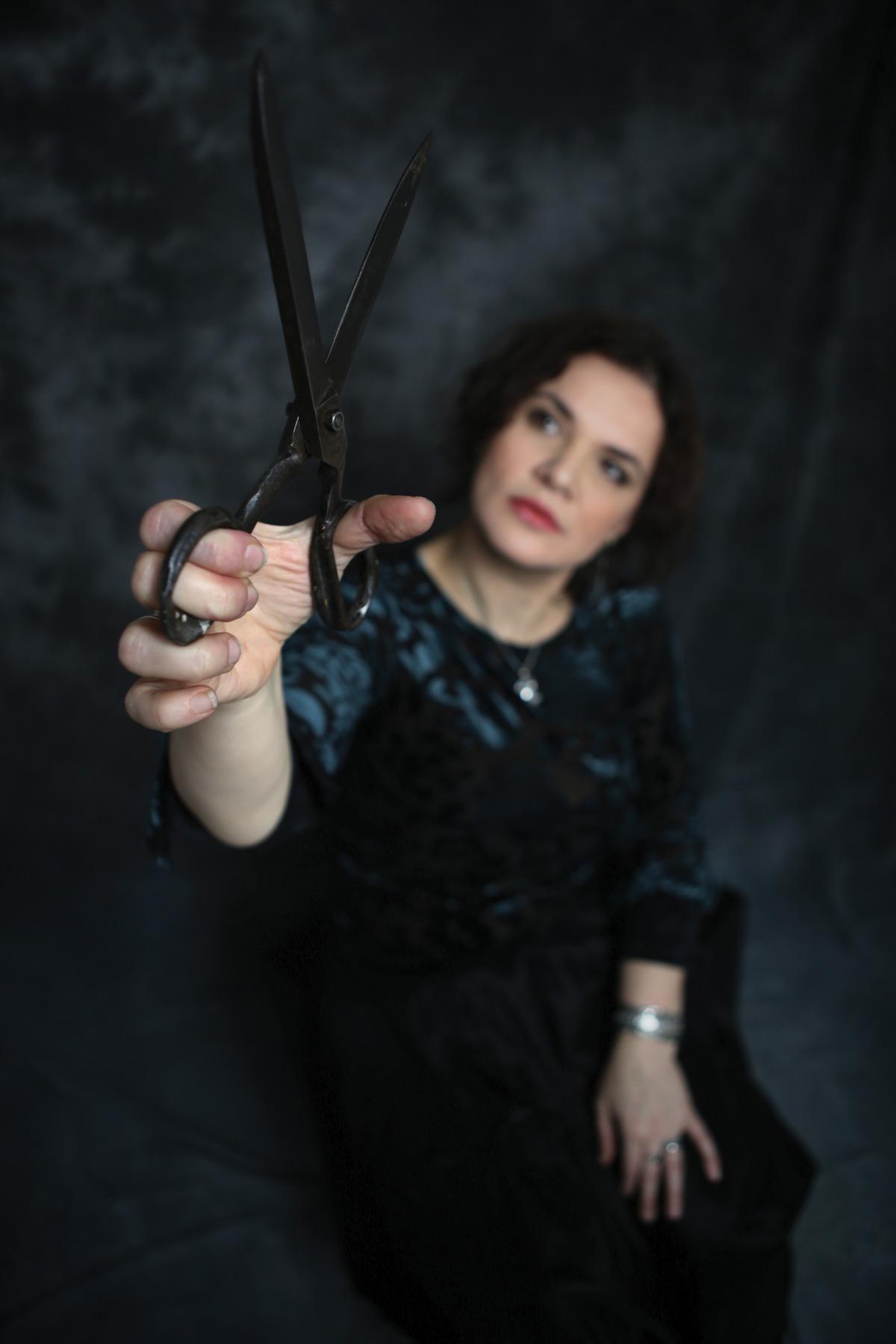
LandEscape meets
Ilinca Bernea
I started wishing to become a writer when I was about 12. Until then, I had wanted to become a space explorer and cosmonaut, like almost all children. When I discovered the power of narratives over the soul, it was clear enough for me that this was what I wanted to do. It was obvious to me that the act of writing was a way to materialize and to objectify fictions in order to covey them into a parallel reality… Literature comes to fill up the emptiness of quotidian life with whatever our inner lives push us to live.
scape Land CONTEMPORARY ART REVIEW
An interview by , curator and , curator




It's a way of resizing and reconfiguring it. Literature sets in motion our hidden potential and I am talking from both perspectives: the one of the writer and of the reader. During the years of accumulations and experiences with my writing, I had some moments of blockage and then, because I kept feeling the need to express myself in a creative way, I started taking photos and painting. Recently, I've started reciting my own lyrics on music and I've made some dance experiments guided by my childhood friend, Mihaela Zamfirescu, (we grew up on the same street) and who became, meanwhile, a great choreographer and ballet teacher. In philosophical terms, I am the adept of Croce and Collingwood's views. But to me, personally, art is a practice that helps me out in refining my way of living. I will never put art beyond existence, the art of living is the most important art.
You are a versatile artist and your approach reveals an incessant search of an organic symbiosis between a variety of viewpoints. The results convey together a coherent sense of unity, that rejects any conventional classification. Before starting to elaborate about your production, we would suggest to our readers to visit https://ilinkars.wordpress.com in order to get a synoptic view of your multifaceted artistic production: while walking our readers through your process, we would like to ask you if you have
ever happened to realize that such multidisciplinary approach is the only way to express and convey the idea you explore.
It is not mainly an I idea that I am aiming at, but the beauty of existence's spectacle.
Ever since I can remember, I’ve tried to find the secret of beauty, like that obsessive character of Suskind's novel, The Perfume, who wanted the elixir of eternal youth. I am talking about all kinds of beauty: the one of natural shapes and manifestations, the one of a mathematical demonstration, of a certain expression, or gesture, or of a body posture, because beauty is what gives identity to each shape, it converts the neutrality of perception. Beauty is what gives meaning to particularity and particularity to meanings. Everything that breaks through the anonymity of common places, everything surprising, everything strident, that could shake the senses and perceptions, bears the fingerprints of beauty.
I think we need the experience of beauty more than any other type of inner experience, in order to feel that we are living, plenary and deeply. It is a source of pleasure and even ecstasy in some cases. I’ve reflected a lot on these things. When your body misses a vital substance, you feel sick. The same thing happens with your mental-body: if it decodes the present wherein you're moving as being "ugly", you feel an emotional sickness. In my view, the
Ilinca Bernea scape Land CONTEMPORARY ART REVIEW
worst thing happening nowadays is the crisis of beauty resources. We are assaulted with toxic suggestions and with sensorial and mental information that keeps us away from our deeper self. The contemporary life-style is very dynamic on an exterior level and quite inertial on an inner level. We are pushed, through all means, out of our inner worlds, like through an emergency door, into a mutual world that belongs to nobody, really, we are chased out of ourselves with bulldozers. And, then, we wonder how come we've got this epidemic of depressions and neuroses and dogmatism and fanaticism? The penury of imagination uglifies individuals and reduces them, keeps them too close to the ground and makes them prone to sick criticism.
There are many possibilities to measure and prove your intelligence. In certain cases, you can discover you're smarter or stupider that you expected, but you need nobody to confirm it, intelligence is an individual and instrumental good. By the contrary, beauty is a relational value. On a deserted island, if you are alone, intelligence is a golden mine, but there is nothing you can do with your beauty. It exists only if it is acknowledged by another. It makes no sense to be beautiful if there is no one to realize it and to enjoy it, it is a contemplative good, an inter-human value, it is instinct as well as cultural fiction, avatar of desire and stimuli of fantasy, it is the perfect antidote against angst.
For this special edition of LandEscape we have selected Reeducation / The Intruder, a couple of extremely interesting videos (poems) that reflect the multifaceted nature of our relationship to nature and that our readers have already started to get to know in the introductory pages of this article: when walking our readers through the genesis of the Reeducation / The Intruder would you tell us something about your usual process and set up?
These two poems were conceived as a script for a contemporary theatre-dance performance exploring the confrontation of someone, caught in his middle age crisis, with the failure of his expectations and life plans. It is a metaphor-spectacle about the way in which pieces settle inside of us at different ages, about the awareness of losing and being lost, about the dramatic encounter of the adult with the youngster and with the child that he used to be, about the chimaeras, the strong and weak points of different life phases, about the acceptance and the refusal of reality, about the search of the perfect love. I always try to find the most adequate expression for the ideas and the emotional material I intend to transmit. The language takes the shape of the body of a certain narrative universe. The only two constant parameters of my style, which are true for everything I create, are humour and
Land CONTEMPORARY ART REVIEW
Ilinca Bernea scape
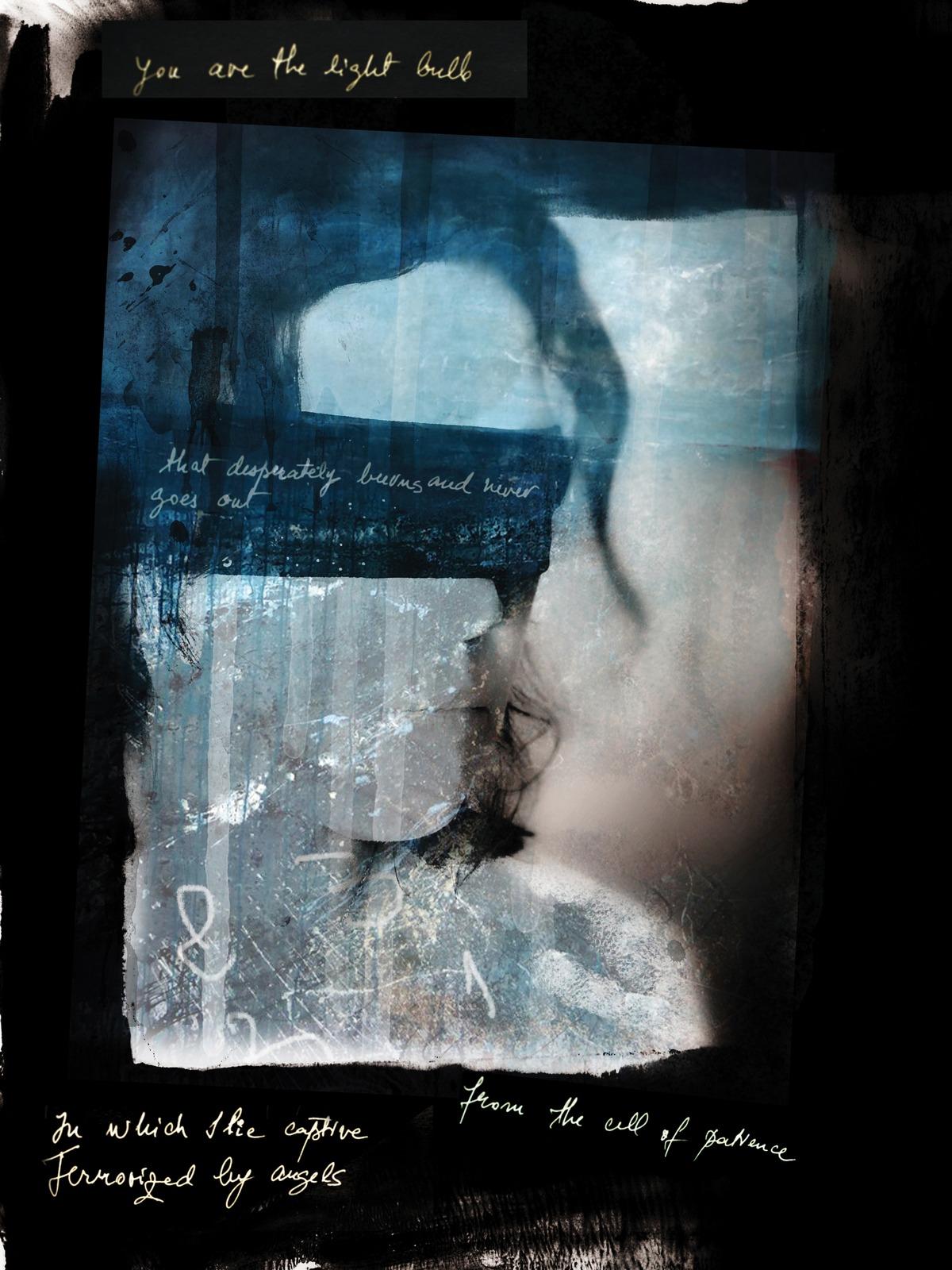

dramatic ambiance, this paradoxical blend is what defines me as an artist, I think.
The way you combine words with images allows you to accomplish the difficult task to balance rhyhtm and visual evokative reminders: this aspect of your practice seems to reflect your fascination for continuous transformation processes and draws the readers into a multilayered experience. Do you think that the harmonic fusion between different media could be the poet's goal? Or is the goal to make people look at the sphere of experience in a different way? Is it to touch their soul? Is it for them to feel delight?
It's hard to say. There are some already classicized arts, like cinematography, that make recourse to the image-text fusion. The traditional performing arts operate with image-text-movement melds, as well. Although there are, technically speaking, new media appearing all the time, this syncretism has been practiced, in various shapes, throughout the whole modern era.
Sometimes I feel that my texts would better captivate the audience if I associated them with a visual counterpoint, but there are situations wherein I am convinced that the image would diminish or restrain the horizon of the text... Why do books have such seductive powers? How come it is more difficult for us to forget a good book
than a good movie? This happens because literature actively involves the reader into an imaginative process. He (she) is supposed to create in his mind the film of the whole narrative, to visually and sonically configure the story. The temptation of an art that could cover, though its representation means, the areal of all senses, always existed. The question is: when the creator guides you through a so welldefined sonic/figurative universe, are you able to transpose yourself in his fiction with same intensity as if it were yours? The ambiguity of the literary universe absorbs the reader's projections. You complete, as a reader, with your own fiction, the dotted lines, the shady zones of the script, and you are the one who chooses the exact image of every single thing evoked, you have the freedom to sketch all the portraits, to decide the casting of all protagonists.
When I choose to associate a poem with images, to turn it into a video or into a theatre performance, I am aware that I resize and reshape it, that I am adding a new lecture-key to its original meaning. Meanwhile, my main concern is to keep the horizon of the text wide open. Therefore my choice is for semifigurative artistic expressions: they have a higher degree of ambiguity, they are more mysterious, therefore more appealing.
We have particularly appreciated the way your love for lyricism of the metamorphosis leades you to
scape Land CONTEMPORARY ART REVIEW
Ilinca Bernea
combine symbolic elements with a figurative approach, to create an effective channel of communication between the conscious sphere and the subconscious level. This creates a compelling non linear narrative that, playing with the evocative power of reminders to universal imagery, establishes direct relations with the viewers. German multidisciplinary artist Thomas Demand once stated that "nowadays art can no longer rely so much on symbolic strategies and has to probe psychological, narrative elements within the medium instead". What is your opinion about it? And in particular how do you conceive the narrative for your works?
What I am trying to do is capture the infrareality, whatever is hidden under the curtain of cultural constructs and interpretations. I would avoid any term from those shaped and employed by psychoanalysts, although I am definitely the adept of C.G. Jung and G. Bachelard. I prefer not to do it because the "unconscious" became the hobbyhorse of the actual academism and of doubtful theoretical speculations. What I can say is that one cannot make art inspired by theory, on the contrary, in order to make art one has to get rid of any theoretical influence from his (her) own feeling and understanding. If there was ever a time when I wrote and painted really badly, it was when I fattened up on studies. I needed 10 years of rehab. You turn into an artist only from the moment when you get undressed of any cultural vesture that

scape Land CONTEMPORARY ART REVIEW
Ilinca Bernea

Ilinca Bernea scape Land CONTEMPORARY ART REVIEW

Ilinca Bernea scape Land CONTEMPORARY ART REVIEW
blurs or distorts your natural voice. I want to believe that I have come to the point when my creations have nothing demonstrative anymore, when I really found my "inborn" style, a way of speaking in my own particular language. You cannot get here if you don't know yourself...You need to destroy your supra-ego to be a true artist and a true human being as well, that's for sure. For each one of us, the most difficult thing is to cross the border set between a fake self image that has been culturally and socially shaped and the lands of our inner truth. My alchemical black-gold is the instinct. It's so hard to get in touch with it, to accede it, to let it guide you, to silence the voice of reasoning that is prone to contest any form of spontaneous knowledge! Reasoning is skeptical, by excellence.
Spontaneous knowledge is, in fact, the result of thousands of years of ancestral experiences, it functions as a deep intuition that tells you who and what you're dealing with. I'll try to say it as simply as possible: we know what to eat instinctively, because our senses find some aliments repulsive and others irresistibly tasteful. Pleasure and disgust are sensors that warn us about what could be good for us and what cannot...What we perceive as having bad taste, could also be dangerous for our health. The same thing is true on an inter-human level. The attraction that we feel towards someone is a sample of instinctive “knowledge” that tells us, clearly, that we are dealing with someone that we are in harmony with. I think that

CONTEMPORARY ART REVIEW
Ilinca Bernea scape Land
pleasure is the media through which we are taught everything we need to know about ourselves in a primordial sense. Our thoughts, feelings, experiences, acts are not pointing out who we are as clearly as our desires. The aesthetic resonance between the art-consumer and the art-maker happens in the same way and has the same properties. This resonance has mirroring properties. There are art shapes capable of reflecting our own image like mirrors or to acquaint us with a face that we didn’t know we had.
Instinct is the compass of the primitive brain, also called reptilian in biology. If this archaic brain, that tells us who we are and what we need and have to know about life through senses and desires and not through words and judgements, would be completely subordinated by the other (the recent and rational one) the whole beauty and poetry of existence would collapse, the whole art would vanish, because art is born from the tension existing between the new brain that operates with logic formulas and abstract ideas and the old brain, that acts through instincts and feelings.
There are two big categories of artists: the inventors and the explorers. I am among those who discover... You can discover, through artistic practices, many things about life and about humankind, about yourself. Although art creation is, essentially, a matter of
form, it is not important for me to seek the metaphor or to try to avoid it, to run away from common places or to run after the unconventional, but to put myself in contact with my inner forms, when feeling inspired, to follow the path of inspiration and not the one of the aesthetic values that I consciously subscribe to.
The effective dialogue established by tones and texture is a crucial part of your style: in particular, the effective combination between intense nuances of colors sums up the mixture of thoughts and emotions. How much does your own psychological make-up determine the nuances of tones you decide to use in a piece and in particular, how do you develop a painting’s texture? Moreover, any comments on your choice of "palette" and how it has changed over time?
I paint only when I am unable to write. I have no academic or scholar training in painting. It's a genuine matter, I don't take myself seriously. When I have the brush in my hand, it's like sinking into a zen meditation. Everything happens without any effort, the canvas covers itself, badly or not so badly... I am not too skilled in drawing, in fact I am really lousy. But I've been told I have a good sense of color. As a writer, I have many literary strategies, but in painting I let my senses totally free to hit the pace...
scape Land CONTEMPORARY ART REVIEW
Ilinca Bernea

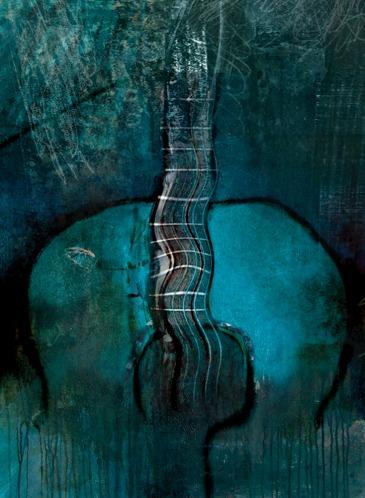
Overall, my visual works are much connected to urban fictions in a quite eclectic way.
As you have remarked in your artist's statement, you conceive humor as being situated at the contact surface with the sublime: while artists from the contemporary scene, as Ai WeiWei or more recently Jennifer Linton, use to express open socio-political criticism in their works, you seem more interested to hint the direction, inviting the viewers to a process of selfreflection that may lead to subvert a variety of cultural categories. In particular, you once remarked that art's role is to put ourselves in contact with our deeper self and senses. Do you consider that your works could be considered political in a certain sense or did you seek to maintain a more neutral approach? And in particular, what could be in your opinion the role that an artist could play in the contemporary society?
In a certain sense, yes, every art work has political echoes and implications, we are social-political beings, we live in a network, in a context. Surely, my creations are no exception, they have been conceived as meditations on situations of social crisis or of tensions between values within a community, but I never intended them to have an ideological stake. I try to avoid the
militant attitudes and the enrolment on the side of a doctrine by all means. I am very reluctant towards those pieces of so called engaged art, which are but ideological products and propaganda. I acquired this aversion when I was a child. I grew up in a country from the communist Eastern Bloc, I think it's understandable.
Your imagery shows a connection to urban fictions: however, we daresay that your approach goes beyond a merely interpretative aspect of the contexts you refer to. As the late Franz West did in his installations, your works show unconventional aesthetics in the way they deconstructs perceptual images in order to assemble them in a collective imagery, urging the viewers to a process of self-reflection. Would you shed a light about the role of metaphors in your process?
My attitude towards metaphor evolved in time. It could be the scaffolding of a whole novel or performance or painting. I will give you an example. One of my most recent poems that employs metaphors on one side, but is very straight and realistic on the other side. The mixture between a fantastic succession of images, with oneiric accents, and a raw, even aggressive disclosure of a tough reality, is something typical for my lyricism.
Ilinca Bernea scape Land CONTEMPORARY ART REVIEW
The deal
I’ll pay, that’s what I decided I’ll pay for your childhood with tattered sandals for your sleepless nights for the back you broke hardworking for every slap your mom got from your dad for every blow life dealt you for all the mud in the filthy town wherein you spent your youth for all the kilometers of sea that you crossed swimming to forget for every swallow of loneliness
if there is no other way and someone has to pay then hit me hurt me for every humiliation you endured unleash your rage, for the school allowance you never received make me feel with each of your cruelties how badly your mother suffered how horribly you felt not being able to protect her give me your fear of earthquakes make me witness the moment you learned to threaten and spit
hit me
for your damned country
I want to know what the life of a dog is like I want to feel your blind rage boiling your strained nerves triggering solar explosions building the walls of dungeons in which so many innocent men struggle with the burden of an unlived life I want to feel in your flesh everything that you keep under silence spill all your torment over me
someone has to pay
if that’s how you can set yourself free if you will be able to breathe with relief give me your delicate skin that had to endure everything hit me until it's nothing left of me until my chest will echo but the road of the wind slamming against the wall the door of an abandoned house and the sound of the waves washing the shore of your childhood of all impossible desires I pay
Ilinca Bernea scape Land CONTEMPORARY ART REVIEW


I am mesmerized, aesthetically, by a certain expressionist tension, I like strong contrasts. I use to juxtapose the universe of desires with the one of the facts and situations that crush them, or the duality inner/other reality, or to put in the spotlight the tension between what we are and what we are claimed and required to be, the fight among the dreamer and the cynical man from inside us.
Your successful attempt to show the relativism of the oppositions that are mainly culturally and linguistically shaped allows you to capture nonsharpness with an universal kind of language, capable of bringing to a new level of significance the elusive still ubiquitous relationship between experience and memory. So we would take this occasion to ask you if in your opinion personal experience is an absolutely indispensable part of a creative process... Do you think that a creative process could be disconnected from direct experience?
No. It is never possible. That's why I reject the term self-fiction. Any fiction is a selffiction. One cannot escape his own experince, cannot dissociate himself from it, or transgress it without becoming pedant, inconsistent, untruthful or superficial.
One of the hallmarks of your work is the capability to create a direct involvement with the viewers, who are urged to evolve from a condition of mere spectatorship. So before leaving this conversation we would like to pose a question about the nature of the relationship of your art with your audience. Do you consider the issue of audience reception as being a crucial component of your decision-making
process, in terms of what type of language is used in a particular context?
Yes and no. I would rather say that when I conceive my creations I split myself in two, trying to satisfy, as an artist, the taste and the expectations of the art/literature consumer that I am. I am trying to write or to paint those things or to make those performances that would capture my interest as a spectator. I don't always succeed, of course.
Thanks a lot for your time and for sharing your thoughts, Ilinca. Finally, would you like to tell us readers something about your future projects? How do you see your work evolving?
I thank you too for the questions.
I'd like to talk a bit about the most imporant thing I've done so far, my most recent novel that touches, I think, a nerve of the actual world and times. A Western woman discovers, with astonishment, the Middle East's hidden treasures and a woman from the Middle East is mesmerized by the Western World. The action happens in London.
They both are very critical towards their original environment and prone to idealize the experiences that they never had. By the end of the book, they will both get to face a type of disappointment. It is a novel about the contemporary Babylonia and about the roots of Islamophobia, about the fractures in the Muslim world, about the fight for freedom borne by the people in the Middle East, about the political crisis in Turkey and the freedom wastage of those who have it, about the fabulous erotic practices and views of men coming from the Middle East.
Ilinca Bernea scape Land CONTEMPORARY ART REVIEW
The main character, a woman with a high education and raised in feminist spirit, falls madly in love with a Muslim guy, with no studies, but shockingly beautiful, who makes her aware of unknown and darker sides of her own sexuality.
It is a postmodern version of The Beauty and The Beast, written in a rough manner, with humour, but with no euphemisms, about the current Babylon, a story about passion and melancholy and about the stigmatization of pleasure, about the absurdity of the notion of
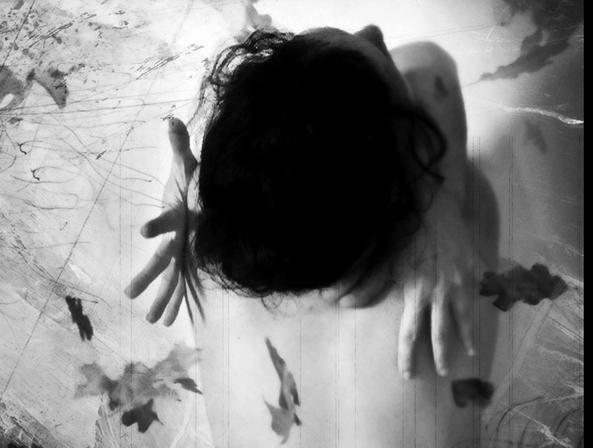
scape CONTEMPORARY ART REVIEW Land
Ilinca Bernea
enemy. Also, a book about solidarity among women.
What I plan to do next is another poetrydance performance with some very talented actors, dancers and musicians. We'll have live music for sure. And I also work with some British artists to a photography/ poetry/
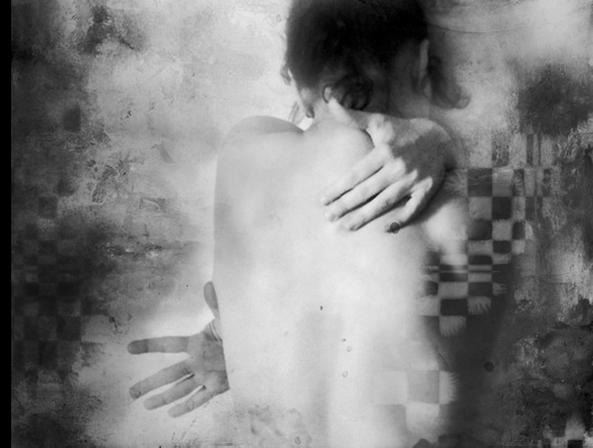
video project that will be exhibited in a new opened gallery from North London.
An interview by , curator and , curator
Ilinca Bernea scape Land CONTEMPORARY ART REVIEW
Snow Yunxue Fu
Lives and works in Chicago, USA
Snow Yunxue Fu’s artwork approaches the subject of the
Sublime using topographical computer rendered animation installations. She examines and interprets the world around her through digital reality, where she draws a parallel to the realms of the physical, the virtual, the metaphysical, and multi-dimensionality.
Modeling her animations on the allegorical paintings of Casper David Fredrich, Fu continues her aspirations in the sublime from her painting background into experimental digital media,
exploring the nature of physical and metaphysical limits, as the work also mirrors the fundamental aspect of Chinese Traditional Landscape Painting, which often presents a type of virtual reality where the significance of the individual and linear perspective is blurred into a voluminous landscape. Extending out from the pictorial, Fu’s installation work engages in a metaphoric relationship with physical perception, by which the sublime is framed and the viewer is invited to enter into a liminal interior within a digitally constructed realm.
An artist's statement
scape Land CONTEMPORARY ART REVIEW

LandEscape meets
Snow Yunxue Fu
, curator
Marked out with a stimulating multidisciplinary feature, artist Snow Yunxue Fu's work examines the possibilities inherent in contemporary media and technology to question aspects concerning human perception in relationship of contemporary technosphere. In her recent body of works that we'll be discussing in the following pages she draws the viewers through a multilayered experience capable of challenging their perceptual parameters, conveying a variety of ideas: when inquiry into a variety of issues, including cultural and anthropological problems, Fu's approach triggers both memory and imagination, creating captivating artworks: we are very pleased to introduce our readers to her multifaceted and stimulating artistic production.
Hello Snow and welcome to LandEscape: before starting to elaborate about your artistic production would you like to tell us something about your background? You have a solid formal training and you studied both in China and in the United States: after having earned your B.F.A.in Painting from the Southeast Missouri State University, you moved to Chengdu, China, to attend the Sichuan Normal University. You later nurtured your education with a B.F.A. in Studio Art and a M.F.A. in Film, Video, New Media, and Animation, that you received from the prestigious School of the Art Institute of Chicago. How do these experiences influence your evolution as an artist? And in particular, how does the relationship between your substratum dued to
your Chinese roots and your current life in the United States inform the way you relate yourself to the aesthetic problem and to art making general?
I grew up with two art educators as parents and a grandfather who was a well-known Chinese traditional painter and sculptor. I was painting as long as I can remember. I worked with Chinese ink painting, acrylic and oil pastel throughout my childhood, painting anything from abstraction to figurative. As a child, that was very much part of my life. Art is how I reflected what I saw during the day and processed things I experienced.
However, there was a break from art in my teenage years, mostly because of the heavy load of Chinese academic work from school. Plus, I had a bit of a rebellious period where, due to family pressure to continue the trade and become an art star, I resented the idea and focused on English. This actually paid off, since I came full circle in the States. It was not until I came to America for college that I started to paint again (on my own terms) and finally majored in oil painting. In my many undergraduate years, I was mainly a painter, but also had a multidisciplinary background in sculpture and photography before making the leap into Experimental 3-D and installation.
I came to America for my higher education. I think I approach Asian identity maybe in a more different way then an Asian artist who may be born or grow up in the west. I know there are artist who are more actively working with how to identify themselves as Asians or just Asian identity in general in their work. But what I’m more
scape Land CONTEMPORARY ART REVIEW
An interview by , curator and

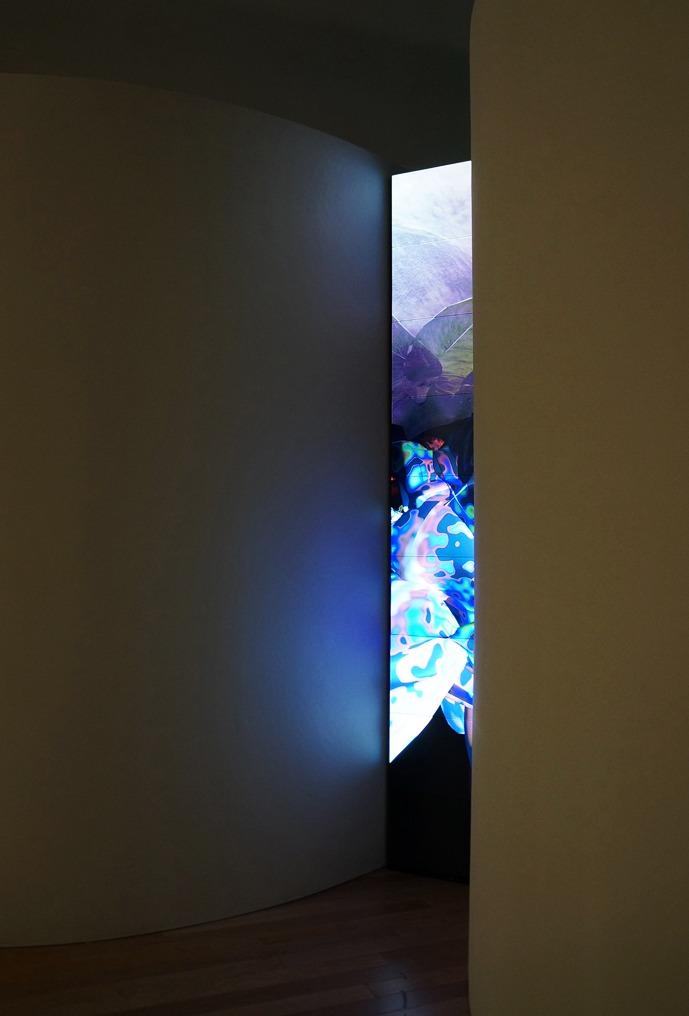

interested in is more of the humanity in all races and cultures. There are definitely things and morals I hold on to growing up in China. I’m sort of less interested about the conversation of how everyone is different because of their cultural heritage. While I think it’s still very important to allow the difference but it can also become something very arbitrary and sort of trying to take a broader view, I feel like civilizations belongs to every single one of us. Especially while the world is becoming a smaller place, so to speak, with the internet and how easily people can travel nowadays. I think that this heritage is not necessarily like, “oh, I have the blood of China, therefore I only hold on to the teachings and values from Chinese culture.” Therefore, I don’t think I address Asian identity in sort of a direct way like that. There are definitely certain aspects of my work considered Chinese. A lot of times it’s really interesting, people will look at my work and later come up to me and point it out and I’ll also often turn to agree with them. For example, a work I had made was called “Pro,” which is this long gap like animation which is installed in-between two curved walls and somebody came to me after I installed it and they said: “Wow, this is like a digital Chinese landscape painting.” In a way I did connect with that because my grandfather was a very dedicated landscape painter all his life in China. Did I seek out and deliberately said “I’m going to create a Maya digital Chinese landscape animation?” No, I didn’t. However, I think I definitely draw from what my past experiences with Chinese landscape paintings. So yeah, I think my relationship with that is that I’m less interested about the boundaries and I’m less interested when someone only identifies themselves as an Asian artist. But I’m more interested about being an artist and at the end of the day what is the human experience we’re trying to reflect upon but also not throwing out that I do specifically come from somewhere and therefore acknowledge my understanding would be shaped by that. But does it stop there? I do not think so. You are a versatile artist and your work is marked out with a distinctive multidisciplinary feature:
ranging from Installations and 3D Animations to Prints and other, the kaledoiscopic nature of your practice shows an organic synergy between a variety of expressive capabilities. Before starting to elaborate about your production, we would suggest to our readers to visit http://snowyunxuefu.com in order to get a synoptic view of your multifaceted artistic production: while walking our readers through your process, we would like to ask you if you have you ever happened to realize that such multidisciplinary approach is the only way to express and convey the idea you explore.
On a whim, I took this intro to Experimental 3-D course at the School of the Art Institute of Chicago. It was very different from my normal practice, but I found myself relating to it. What I

Land CONTEMPORARY ART REVIEW
Snow Yunxue Fu scape
had been hoping to express and explore in painting seemed to suddenly be freed and made possible through the limitlessness of virtual reality. It was like a light coming on or a door opening, and I never looked back. However, I brought with me a painter’s sensibility and process. I quickly replaced my canvas and paintbrushes with software like Maya and Realflow, and moved more and more into intentional abstraction.
The main conversations in the painting world were not so connected to what I was trying to explore conceptually. Painting seemed burdened by always carrying around centuries of conversation and baggage. One would almost have to choose to fully carry that baggage or find a way to creatively dismiss it all to explore
what one wished. Yet, when I came to 3-D experimental animation, it was like a sudden discovery of a better language.
It was definitely a younger medium and virtual reality had yet to be explored in the art world. The conversation was more energetic. I think the painter in me will never die, but, as in my real life, one language may work better than another to express myself. With each language you learn, new perspectives are available to you to explore. Some languages seem naturally related to one another, and the language of installation was a natural progression from 3-D work, as it is often projected into architectural space.

scape Land CONTEMPORARY ART REVIEW
Snow Yunxue Fu
3-D medium itself is interdisciplinary by nature, besides painting, it also has characteristics of working with sculpture, photography, virtual filmmaking and installation. It in a way functions as a metaphor and model of those physical mediums. I think it is the logical conclusion of where the most exciting contemporary art should be.
For this special edition of LandEscape we have selected Tunnel, an interesting body of works
that our readers have already started to admire in the introductory pages of this article. We like the this work chellenges the viewers' perceptual parameters to draw them through a multilayered experience. While walking our readers through the genesis of Tunnel, would you shed light to your usual set up and process?
Tunnel was originally inspired from an experience I had this past summer where we
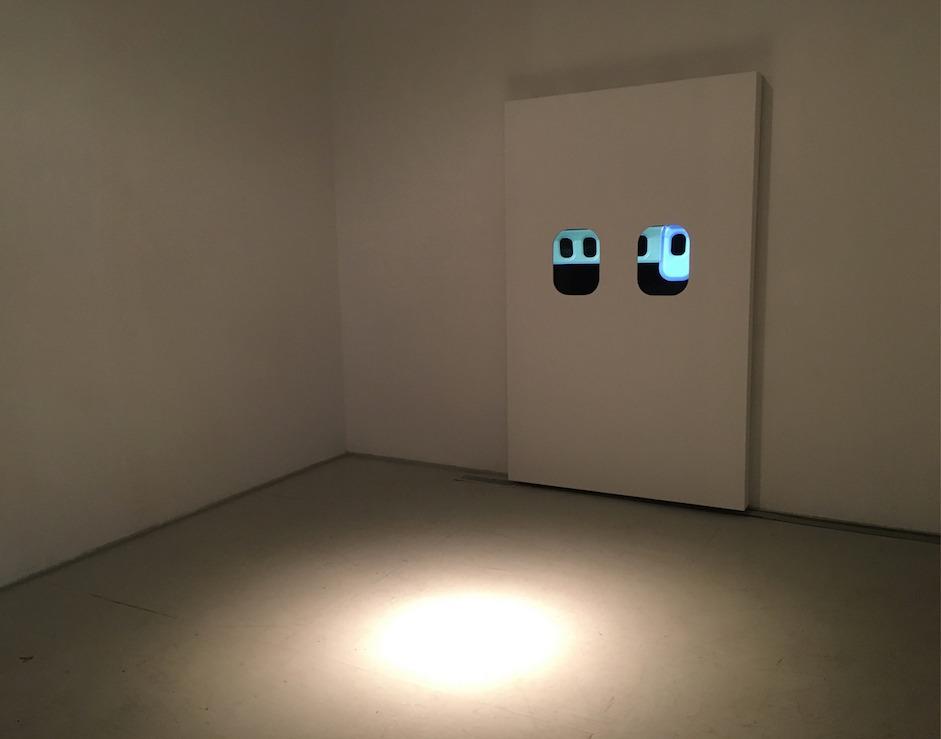
Land CONTEMPORARY ART REVIEW
Snow Yunxue Fu scape
were traveling to Arizona, which the place was not really that important, but working on that experience as a metaphor going through a tunnel was the inspiration--long story short; Arizona is beautiful with all the different formations of rocks so we were really excited as tourists. The tour guide was like “you will get to see this new kind of rock form after we go through this tunnel, and they are unlike anything you have seen before!” so everyone
was excited so when we went through the tunnel which was made in the early 20th century so it was small. Even though we were traveling with a bus, only one car can fit in the tunnel at one time. So for the majority of the time we were “in the dark,” as the tour guide put it. He also mentioned that there are five windows increasing in size so each one will reveal a little bit more about the other side of landscape. I had a feeling that this experience would be unique and I was very excited as we progressed even though for majority of the time we were in the dark, every once in a while there was a little opening outside of the bus and it got bigger and bigger so you did get to see the other side of the landscape more as it goes on. I was also counting them 1 2 3 4… before I was able to count five already we were outside the tunnel and the tour guide welcomed us to the fifth window. I took that experience very metaphorically. Thinking about this revealed an unrevealed expectation and a parallelization to a sort of the spiritual realm versus the physical and metaphysical realm, which has been a common theme throughout all my work, so the piece Tunnel is very much inspired by that experience and of course the making of the work also made it become something else.
So working with experimental 3-D is interesting because in a way you’re very exposed to this blank XYZ space. You might also had some experience with 3-D software or maybe even in Photoshop so when you work with the software, things come from nothing to something. Especially working with software dealing with virtual reality. You start with an empty XYZ space and then you sort of create stuff within that space. Things like gravity, if you do not put it in this space it won’t be there. My approach is very much building the world within Maya. Sometimes it’s very much with abstract shapes and there is a lot of esoteric elements. Living in this world is a more figurative structure and it’s very much swimming in and out so it’s about building this world or building this virtual sculpture first and then relating to experimental filmmaking so I animate them. From there it’s working with the

scape Land CONTEMPORARY ART REVIEW
Snow Yunxue Fu
virtual camera like one may work with a real camera in the world and revealing this world that I just made with different camera movements.
What has at once captured our attention of your exploration of the liminal space among the physical and virtual realms is the way you invited the viewers to rethink the elusive notion of perception: artists are always interested in probing to see what is beneath the surface: maybe one of the roles of an artist could be to reveal unexpected sides of Nature, especially of our inner Nature... what's your view about this?
The physically installation outlet is a really important component of my work. So usually it’s in the installation form. I also want to bring in the image of the physical space where there is a relationship of scale in distance and relationship of light and dark with the viewer and the experience. Most of the installations are very aware of the viewers’ body like it’s usually in relation to the average person’s height.
There’s a lot of gaps, so to speak, in my installation where I deny access of my viewer to fully consume the image and those gaps are very much related to the thickness and width of our bodies so that somebody can understand the fact there’s more image behind the structure but they are not necessarily able to access while I am still inviting them to imagine the more and beyond. So I would say that is my process, with which each of them are very different and address specific issues but by taking inspiration from various experiences, so it’s very much about the specific content in the animation and I am also working with each environments in every the exhibition space and talking to my audience in a special way.
Sound plays a crucial role and provide Tunnel with an aethereal, almost uncanny quality, that has reminded us of the notion of non lieu elaborate by French anthropologist Marc Augé: how did you structure the composition between moving images and sound? In particular, did you capture

environmental sounds to process them via DSP methods?
As a former painter, sound was not an immediate concern going into 3-D. Now it is quite obvious. Sound continues to be an area of exploration for me. My process is quite intuitive, so there are times sound seems to be a natural extension of the work and other times not. Like with mainstream viewers’ perception of 3-D animation, media natives that have experienced
scape Land CONTEMPORARY ART REVIEW
Snow Yunxue Fu
digital media and sound from near birth, tend to expect sound when they see a moving image. Whether sound is or is not used, its presence or absence can help viewers arrive at a particular awareness of themselves in relation to the work.

When I do use sound, I usually start with recording environmental sound or I use recordings from various sources and then edit them on software like Logic. I find there is a
draw for my work to combine sounds at opposite ends of the spectrum – sound based in the environment and sound that is fully synthetic. And that relates somehow to the experience I want my viewers to have, either fully immersed in the visual and audible elements of my work, or stopping to explore why there is not sound and how it relates.
We live in an technologic era that’s saturated with an ever-growing wide multitude of
scape Land CONTEMPORARY ART REVIEW
Snow Yunxue Fu
methods, and with all the variations and modifications that come with them. As the move of art from traditional spaces to the online realm increases, what do you think the future of technology and art will be?

The majority of digital technology has practical places in our daily routines. How can I do this
efficiently? How can I get this information the fastest? How can I connect with this group of people? These questions are often answered by “looking down”, focused on a specific place in time, a screen, an app, a watch. It very much reflects a western capitalist consumerism, though, in my work, I am more fascinated with the idea of
scape Land CONTEMPORARY ART REVIEW
Snow Yunxue Fu
conjuring an experience of the infinite in nature –like what happened when you saw the ocean for the first time or climbing to the top of a peak. These experiences reflect the questions we face when our finite selves meet the infinite. The digital virtual world parallels this stage. Everything in the virtual world is made up of

singular finite 0’s and 1’s, yet they grant the virtual world infiniteness, as in Maya where the X, Y, and Z axes extend forever. The digital realm, therefore, is an excellent platform to hold conversations about the significance of our personal/interpersonal and existential/everyday selves.
There is definitely criticism I hear especially with the technological part of my work. I honestly think some are good concerns but some are probably just misunderstandings. One thing that jumps out in my mind, many people who come to look at the work, or digital work in general, are questioning the artist’s hand in it, thus the artist’s involvement and therefore the artist’s intention. This is something that is not usually questioned of an artist who paints? This myth about mark marking that traditionally is very related to paintbrushes and empty canvas, and the idea by smearing some paint on the canvas, it somehow makes people feel it’s a stronger human connection verses someone who is sitting behind a computer sculpting, animating, and lighting things. I mean, I definitely understand how it could look a little more distant from the artist hand but I think it’s only because it’s a lack of understanding of how much an artist could be physically, emotionally, and mentally involved in creating a digital artwork. I don’t think it’s… of course technology is more considered as an extended tool, you know. Talking about tool making, paintbrushes and canvases once was a really new tool too. We have developed more as humans over time so of course were using the more advanced tool but I think the motive and intention behind the tools doesn’t necessarily mean the tool would lessen the intent. Of course there is a possibility behind that. It has to do with each artist and how they approach their work and how much meaning and conceptual ideas they put in their work reflect back upon how much are they involved into the work. So that is definitely one of the more general criticisms I often respond to.
scape Land CONTEMPORARY ART REVIEW
Snow Yunxue Fu
I think there still is a lot of controversy surrounding the digital art form even looking at the history of moving images, or even before that, photography. There were people for the longest time who were very suspicious that photography could never become an art form besides being a medium of capture and then Walter Benjamin came out and wrote an article about mass production and reflecting that into photography and film making. The medium could become more than a capture tool of reality, but in a way quite different, it very much became about image making that relates to the projection of desire. Nowadays, there is so many programs like Photoshop that there is in so many ways functions even more like that, to manipulate images, which some are for better and some are for worse. From my end those are all tools and the grander debate--you can’t really call a tool evil or good, the output of that tools is directly related to the person who is using it--how are they using it? How you can draw a better judgment? There are definitely many different sides to work with technology.
When inquiring to the state of the human consciousness, Solid rejects an explicit explanatory strategy: rather, you seem to invite the viewer to find personal interpretations. How does representation and a tendency towards abstraction find their balance in your work?
I believe that exploring abstraction is a crucial foundation to examine and understand the process of human perception. As limited being attempts to comprehend the much vaster reality, it inevitably creates many paradoxes. The very creation of language, for instance, while serving the purpose for communication, the individual words often for-short of the much more profound meaning of the subject in which the vocabulary is trying to frame.
Abstraction invites the emphasis on personal interpretation, therefore I believe the experience

is more real without too much pre-conceived notion from the artist. I think it is the best way of demonstration the following quote:
"...digital space has no generic method for looking at the world the way that a camera does through its pinhole/lens apparatus. Digital space is constructed space, in which each component,
scape CONTEMPORARY ART REVIEW Land
Snow Yunxue Fu
aspect, concept, and surface must be defined mathematically. At the same time, the world inside a computer is but a model of reality as if seen through the eye of a synthetic camera, inseparable from the tradition of film. Yet, in this context, no viewpoint is ever discarded, the internal space is open to a continuous
rearrangement and access to a selection of views and narrative vectors in infinite, not only to the author, but also, with the use of certain strategies, to the viewer. Once the author constructs and organize a digital space, the viewer can enter into a narrative relationship with it. A shot in film indicates a discrete
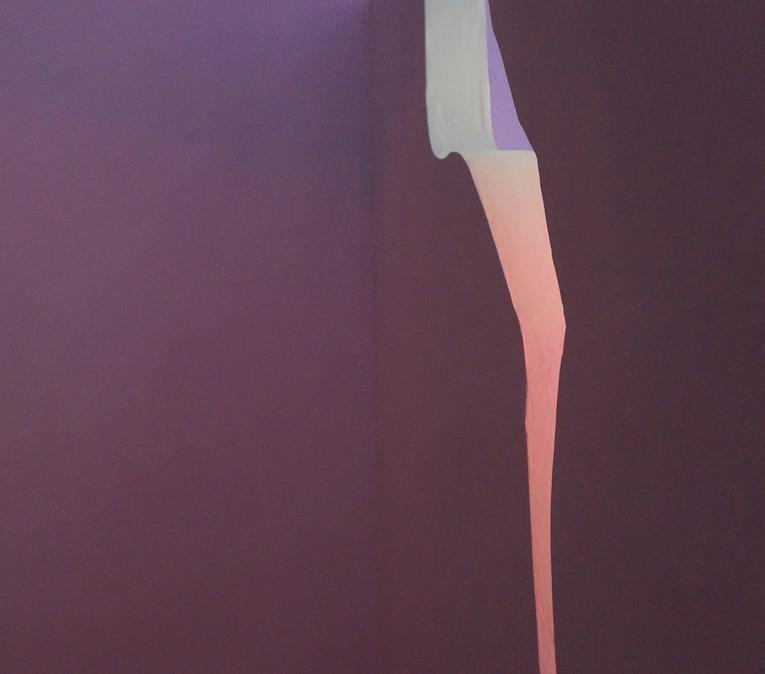
Snow Yunxue Fu scape Land CONTEMPORARY ART REVIEW
viewpoint. Its narrative purpose is to eliminate other possible views. In contrast, the world in the computer contains the infinity of undivided space, undissected by the viewpoints of narrative progression. In the world of the machine, all sets of narrative vectors are offered in an equal nohierarchical way. The machine is indifferent to the psychological conditioning of a viewpoint. All coordinates of space are always present and available to the principles of selected observation."
--Notes on Installation, by Woody Vasulka
Your installation Pro² could be considered as an exploration of the insterstitial point between the figurative feature of daily life objects' physical perception and gestures and the abstract nature of digitally constructed space: we have appreciated the way this work unveils the flow of information through an effective non linear narrative, establishing direct relations with the viewers: German multidisciplinary artist Thomas Demand once stated that "nowadays art can no longer rely so much on symbolic strategies and has to probe psychological, narrative elements within the medium instead". What is your opinion about it? And in particular how do you conceive the inner narrative for your works?
My artwork approaches the subject of the Sublime using topographical computer rendered animation installations. She examines and interprets the world around her through digital reality, where she draws a parallel to the realms of the physical, the virtual, the metaphysical, and multi-dimensionality.
Modeling her animations on the allegorical paintings of Casper David Fredrich, Fu continues her aspirations in the sublime from her painting background into experimental digital media, exploring the nature of physical and metaphysical limits, as the work also mirrors the fundamental aspect of Chinese Traditional Landscape Painting, which often presents a type of virtual reality where the significance of the individual and linear perspective is blurred into a voluminous
landscape. Extending out from the pictorial, Fu’s installation work engages in a metaphoric relationship with physical perception, by which the sublime is framed and the viewer is invited to enter into a liminal interior within a digitally constructed realm.
Pro² provides the viewers with an immersive experience capable of challenging their perceptual parameters. How do you see the relationship between public sphere and the role of art in public space? In particular, how much do you consider the immersive nature of the viewing experience?
Maybe because I have originally come from background of other mediums that deal with objects and space such as sculpture, after an intense involvement with the digital space through 3D animation, I was eager to bring the images that I have created there at least partially back into the physical reality. Pro² came out from that. As I believe the human perceptual experience is not only with our visual and hearing senses, but also a bodily one. So the viewing of the work in space and especially public space become an important one for me.
In the contemporary era, our experience of the physical space is also profoundly informed by the experience we have with the digital space. I love the following quote dealing specifically with video installation and I hope my installation work reflects many aspects here:
"...Not only do we live surrounded by images, our built environment and even our natural world has largely passed through image-culture before rematerializing in three-dimensional space...The materialization of other possible apparatuses allows us to imagine alternatives and thus provides the Archimedean points from which to criticize what we have come to take for granted.
"A subject in this everyday world is surrounded by images and a built environment that are, at times, hard to tell apart. Three-dimensional objects are no longer a prior reality to be represented, but rather seem to be blowups of a two-dimensional
Snow Yunxue Fu scape Land CONTEMPORARY ART REVIEW
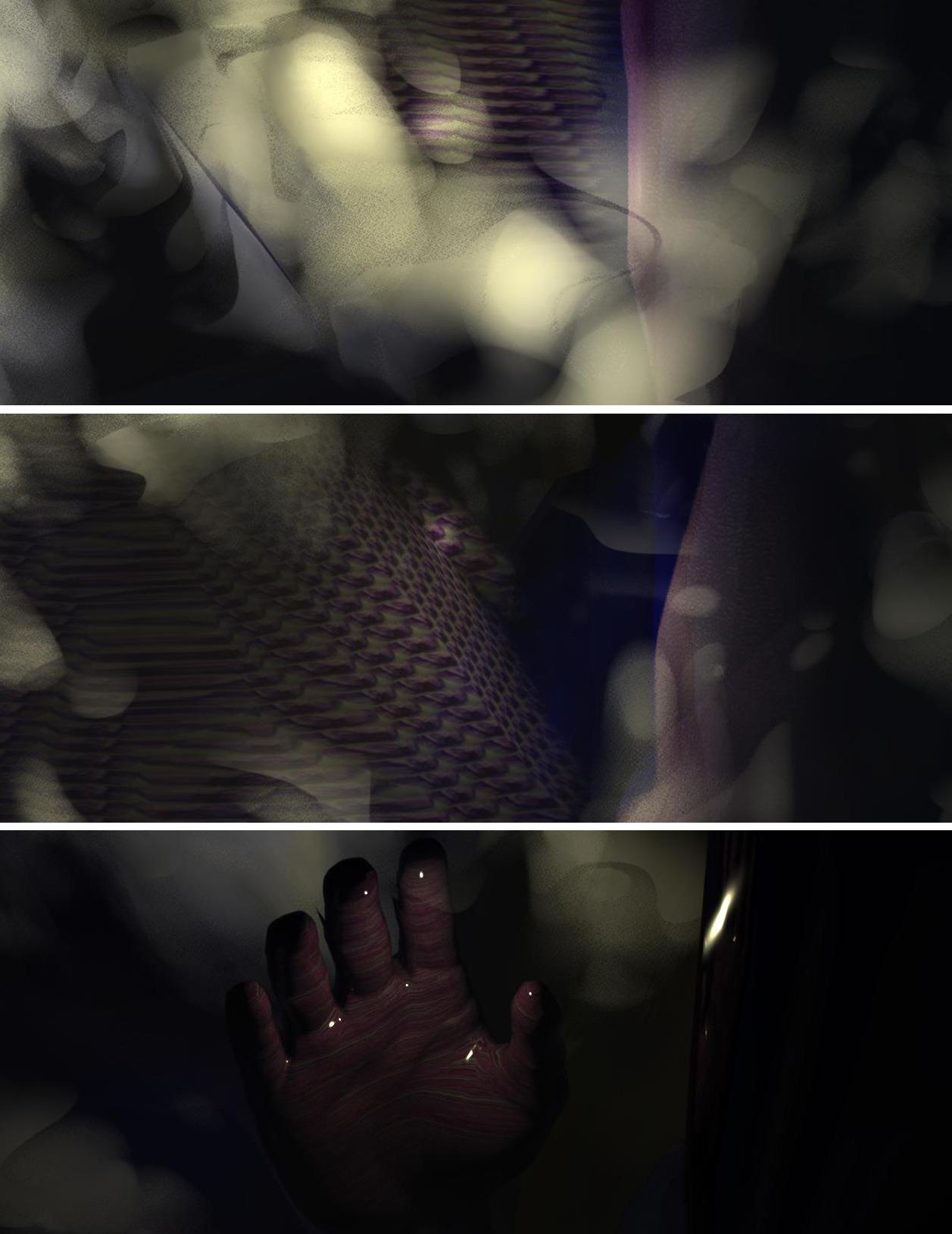

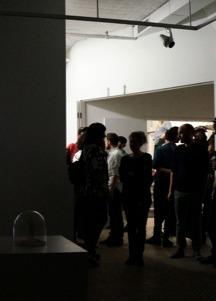
world. Two and three dimensions interchange freely with each other in a derealizing process so hard to grasp that we turn to catch words like postmodernism in desperation..."
--Video Installation Art: The Body, the Image, and the Space-in-Between, by Margaret Morse

Over these years your works have been exhibited in several occasions, both in China
and in the United States: you have had six solos, including your recent show Tunnel, at the Double Frame Gallery and at the DINCA Space, Mana Contemporary Chicago. One of the hallmarks of your work is the capability to create a direct involvement with the viewers, who are urged to evolve from a condition of mere spectatorship. So before leaving this conversation we would like to pose a question
Snow Yunxue Fu scape Land CONTEMPORARY ART REVIEW
about the nature of the relationship of your art with your audience. Do you consider the issue of audience reception as being a crucial component of your decision-making process, in terms of what type of language is used in a particular context?
I’m definitely seeking out larger conversations or the conversation has become bigger and at the same time more specific. I’m going to Connecticut this weekend to attend an art and technology
symposium. It’s really nice. They commissioned the project for me; getting some more money and support than I have ever had for my art, which is nice. Since when I first started out as a student, it was hard to have to out money into your work without gaining it back. So there is definitely changes in that and receiving grants and using it to make the work better and just to be able to have stronger support and better resources for art making. Yes, I’m definitely looking at broader conversations or venues. Not just in Chicago either, even though I love the art community in Chicago, the fact that there is more people and a bigger world out there so I would like to relate to as many people as I can.
Thanks a lot for your time and for sharing your thoughts, Snow. Finally, would you like to tell us readers something about your future projects? How do you see your work evolving?
I am currently working on projects that deal further with the idea of multi-dimensionality in a cinematic space, such as the 3-D Animation Gen. Technically, I have also been continually working with liquid mesh and also adding in a moving figurative component to it. Exploring new tools in 3-D animation software and see where it brings me to the next projects. And I also have some plans to work on some smaller scale video installations after taking a slight break on it. I find myself the feeling of wanting to go back to experience the digital images in the physical space again. As a child, my art was very much part of my life. Art was, is, and hopefully continue to be how I reflected what I saw during the day and processed things I experienced.
An interview by , curator and , curator

scape Land CONTEMPORARY ART REVIEW
Fu
Snow Yunxue
George Goodridge
Lives and works in the United States
Throughout my career, I have tried to produce unique and meaningful works that are both timely and playful. My works may
question diversity, visual kinetics, identities, object-to-object relationships and real world concerns. Many of my sculptural works should be thought of as both figurative and nonrepresentational while blurring the lines between sculpture, painting, architecture and installation. I tend to make works that can be translated in multiple ways that question rather than arrive at specific conclusions. Being dimensions variable these installations have no specific formula for installation. These open ended offerings can and will be translated differently depending on the viewers past experiences and the installation’s sight specific parameters. While many of my works on paper are concerned primarily with visual kinetics, form and color, my sculptural works approach concerns with identity and object to object relationships with underlying sociological references. Works from my Wondergarden Series approach more narrative translations. These dimensional paintings, which I initiated in the late 1980’s, have modern influences stemming from Minimalism, the Post War New York School, Ellsworth Kelly, Turi Simeti, Kenneth Nolan, Anne Truitt, Charles Hinman and others. Deeply inspired by the aforementioned art movements, I have created an organic, biomorphic and at times anthropomorphic approach to threedimensional stretched canvas works. My
works are created by stretching fabric over a variety of armatures or by embossing monotype screen prints on paper. With so many different disciplines approached during production, the final outcome of my sketching, building armatures, stretching fabric, painting, screen printing and embossing never ceases to surprise me. My stretched canvas pieces have armatures made from a combination of mahogany, birch, and bending plywood. With many requests for exterior display, I began treating the raw canvas with marine resins and top coating with either an automotive, marine or aviation grade clear coat with high UV protection. Examples of this process are present in my Wondergarden Series.
Over time, I have become very interested in Public Artworks through realizing my work’s potential in this area. I have always considered many of my works to be maquettes for producing significantly larger works and have been awarded projects based on my smaller works as maquettes. These large-scale exterior works have been produced from stainless steel tubing and fiberglass laminations.
I remain consistently curious about the potential and direction of my artworks evolution, which seems to take on an existence separate from myself. Clearing my mind of prior influences, I intuitively create odd forms and unlikely alliances from a first impression only to prompt invention.
George Goodridge
An artist's statement
scape Land CONTEMPORARY ART REVIEW
Study #5 for Wondergarden, The Hunger, Keep Your Eye On The Prize, 2014, acrylic on marine epoxy treated stretched canvas, aviation grade clear-coat, wood armature, dimensions Variable, 33h. x 53”w. x 24”d. as shown
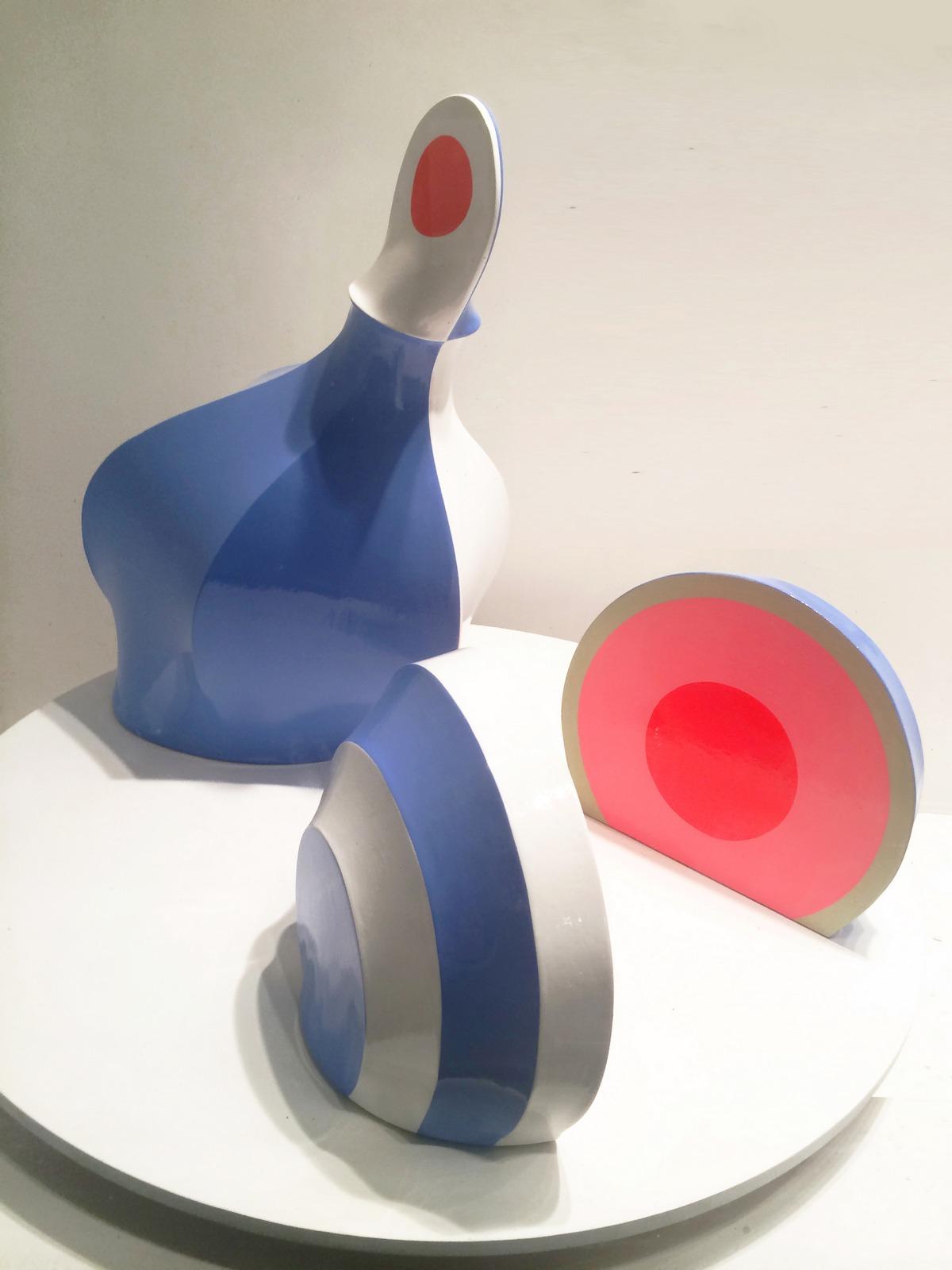
LandEscape meets George Goodridge

Visual artist George Goodridge's work rejects any conventional classification and walks the thin line between figurative and non-representational blurring the boundaries between sculpture, painting, architecture and installation. His hybrid practice accomplishes the difficult task of challenging the relationship between the viewers' perceptual parameters and their cultural substratum to induce them to elaborate personal associations, offering them a multilayered aesthetic experience. One of the most impressive aspects of Goodridge's work is the way it accomplishes a successful attempt to inquire into the notions of diversity and identity, questioning the relationship between significant parings and their attraction and discordance rather than perceived correctness. We are very pleased to introduce our readers to his multifaceted and stimulating artistic production.
Hello George and welcome to LandEscape: before starting to elaborate about your artistic production would you like to tell us something about your background? You have a solid background after transferring from the prestigious School of the Art Institute of Chicago to the School of Visual Arts, New York. How do these experience influence your evolution as an artist? And in particular, how does your cultural
scape Land CONTEMPORARY ART REVIEW
An interview by Katherine Williams, curator and Josh Ryder, curator landescape@europe.com

scape Land CONTEMPORARY ART REVIEW
Diverse Objects Liaise #1, 2013

Acrylic on stretched canvas
Dimensions Variable, 28"h. x 94"w. x 48"d

Vertebrate Companions #19, 2010-2016 oil on stretched canvas, wood armature
Dimensions Variable, 84”h. x 54”w. x 6”d. as shown
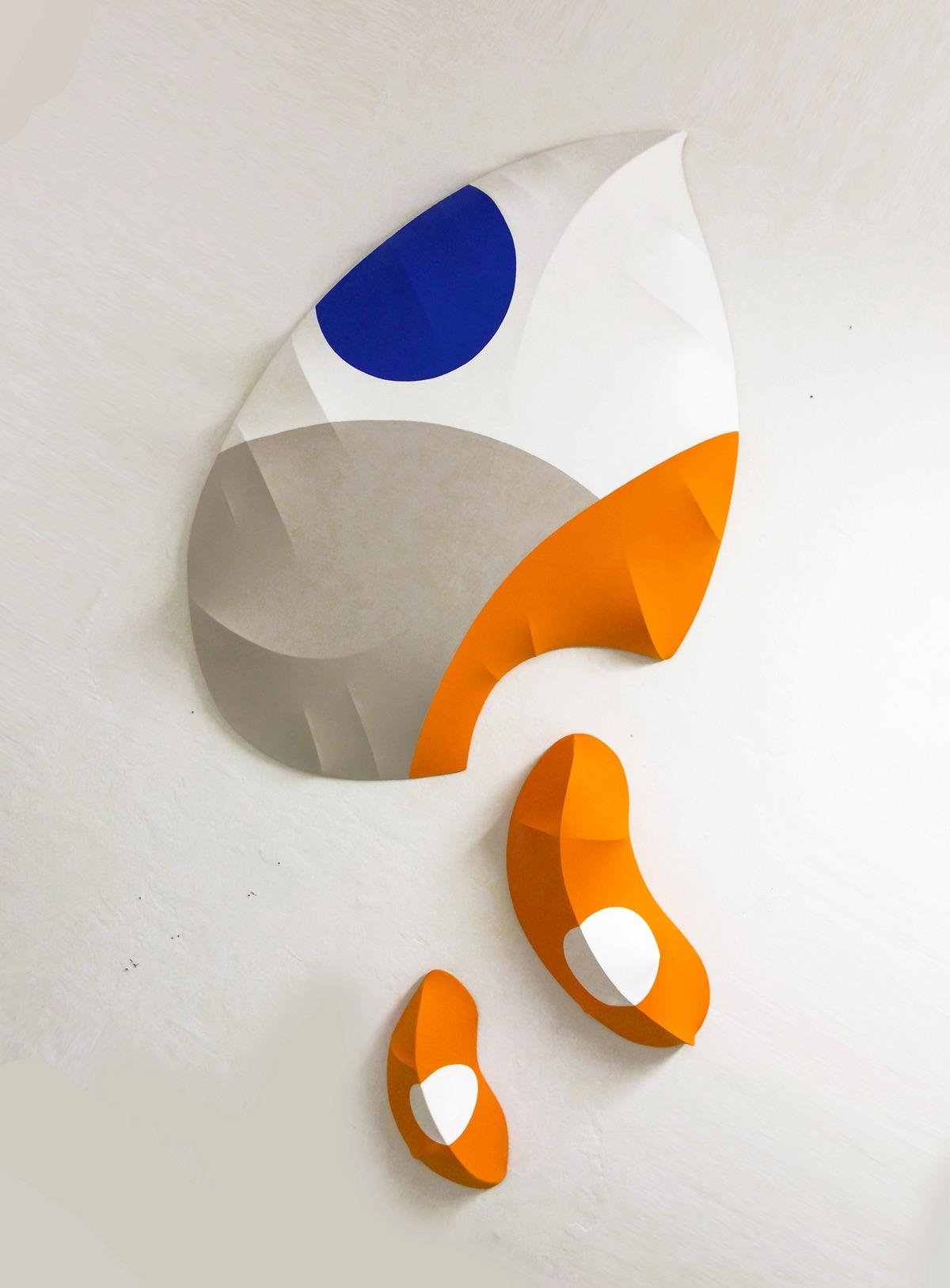
substratum inform the way you relate yourself to art making and to the aesthetic problem in general?
The Art Institute of Chicago's undergraduate program was designed not so much for the creation of finished works as it was designed to develop the students thinking process. Heavily weighted in the Bauhaus tradition with particular attention to grids and systems, studies were made in conceptual thinking, pre-computer design methodologies developed at the Illinois Institute of Technology and color theory based on Joseph Albers, The Interaction of Color. I also studies scientific illustration with a professor from the Field Museum of Natural History. These studies were made with no particular signature aesthetic involved. They were more about pure problem-solving and learning to render images with exactness. This began to formalized my preproduction process for communicating ideas but also instilled in me a critical eye in regards to the quality and archival aspects of images and objects.
Transferring to the School of Visual Arts in NY, works that were spontaneous and quirky were in fashion and the fine arts world was booming. Warhol, Basquiat, Schnabel, Herring and others were being recognized. I lived in the East Village and also took up residence at the Chelsea Hotel for a time which was a mecca for
artists. The rawness of my surroundings inspired burgeoning risk taking and a new visceral boldness began to appeared in my work. I began to create using irregular formatting, employed various mixed medias, color Xerox and hung a rusted skeleton of a mattress on my wall in the Dada tradition. Courses were taken in various fine art disciplines, media arts and film animation. These varied experiences opened my eyes to multifaceted visual explorations and I became untampered by stringent rules and singular production methods.
You are a versatile artist and the results of your artistic research convey together a coherent sense of unity, that rejects any conventional classification. Before starting to elaborate about your production, we would suggest to our readers to visit http://www.georgegoodridge.com in order to get a synoptic view of your multifaceted artistic production. You draw a lot from elements belonging to universal imagery and works that stimulate the viewer’s psyche and consequently works on both a subconscious and a conscious level. How did you decide to focus on such crossdisciplinary approach? And in particular, do you conceive this in an instinctive way or do you rather structure your process in order to reach the right balance?
The goal has always been to create works containing open ended idealisms and concepts that transcend linguistics with clues to the figurative while initially appearing non-representational. I
George Goodridge scape Land CONTEMPORARY ART REVIEW
instinctively gravitate towards invention rather than appropriation. As a working process I use a process of clearing the mind of past perceptions and creating from a first instinct to insure invention then formalize for production only. I refer to works created in this manner as having Unconscious Geometry. In some instances I will create a nonfigurative object blindly that on a subconscious level may represents something worldly or somewhat figurative. At that point I arrive at an idea to confront. Then again, there are times when I have a concept in mind and I create sketches for forms that I am not familiar with that I must adapted to communicate.
Concerning a production approach, my current discipline of stretched canvas over armatures has proven to be more versatile than expected. These current works are not only very light in weight but also provide me with a way to produce objects of considerable size rather quickly. This process is always full of surprises. I do have an intuitive vision of how the finished objects will appear but there are always the unexpected nuances once the armatures are skinned and painted. At times these works even take on a life that is separate from my own which makes them exciting to produce.
For this special edition of LandEscape we have selected The Wondergarden Series, an interesting project that our readers have already started to get to know in the introductory pages of this article. What has at once captured our attention of your captivating investigation about the notion of landscape is

scape Land CONTEMPORARY ART REVIEW
George Goodridge
Study #3 for Wondergarden, Elusive Targets, 2014 acrylic on marine epoxy treated stretched canvas, avia
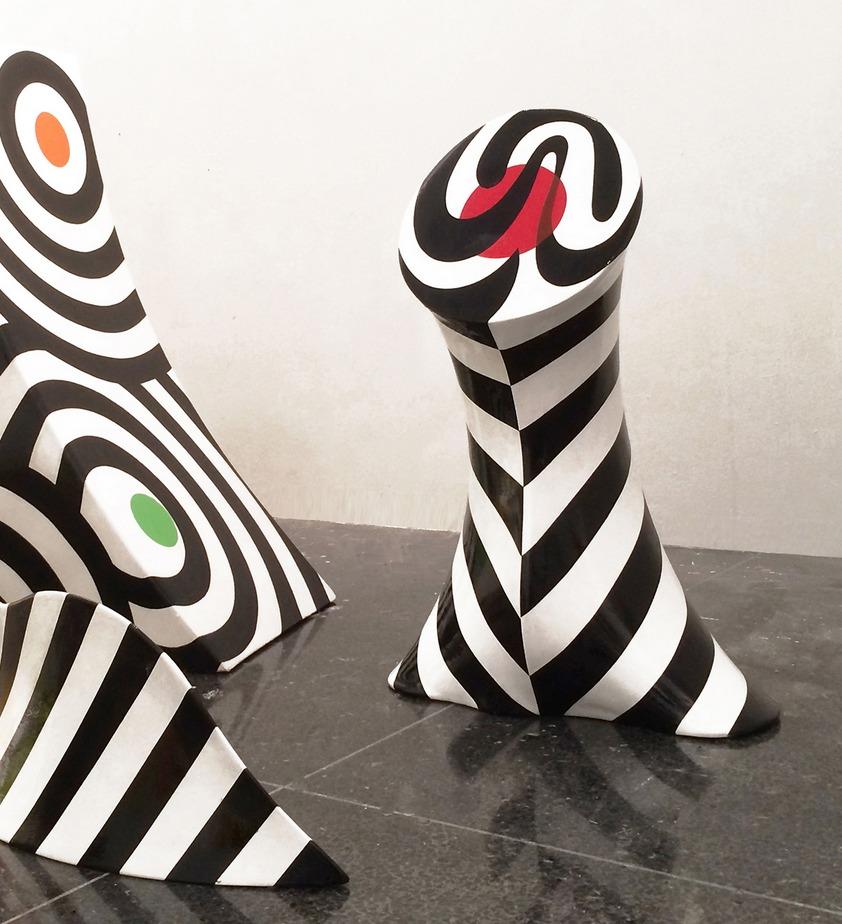
scape Land CONTEMPORARY ART REVIEW
George Goodridge
tion grade clear-coat, wood armature, dimensions variable, 32”h x 40”w x 40”d as shown
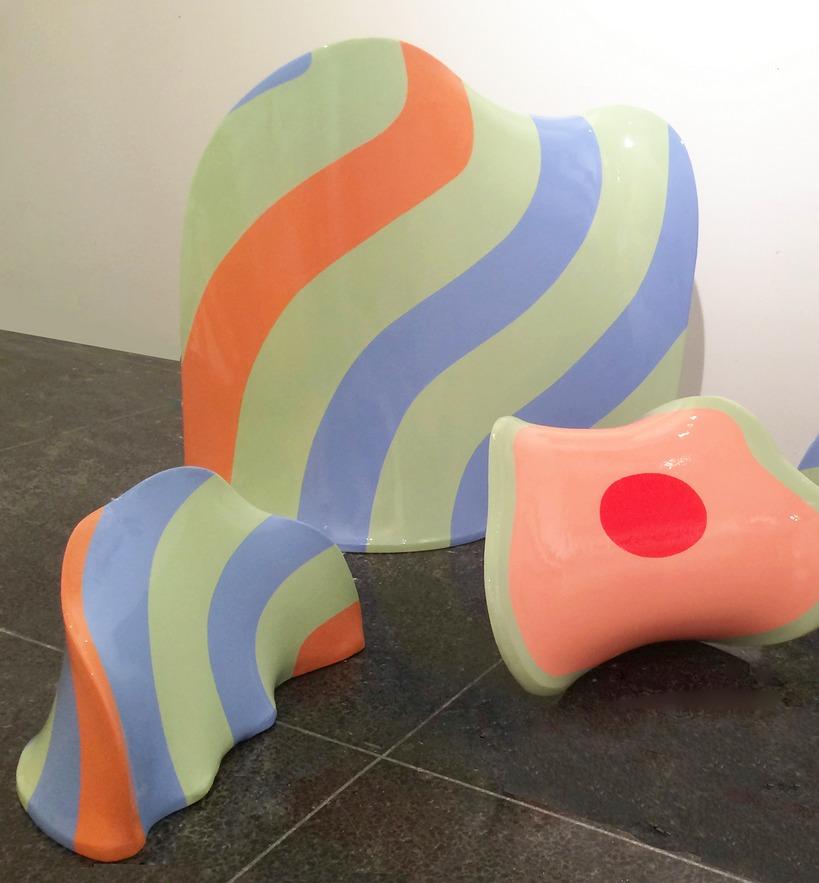
scape Land CONTEMPORARY ART REVIEW
George Goodridge
acrylic on marine epoxy treated stretched canvas, aviation grade clear-coat, wood armature, dimensions va
Study #6 for Wondergarden, Yum, 2014
the way you provided the visual results of your analysis with autonomous aesthetics: while walking our readers through the genesis of The Wondergarden Series, would you like to tell us something about your usual process and set up?
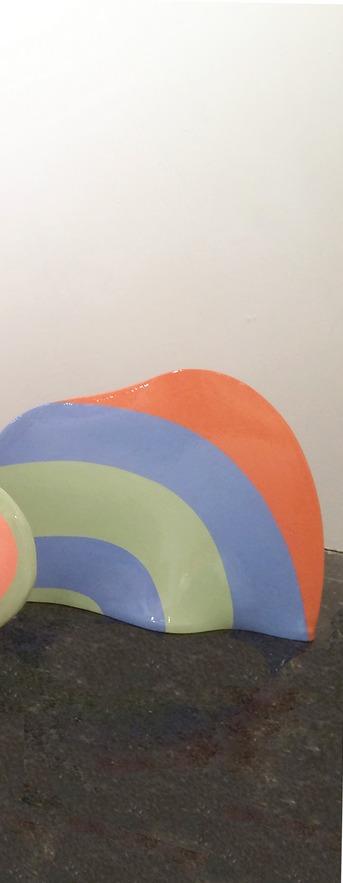
The set up for these stretched canvas works is more or less the same as all my works wherein I initially create from a first notion and formalize form and color for production only. These works being freestanding and made for exterior display have additional production details that had to be solved. I have begun treating the canvas with marine resins and top coating with an aviation grade clear-coat for weather resistance.
Conceptually the Wondergarden is a special project targeting worldly concerns with a somewhat more narrative approach. I have confronted concerns with privacy in regards to electronic media, ecology, business practices, conquest, physical attraction and other personal behaviors. These works also encourage viewers to interact by placing objects as they please which obviously renders varied results. Select pieces also tend to possess biomorphic and at times anthropomorphic forms with characters like qualities.
Your exploration of the notion of landscape as a terrain that can be geographical but also a terrain that can be about memory or nostalgia accomplishes an effective investigation about the relationship between perception, memory and personal imagination, to challenge the viewers' parameters. What is the role of memory in your work? We are particularly
scape Land CONTEMPORARY ART REVIEW
George Goodridge
riable, 25”h. x 48”w. x 26”d. as shown
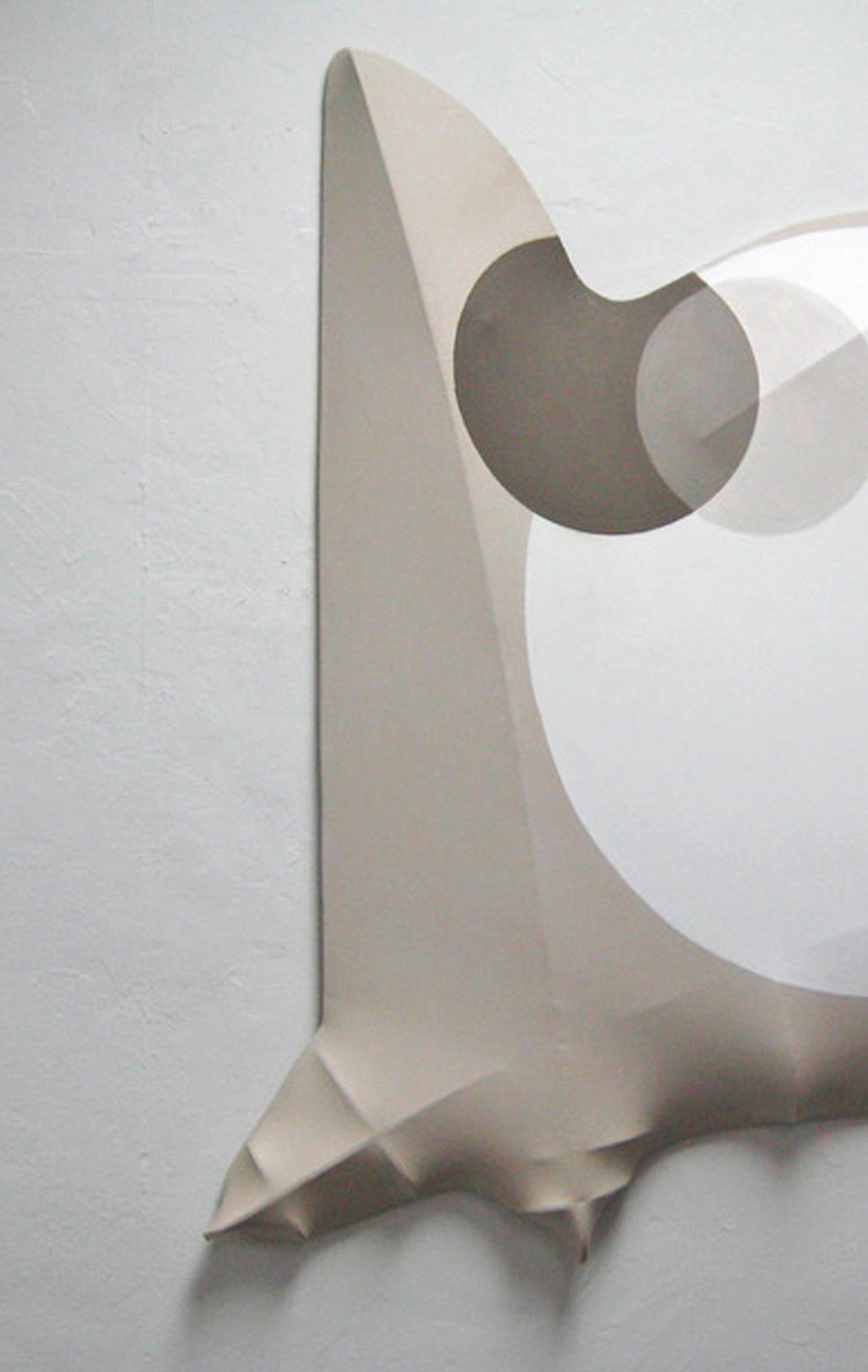
Vertebrate Companions #15, 2010 oil on stretched canvas, wood armature, Dimensions Variable, 48”w. x 48”h. x 3-3/4”d. as shown

interested in how you consider memory and its evocative role in showing an alternative way to escape and overcome the recurrent reality.
If I use memory it is in many cases by default. Obviously memory can't be entirely excluded from ones thought process especially when crossing the line between figurative and the non-representational therefore memory does come into play when I make color choices. For example, greens and tans are generally more pastoral, oranges and reds are more signaling and so forth. These iconic color choices do help to communicate to the audience on a broader more understandable level. As far as overcoming or escaping a recurrent reality, I struggle to come up with forms that I am not consciously familiar with. Even in instances where a simple geometric form may be the most communicative, I modify it to add a foreign quality.
The elements of The Wondergarden Series are both free standing and wall mounted. You often allow an open reading, a great multiplicity of meanings: associative possibilities seems to play a crucial role in your pieces. How important is this degree of openness?
The degree of openness is of most importance. All my works invite diverse translations, physical configurations and none are considered conclusive. I create multi object works that the viewer can question and even at times manipulate. All of my works have variable dimensions and can be arranged in countless ways which

scape Land CONTEMPORARY ART REVIEW
George Goodridge
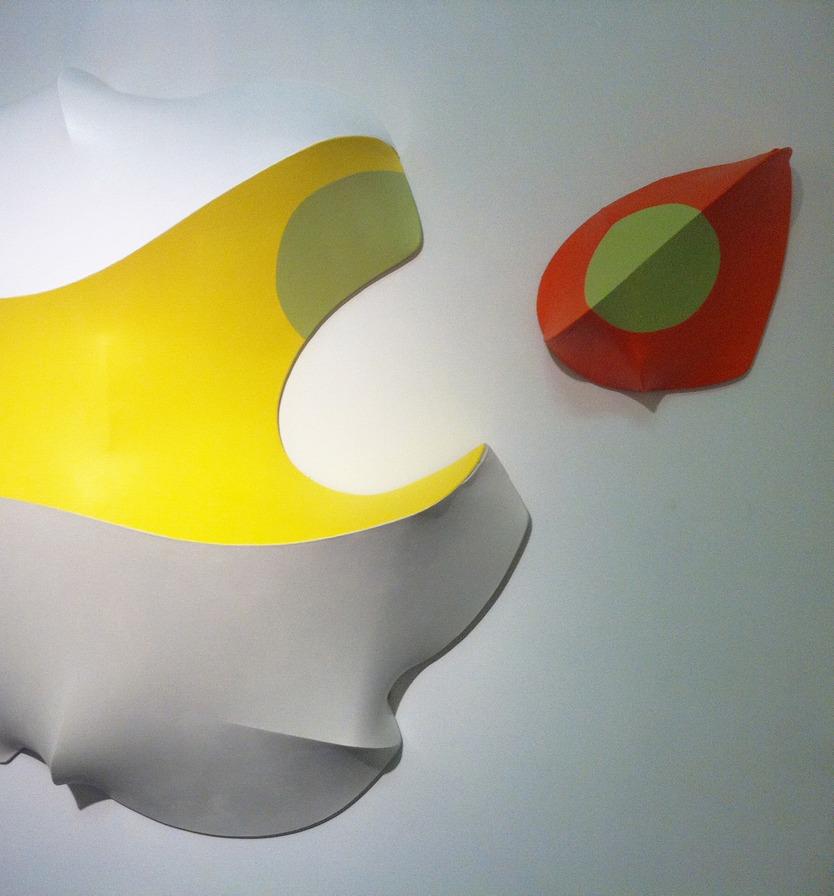
scape Land CONTEMPORARY ART REVIEW
George Goodridge
Vertebrate Companions #28, 2012 Acrylic on stretched canvas, wood armature, Dimensions Variable, 48”w. x 68”h. x 9”d. as shown

George Goodridge scape Land CONTEMPORARY ART REVIEW
Vertebrate Companions #31, Acrylic on stretched canvas, wood armature, 2012, Dimensions Variable, 84
allows for varied outcomes. Think of these installations as as a type of board game which creates various tensions where the negative space and direction of the pieces can change the meanings of the work significantly. From a figurative point of view placements of the objects can change ones perception from the appearance of defined grouping with with diverse parts to the appearance of separate competing objects with singular purposes. Any of the pieces can be arranged according to what we perceive as balanced or correct or as disassociated or incorrect without jeopardizing the premise of the works. I have been personally intrigued with many of the more uncomfortable pairings.
Your inquiry into the expressive potential of different techniques probes the capability of a medium to explore a variety of constructed realities: while questioning about the disconnect between physical experience and the immateriality, you seem to refer to the necessity of going beyond symbolic strategies to examine the relationship between reality and perception, but that we should focus on the nature of the medium in order to understand the way it offers a translation of reality. Do you agree with this analysis? Moreover, I would take this occasion to ask you if in your opinion, personal experience is absolutely indispensable as part of the creative process? Do you think that a creative process could be disconnected from direct experience?
I agree to your point, however as my body of work evolves it is becoming less about

scape Land CONTEMPORARY ART REVIEW ”w. x 66”h. x 9”d. as shown.
George Goodridge
the necessity to understand the processes and techniques used to create these unique realities. Every medium obviously has it's limitations and strengths. If the discipline has a duel fold purpose which aggregates an idea, not just object making, it is most successful. In many cases a process or technique become no more than a safe convenience once one becomes accustomed to that production skill set. I do agree that a unique process or technique can become part of ones personal aesthetic that ignites the initial allure, wonder and such however in many cases artists produced works that are nothing more than processes based objects that illustrate rather than confront or question. We have evolved whereas something more is needed to be said. Especially in my Wondergarden and earlier Vertebrate Companion Series I believe that the process adheres to their concepts. The notion to create organic objects with biomorphic and at times anthropomorphic qualities from bone to skin I believe to be relevant.
As far as personal experience being necessary in a creative process I would have to also agree, but to what extent? How do we define person experience? I can climb a mountain and reach the summit or watch a documentary. I could read someone's embellished account of their climb or study a climbers log and develop my own personal notions which
can be both emotional or simply be exposed to informative data. With the advent of the internet, information is available of every kind. These are all personal experiences which we take with us that can foster ideas with sound foundations.
Another interesting project of yours that has particularly impressed us and on which we would like to spend some words is the VERTEBRATE COMPANIONS SERIES: the way you to capture non-sharpness with an universal kind of language quality marks out a considerable part of your production, that are in a certain sense representative of the relationship between emotion and memory. How would you define the relationship between real and unreal, between abstraction and representation in your practice? In particular, how do figurative and a tendency towards abstraction find their balance in your work?
The works appear unreal until ones personal perceptions are realized. The mere fact that the work exists makes them real. Because they are initiated through a visceral nearly thoughtless process, emotion is initially at play while memory ideally is not. Any figurative notions in the beginning stages of production are in a way abstractions without an initial image to abstract. I must say that I always seek invention rather than appropriation. At the point of conception forms are quite unreal and non-representational without binding
George Goodridge scape Land CONTEMPORARY ART REVIEW
Study #1 for Wondergarden, Paradise Changed, 2014 acrylic on marine epoxy treated stretched canvas, aviation grade clear-coat, wood armature, dimensions variable, 60”h x 60”w x 60”d as shown
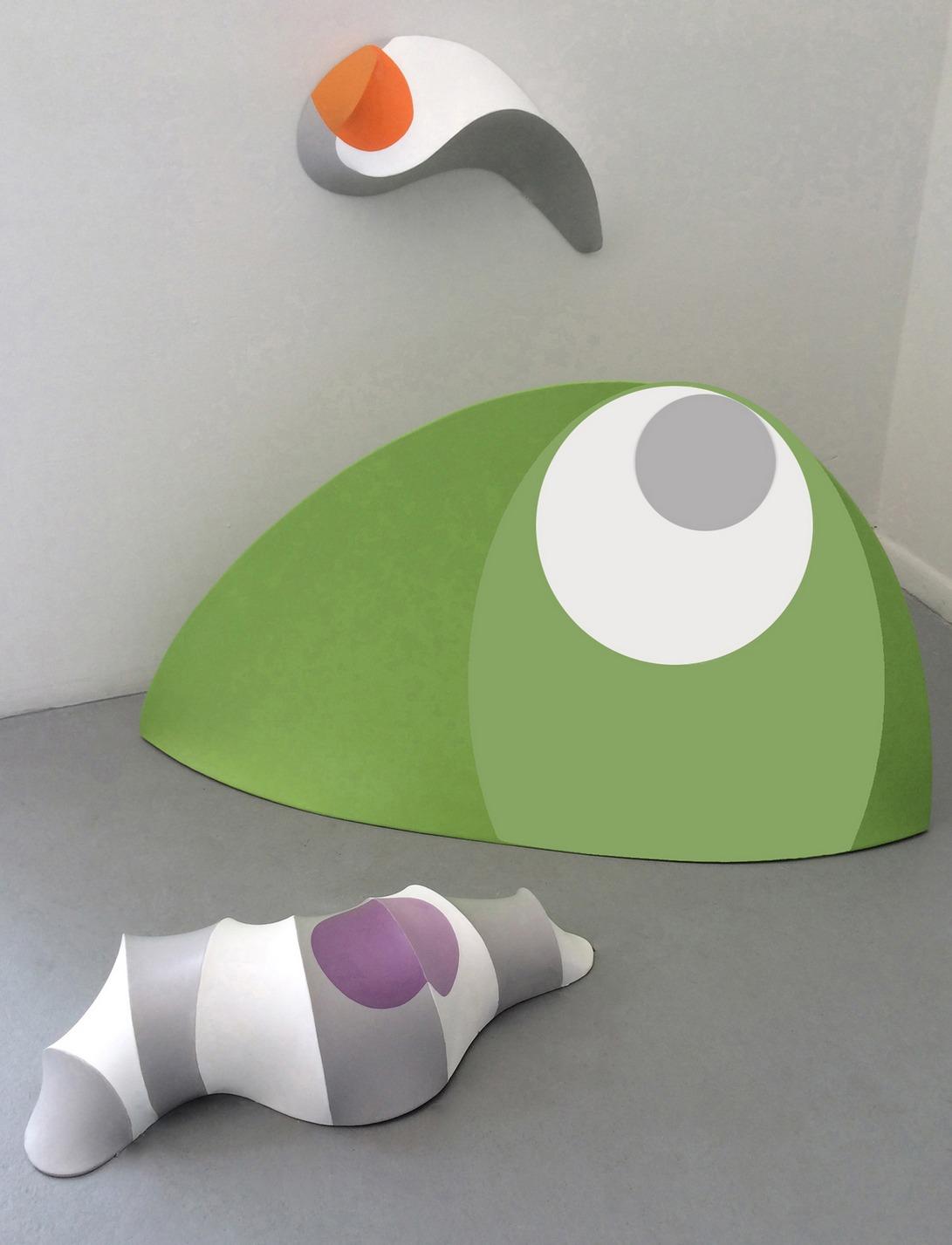
Vertebrate Companions #26, 2012
Acrylic on stretched canvas, wood armature, dimensions Variable, 66”w. x 48”h. x 9”d. as shown

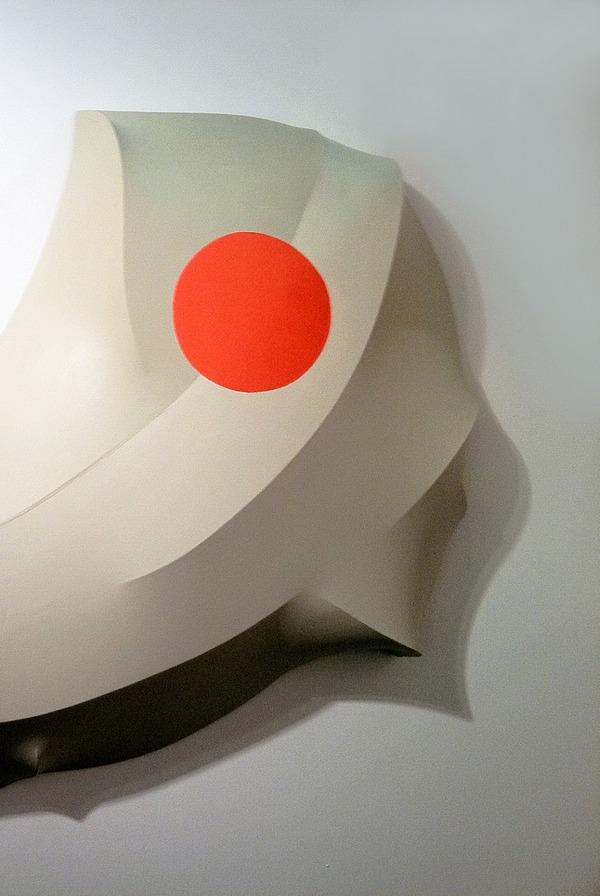
Vertebrate Companions #21
2010-2016, oil on stretched canvas, wood armature, Dimensions Variable, 84”h. x 54”w. x 6”d. as shown

alliances towards one another. Formalizing for production is where the process delves toward the somewhat figurative or representational aspects of my work. Only then are possible familiarities to suggest the figurative and representational explored.
We would like to pose some questions about the balance established by the colors you combine and that accomplish the difficult task of establishing tension and a provocative dynamic. We have really appreciated the vibrancy of thoughtful nuances that saturate your pieces and especially the way they suggest an augmented idea of plasticity. How did you come about settling on your color palette? And how much does your own psychological make-up determine the nuances of tones and the materials you decide to use in a piece and in particular, how do you develop your textures?
I do brood over color and textural choices and almost never use out of the tube color even for whites. I appreciate understatement, elegance and subtlety which while using brights can be a challenge. Hues, various values of secondary colors and direct or modified complimentary colors are generally a starting point. When choosing brights I tend to add either umbers, grays and whites which removes the garish quality from my pallet. This process insures the brights to appear vibrant in relation to
each other but with with an added subtlety, richness and depth. I also very much approve of monochromatic works with jewel-like color fields accents. Many of my current works employ resins and clear-coat finishes as well. These exponentially tone down or add significant depth through choices of high gloss to matte.
You have also has taught Visual Techniques at the School of Visual Arts in New York: how did this experience affect your work? In particular did you ever draw inspiration from your students' ideas?
I have taught Visual Techniques, a course for 1st and 2nd year students. The course entailed teaching new students image making and how to use various media tool such as large format stat cameras, 35mm film cameras, copy stands, typographers and a variety of other graphic arts tools and materials for producing works for use in the print and printing industry. I was also a staff member in SVA's Media Workshop where I mentored students with similar needs. There was always an outstanding student which on a somewhat regular basis exhibited exemplary work but as far as being significantly influenced myself, what they considered mistakes were of the most influence. Often times a student would approach me saying "this just didn't work and how can I fix this". On
George Goodridge scape Land CONTEMPORARY ART REVIEW
Vertebrate Companions #20, 2011

Oil / stretched canvas
Dimensions variable, 54”h x 26”w x 6”d as shown
many occasions I saw images or techniques that I hadn't imagined. As the result there were often discussions on what is referred to as incidental art and how a mistake can open ones eyes to various new ways to manipulate or even producing imagery. The trick became remembering what you did initially and how to control or produce the same variation again.
Over these years your work has been represented in numerous galleries, museums, and corporate collections, including your recent exhibition Trippin’ at the Laundromat Art Space, in Miami. One of the hallmarks of your work is the capability to create direct involvement with the viewers, who are urged to evolve from a condition of mere spectatorship. So before leaving this conversation we would like to pose a question about the nature of the relationship of your art with your audience. Do you consider the issue of audience reception as being a crucial component of your decision-making process, in terms of what type of language is used in a particular context?
The audience is always of a concern and I occasionally ask for their participation. Once again with the dimensions variable idea in play installation perceptions can and will change depending on the site specific perimeters. I have in the past had work installed without sending templates for installation whether it be a wall installation or freestanding works. I have relied on the curator or the
installer to join in the creative task. These works are about object to object relationships with various translations after all. This passing of the torch which makes additional persons participants in the artwork introduced me to ideas I may never have thought of or wouldn't have bothered to explore. After a sale or exhibition when I didn't send installation templates, I always ask for the collector or venue to send a photo of the works once installed. I'm almost always surprised at their decision and how their involvement changed the work. I have had explosively positive even joyful reactions from all those involved in most cases.
Thanks a lot for your time and for sharing your thoughts, George. Finally, would you like to tell us readers something about your future projects? How do you see your work evolving?
I see my work evolving as a natural progression influenced by my larger public artworks and my recent works on paper. I will also be stepping away from minimalism somewhat and working with visual kinetics which have begun to appear in my embossed serigraphs while increasing the works complexities both conceptually and physically.
An interview by Katherine Williams, curator and Josh Ryder, curator landescape@europe.com
George Goodridge scape Land CONTEMPORARY ART REVIEW
Lior Herchkovitz
For over more than a decade Herchkovitz's subject matters are
varied, but the essence is the same. Whether his themes come in a series or tableaux, he works with clear intention to examine the complex of human condition; man's interference with nature and the vulnerability of mankind.
Much of Lior Herchkovitz's work reminiscent of film stills and conditioned by the simultaneous emphasis on narrative structure, photographic sequences and on themes, while in other works is tackling the relationship of photography to painting.
Herchkovitz is less concerned with beauty as commonly
perceived, but rather fascinated by a perceptible discrepancy between the visible surface and the psychological content, presented subtly that no information gets lost, and thus lends some of these works an ambivalent atmosphere followed with tension and unease.
Lior Herchkovitz was born and raised in Tel Aviv, Israel. Educated at The Royal Academy of Fine Art, in The Hague The Netherlands; majored in Photography BFA degree. He has exhibited worldwide, his Work appear in Art collections, various Art books and magazines around the world.
An artist's statement
scape Land CONTEMPORARY ART REVIEW
Lives and works in Tel Aviv, Israel
Lior Herchkovitz

Theatre Entrance Hall, House of Officers, Wünsdorf-Waldstadt, Germany 2015
LandEscape meets
Lior Herchkovitz
Exploring the expressive potential of a wide variety of techniques and materials, artist Lior Herchkovitz's work explores perceptible discrepancy between the visible surface and the psychological content and considers the vital relationship between direct experience and visual intepretation, to draw the viewers through a multilayered journey. In his Evidence of Our Existence that we'll be discussing in the following pages he challenges the viewers to trigger their perceptual parameters. One of the most impressive aspects of Herchkovitz's work is the way it accomplishes the difficult task of investigating about man's interference with nature and the vulnerability of mankind: we are very pleased to introduce our readers to his stimulating and multifaceted artistic production.
Hello Lior and welcome to LandEscape: we would start this interview with a couple of questions about your multifaceted
background. You have a solid formal training and you majored in Photography with a BFA degree, that you received from The Royal Academy of Fine Art, in The Hague The Netherlands: how do these experience influence the way you currently conceive and produce your works? And in particular, how does your cultural substratum inform the way you relate yourself to art making?
Since early age, I liked to watch how my father was placing carefully pictures in our family album. He used to do it at weekends and it had a kind of ceremonial sphere to it, almost magical. I guess it influenced me in some way or another. I remember that he took many photographs, but they were always intended to be straightforward. Mine were never straightforward. Later in life, I became interested in diverse forms of creative expression such as painting, music, poem and film. The Dutch and Flemish painting, in particular, were much of an influence on me. These influences actually brought me to the decision of studying in The Netherlands. To begin with, I went there to study photography. It was always my passion. We had painting lessons too. But I was very poor in
scape Land CONTEMPORARY ART REVIEW
An interview by Katherine Williams, curator and Josh Ryder, curator landescape@europe.com

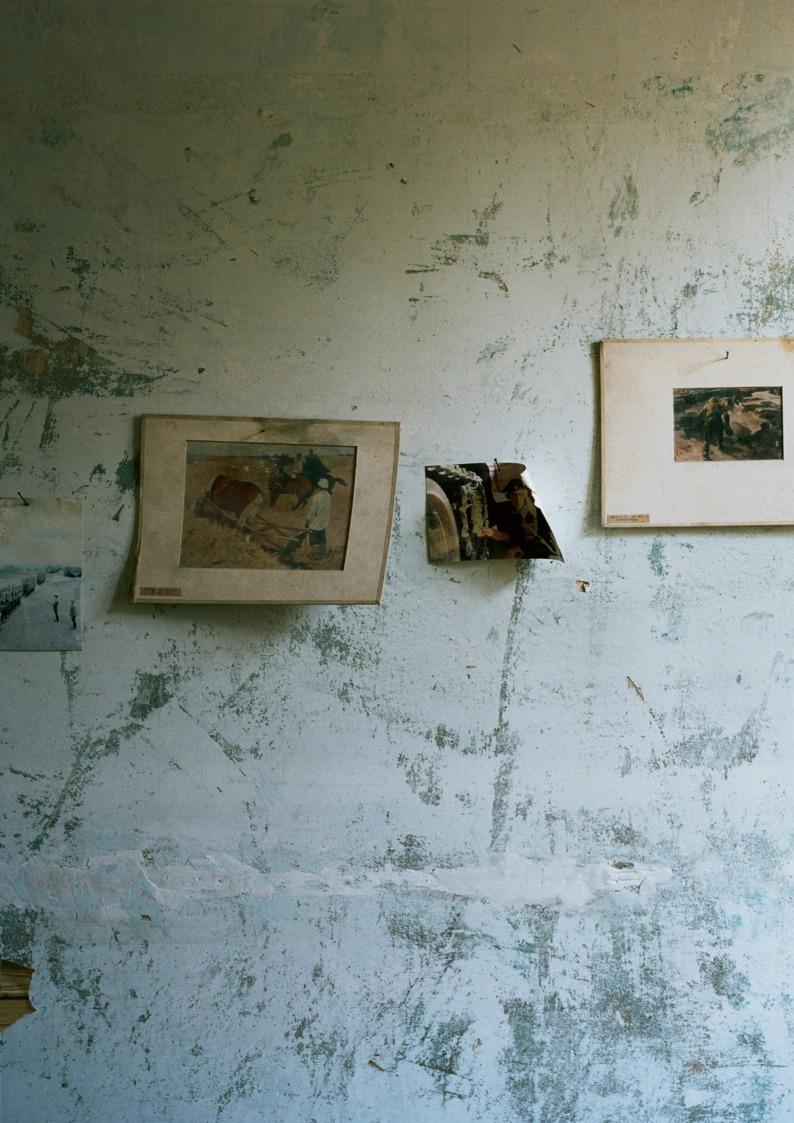 Room II, House of Officers, Wünsdorf-Waldstadt, Germany 2015
Room II, House of Officers, Wünsdorf-Waldstadt, Germany 2015
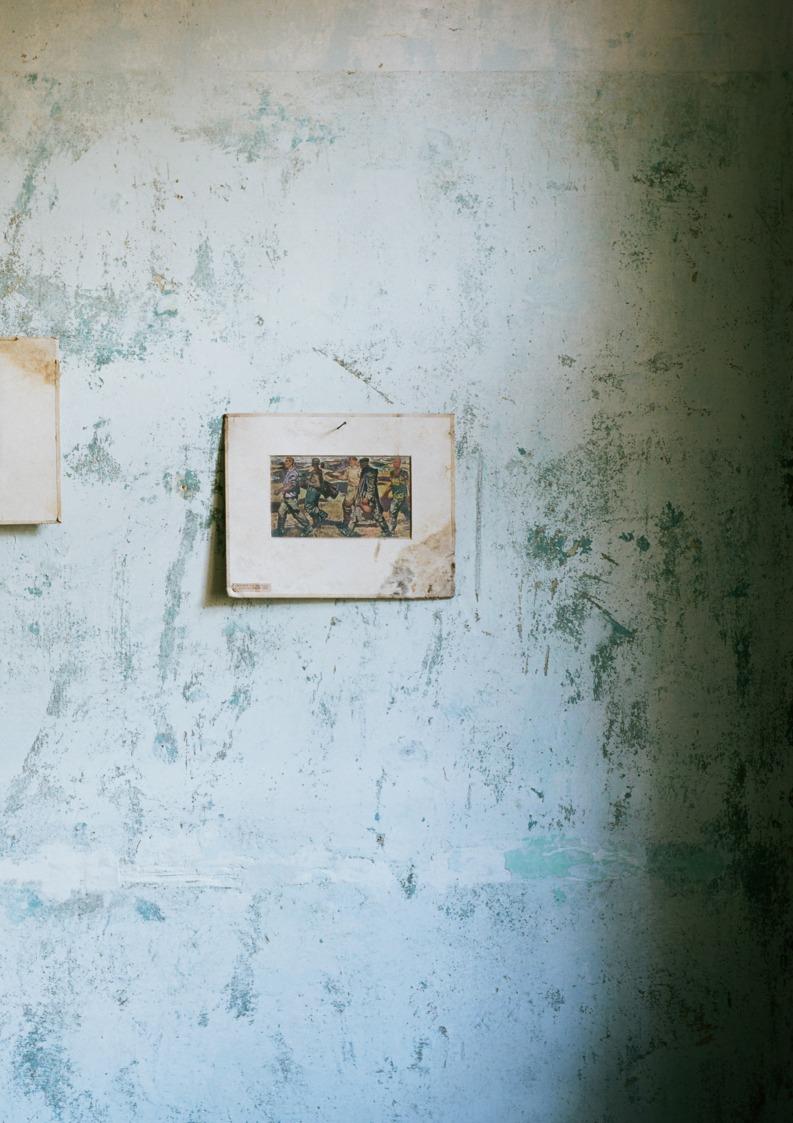
painting. In spite of that, it was a great opportunity to learn light, shadow and color compositions out of old masters and very tempting to bring it into the photographic image. When I came out from the academy, I realized that if you seek personal expression in photography, you will soon become aware of limitation. The medium I practice reflects the infinite variety of subject matter offered by the natural universe. But the range of vision is extremely narrow. I became aware that I must confine myself to my own peculiar obsessions and types of images which can express character and feelings. Having said that, I do not disavow my photographs, but rather think that the medium I chose proved to be my best and most original medium of expression that becomes important to me more and more.
I am influenced often by historical materials and artists of the past. It informs the way I currently conceive my work, but the photograph is formed in the process of work. As an artist, the interaction between man and nature is an important aspect to me. I am looking at how we are, what our common conditions are and how we define our existence in this world.
Over these years you have experimented with a wide variety of different techniques. The figurative language you convey in your pieces is the result of a constant evolution of your searching for new means to express the ideas you explore in your works: your inquiry into the expressive potential of colors combines together figurative as subtle abstract feature into a coherent balance. We would suggest to our readers to visit

Herchkovitz scape Land CONTEMPORARY ART REVIEW
Lior

Lior Herchkovitz scape Land CONTEMPORARY ART REVIEW
Room I, House of Officers, Wünsdorf-Waldstadt, Germany
2015

Lior Herchkovitz scape Land CONTEMPORARY ART REVIEW
Cinema Hall, House of Officers, Wünsdorf-Waldstadt, Germany 2015
http://liorherchkovitz.com in order to get a synoptic view of your work: in the meanwhile, would you like to tell to our readers something about the evolution of your style? In particular, would you shed light on your usual process and set up?
In the past, I used to plan to the utmost degree, especially when practicing in the field of staged photography. I would begin with an idea, develop a storyboard and later scout for location and characters. In recent years, I learned to embrace the notion of not knowing at the beginning. This way of working increases a sense of freedom. It begins with an impulse or in other words, out of an urge to redefine the strong complex visual relationships that goes beyond words, between man and his environment. When certain emotion keep on repeating, I simply react to it. I work very intuitively and try to see what affects me in the place, rather than documenting what a place is.
For this special edition of LandEscape we have selected Evidence of Our Existence, an extremely interesting project that reflects the multifaceted nature of our relationship to nature and that our readers have already started to get to know in the introductory pages of this article. When walking our readers through the genesis of Evidence of Our Existence would you shed a light about your usual set up and process?
When embarking on a new project, I begin to collect materials, travel in order to get familiar with the surrounding. Looking back, I may say that Evidence of Our Existence began 10 years ago during another project,

CONTEMPORARY ART REVIEW
Lior Herchkovitz scape Land
which I was working on and is entitled Night. Both projects are linked in a sense that I have always been keen on portraying man through the things he leaves behind. All photographs depict no people within the environment. In other words, a world before and after. Both of series portray this in quite a poignant way. The sense of abandonment intensifies in Evidence of Our Existence.
Some of the images shown here were done in Wünsdorf-Waldstadt, Germany. A city, which is situated 40 km from Berlin. It was the biggest Soviet army base in East Europe during the cold war and was known as Little Moscow. To the locals it was “The Forbidden City”. The East Germans weren’t allowed to enter. I witnessed a place that was forgotten, and yet replete with things testifying to the fact that people, mostly Soviet officers and their families had lived there. The series is a timely reminder of both human intervention and human absence. There is a theatre entrance hall, cinema, swimming pools, and paint peeling off walls in spaces long abandoned.
As I mentioned before, I tend to go back to historical materials. It gives me some reference about the past and how it relates to the present; determining time complexity. In contrast to that, the image entitled ‘Rehearsal Room (HabimaNational Theatre of Israel)’ was photographed while actors adjourned for one hour break. With this in mind, what is left behind often tells us more about ourselves.
The ambience you captured in Evidence of Our Existence reminds us of the notion of non-lieu elaborated

Land CONTEMPORARY ART REVIEW
Lior Herchkovitz scape

Lior Herchkovitz scape Land CONTEMPORARY ART REVIEW
Rehearsal Room, Habima - National Theatre of Israel 2006
by French anthropologist Marc
Augé and establishe a channel of communication between the conscious level and the subconscious sphere: artists are always interested in probing to see what is beneath the surface: maybe one of the roles of an artist could be to reveal unexpected sides of
Nature, especially of our inner Nature... what's your view about this? In particular, do you think that your works could induce a process of self-reflection in the viewers?
It does remind in a subtle way the Notion of non-lieu by Marc Augé.

scape Land CONTEMPORARY ART REVIEW
Lior Herchkovitz
Liquid Night I, 2015
Nevertheless, in my mind, the lieu de mémoire by the historian Pierre Nora indicates one of the subject matters that I am interested in, much more clearly. It signifies memory and in particular, collective memory. According to lieu de mémoire the cultural landmarks, places, practices and expressions stemming
from a shared past, whether material such as monuments or intangible as language and traditions. It may refer to any place, object or concept vested with historical significance in the popular collective memory. It may be an event or a symbol for instance - a red flag.
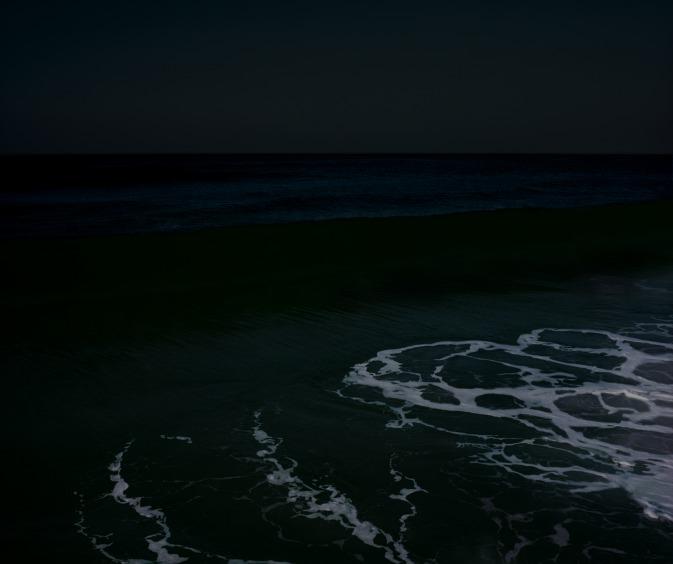
Lior Herchkovitz scape Land CONTEMPORARY ART REVIEW
Liquid Night II, 2016
Indeed, both of ideas deal with communication between consciousness and the subconscious. My role as an artist is to focus deep into these sources of our cultural conditioning, and let ideas and practices to reveal undercurrent tendencies. I do try to
induce a process of self-reflection in the viewer in order to help him unleash his inner nature. What is it basically the inner Nature? It is the life of feeling, and it is much more intimately connected with our inner being than our thought and perception. However, with respect
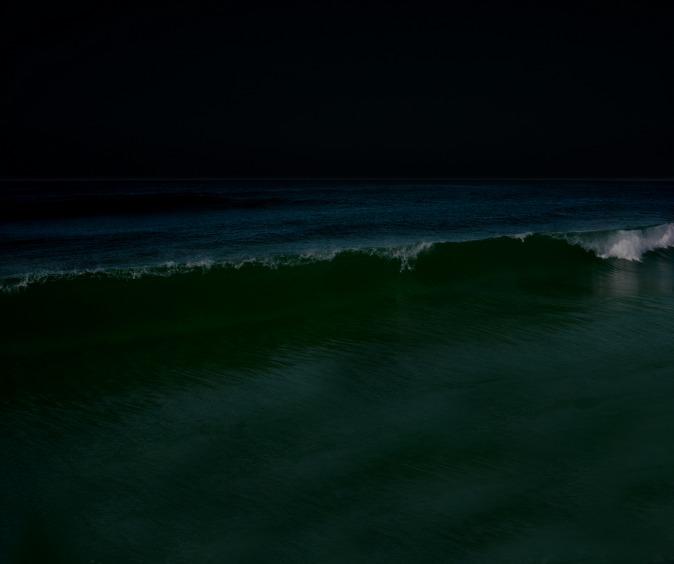
scape Land CONTEMPORARY ART REVIEW
Lior Herchkovitz
Liquid Night V, 2016
to feeling and emotion one has the sensation: within me are endless depths; could I but bring, I can only bring forth the smallest part and transform it into actual feeling. My work has to give all the information but none of the secrets. Not provide answers. I
rather pose questions, which I do not have an answer to. I am reacting to the environment, observing what is in front of me and uses it to create emotion. The narrative is created in the viewer’s mind, but each one of us has his own story, emotion and different capabilities

Lior Herchkovitz scape Land CONTEMPORARY ART REVIEW
Liquid Night VI, 2016
to endure a moment. Your story is true the same as mine.

Liquid Night provides the viewers with an intense, immersive experience and the dualism of things that marks out your artistic research leads you to investigate the social sphere and its condition: how do you see the relationship between public sphere and the role of art in public
space? In particular, how much do you consider the immersive nature of the viewing experience?
Art in public space is one of the last frontiers of free expression and as such, has an important role in society. Without art that is engaged with the society at large, the banality of reality would be intolerable. It strives to deal with key
Lior Herchkovitz scape CONTEMPORARY ART REVIEW Land
Liquid Night VII, 2016
questions and always takes a position. I am creating work for you to react to; trying to provide the viewer an extension of the ordinery human perception and meanings behind the world as we usualy precieve. It is about drawing on a reaction. Whether it is in public space indoors or outdoors, art is entertainment, reaction and experience. That's what all art is about. So, I definitely consider the viewing experience when
having to decide how to display my work in a space. Creating the ultimate viewing experience is always a challenging aspect, because I create within the medium of a still image and I do not sensationalize things but rather searching for a subtle approach.
Elements from environment are particularly recurrent in your
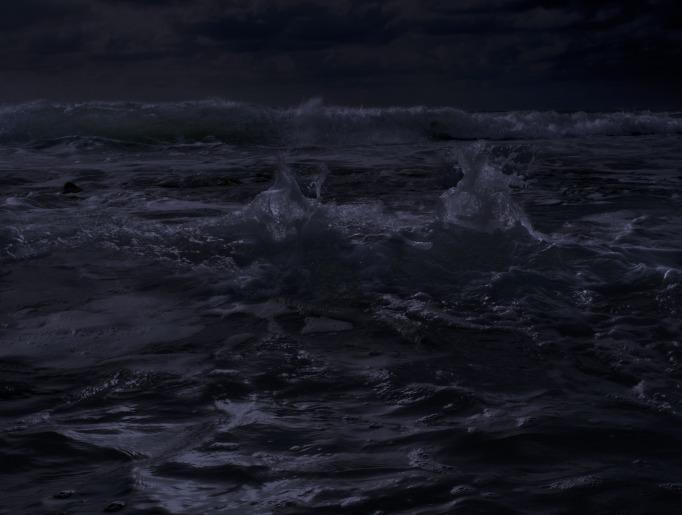
Lior Herchkovitz scape Land CONTEMPORARY ART REVIEW
Liquid Night VIII, 2016
imagery and they never plays the role of a mere background. Do you see a definite relationship between enivironment and your work?
I do not consider my work as environmental or ecological art per se. But I do see a definite connection, since I depict interrelationships within our environment in a way of representation. It
stems from a deep relationship with the surrounding atmosphere, together with close observation on season, light and form as a means to mood and sensation. In another project entitled Seamoods, I pay much of attention to it. The sea and land, and their connection point - the landscape – are supported in human figures, and vice versa.

Lior Herchkovitz scape Land CONTEMPORARY ART REVIEW
Circle, Hilton Beach, Tel Aviv, Israel 2014
Another interesting project of yours that has particularly impressed us and on which we would like to spend some words is entitled Tidal: it is an art project that address the relationship between the visible and invisible and we appreciated the way you have been capable of creating a point of convergence between a kind of imagery belonging to universal

imagery and direct experience. So we would take this occasion to ask you if in your opinion personal experience is an absolutely indespensable part of a creative process... Do you think that a creative process could be disconnected from direct experience?
Any process I begin emarges out of a personal neccesity. It is indeed an
Lior Herchkovitz scape Land CONTEMPORARY ART REVIEW
Fish Boat, Jaffa Port, Tel Aviv - Yafo, Israel 2015
absolutely indespensable part. Therefore, it evolves from direct experience. The Tidal project was done in the same manner. Whether I deal with a landscape or man, in my mind it has no difference, but rather similar feature and aspect. Anywhere we go, we always carry on our personal bag. I have to listen to the child, the son, the father, lover and the artist in me. Without it I can not authenticely create an imagery. It is a second to none.
Tidal also connects the apparent staticity of a visual image, providing the viewers with an intense experience of real-time walking on the thin line that divides figurative to imagination. In particular, how do you view the concepts of the real, the authentic and the imagined playing out within your works?
Tidal is a good example of playing with the imagined. It addresses the relationship between the visible and invisible, the real and unreal, the felt and unfelt motivated forces that surround us. There is no one without the other. It is inseparable. In fact, the images were made by portraying the subject number of times from the same location, in different weather, time, and light conditions by using number of negatives combined and still carrying the primary image remaining under surface. I have created another sea, almost fantastic, almost abstract. I am always trying to understand the individual that I am. Therefore, the relationship between my inner nature and my work creates an authenticity. Producing work, in a way, is connected with the expression of this “inward” voyage. It comes as a sort of
slow boiling up inside until it explodes. Then, there is that one moment that translates itself into a need to be filled with wonder, a need to look with intensity and with courage. Finally, there is that moment of true vision that puts me in to a state of receptivity and allows me to react on it in a form of an image. This trance is only a game that doesn’t last long, however, because life always calls you back to its commands.
It seems like contemporary art practice is about breaking the rules and subverting a wide variety of taxonomies of art: there are no boundaries in it whereas the type of art you’re practicing has very real rules that you have to follow. What are some of the rules that when you sit down and you’re conceiving a new piece that you have to consider when you’re deciding whether or not you’re going to coinceive something?
I take photographs with love, so I try to make them art objects. But I make them for myself first and foremost – that is extremely important. This is my only rule. It has to be an ineresting subject that is meaningful to me.
You have remarked once that you are less concerned with beauty as commonly perceived, but rather fascinated by a perceptible discrepancy between the visible surface and the psychological content: how do you relate yourself to the aesthetic problem in general? What does in your opinion mean the
Lior Herchkovitz scape Land CONTEMPORARY ART REVIEW
notion of aesthetics in our unstable contemporary age?

With regard to aesthetics as an art form, in this current age we have the chance to precieve the unusual, overstated or shocking as well as the sublime. As we
know, art in midieval period or much later on in communism time was used for other perpuses. Now, we might find it to be fascinating, discover new perception. Artists create more complex, intriguing works. We have the opportunity to much wider eastetical experiences then ever
Lior Herchkovitz scape Land CONTEMPORARY ART REVIEW
Water Rings, Mineral Beach, Dead Sea I, Israel 2014
before. However, It can be a very heavy toll too. Concerning photography in particular, happily, man is still the most important part of the picture – making process. On the other hand, this is an idea that is still not well established in people’s minds. They think that, thanks to a great
technology in image making an extraordinary picture will be found every time, but this isn’t so. The best photos, the ones that are remembered, are the ones that first passed through the person’s mind before being restored by the chip.

Lior Herchkovitz scape Land CONTEMPORARY ART REVIEW
Swimmers, Accadia Beach Herzliya, Israel 2014
Over the years you have internationally exhibited and one of the hallmarks of your work is the capability to create a direct involvement with the viewers, who are urged to evolve from a condition of mere spectatorship. So before leaving this conversation we would
like to pose a question about the nature of the relationship of your art with your audience. Do you consider the issue of audience reception as being a crucial component of your decision-making process, in terms of what type of language is used in a particular context?
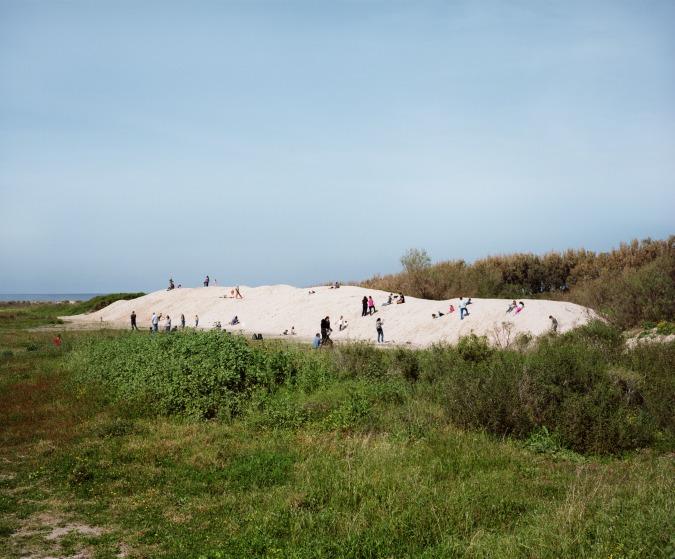
Lior Herchkovitz scape Land CONTEMPORARY ART REVIEW
Sand Hill, Alexander River, Israel 2015
The moment always dictates in my work. What I feel, I do. This is the most important thing for me. Everybody can look, but they don’t necessarily see. I never calculate or consider this issue during the actual process of making art; I see a situation and I know that it’s right. When it comes to desplaying my work, I have to consider the audience, let the viewer who looks at the picture always walk along that visual path
for himself. We must always remember that an image is also made up of the person who looks at it. One must let the viewer extricate himself, free himself for the journey. I offer the seed and then the viewer grows it inside himself.
Thanks a lot for your time and for sharing your thoughts, Lior. Finally, would you like to tell us readers

Lior Herchkovitz scape Land CONTEMPORARY ART REVIEW
Facing East to Pray, Natanya Beach, Natanya, Israel 2015
something about your future projects? How do you see your work evolving?
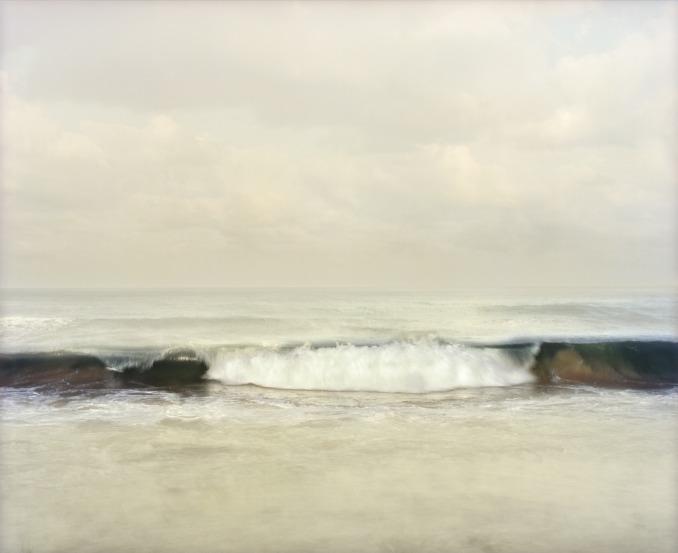
I’ve recently began a new body of work, up in the Swiss Alps, but I can’t tell you about it yet. There’ll be two or three works on display in a future solo exhibition, which will take place a year from now at the MACT & CACT Arte Contemporanea
Ticino, an Art Museum in Bellinzona, Switzerland. Since my first ever project was done, Sixteen years ago, I feel I have something now that may evolve to a first monography.
Lior Herchkovitz scape Land CONTEMPORARY ART REVIEW
Tidal I, 2011
An interview by Katherine Williams, curator and Josh Ryder, curator landescape@europe.com

















 Photo by Darren Fleet
Photo by Darren Fleet
 Photo by Victoria Johnson
Photo by Victoria Johnson






 Photo courtesy of the artist prOphecy sun
Photo courtesy of the artist prOphecy sun


 Photo by Amanda Arcuri
Photo by Amanda Arcuri






 Photo by Amanda Arcuri
Photo by Amanda Arcuri

















 White
White
















































 Linda Persson is a Swedish artist living and working between Sweden and United Kingdom
Linda Persson is a Swedish artist living and working between Sweden and United Kingdom


















































































 Room II, House of Officers, Wünsdorf-Waldstadt, Germany 2015
Room II, House of Officers, Wünsdorf-Waldstadt, Germany 2015



















